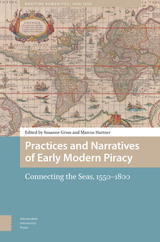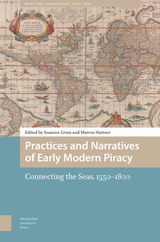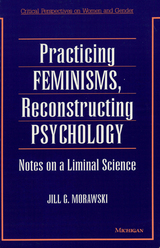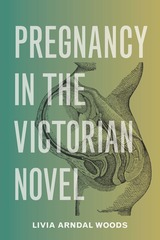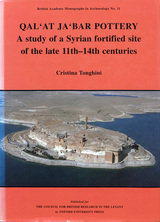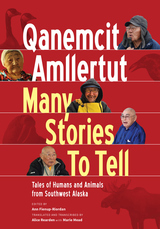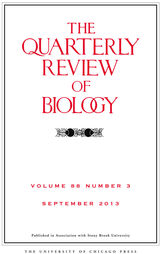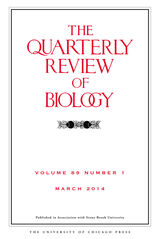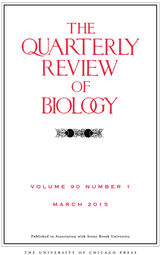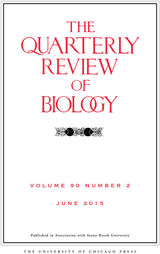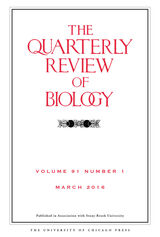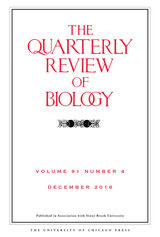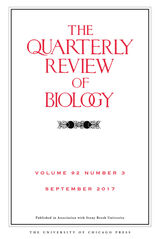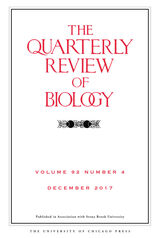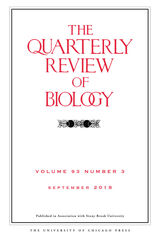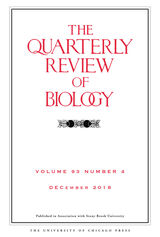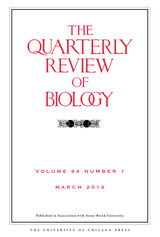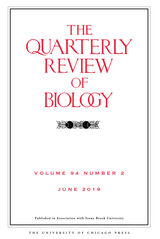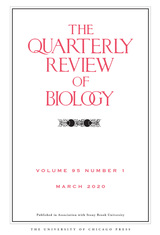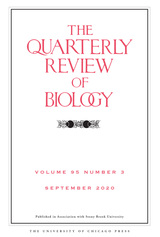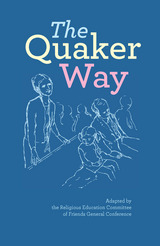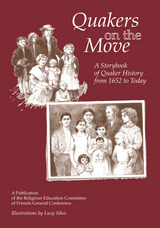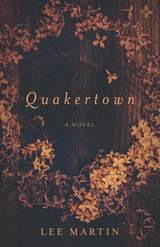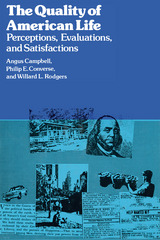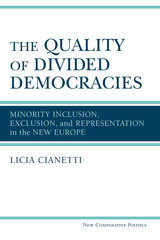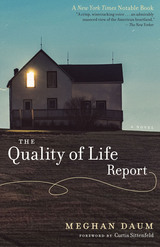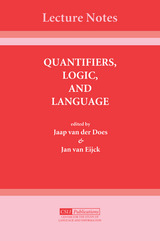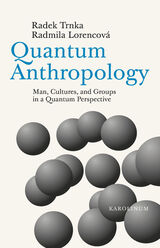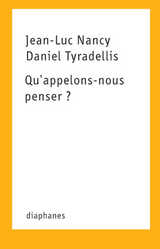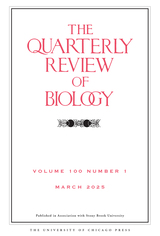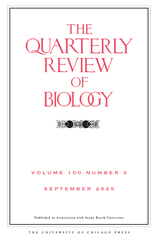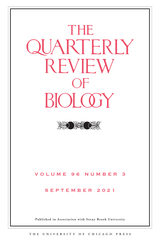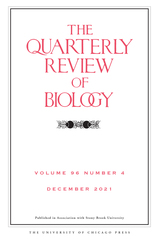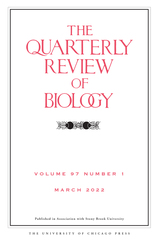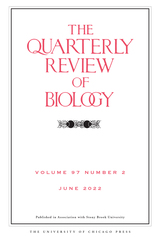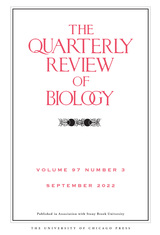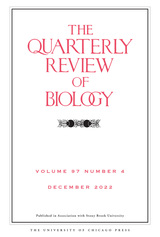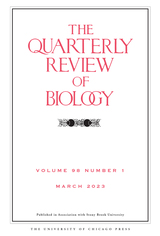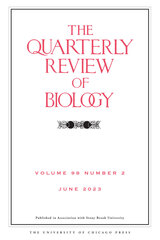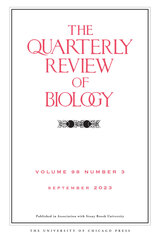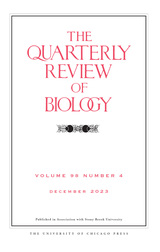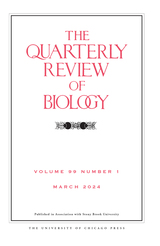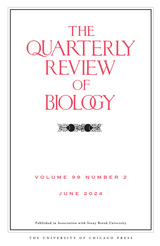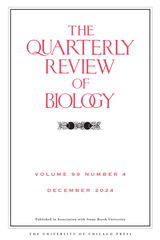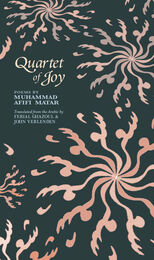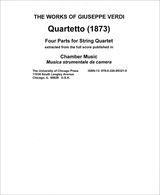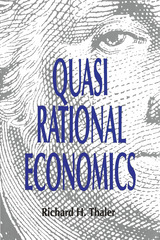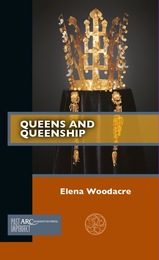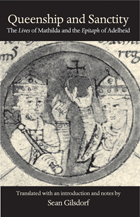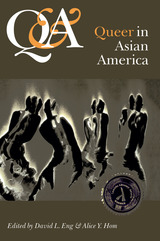 Q & A Queer And Asian: Queer & Asian In America
Alvin Eng
Temple University Press, 1998 What does it mean to be queer and Asian American at the turn of the century? The writers, activists, essayists, and artists who contribute to this volume consider how Asian American racial identity and queer sexuality interconnect in mutually shaping and complicating ways. Their collective aim (in the words of the editors) is "to articulate a new conception of Asian American racial identity, its heterogeneity, hybridity, and multiplicity -- concepts that after all underpinned the Asian American moniker from its very inception."
Q & A approaches matters of identity from a variety of points of view and academic disciplines in order to explore the multiple crossings of race and ethnicity with sexuality and gender. Drawing together the work of visual artists, fiction writers, community organizers, scholars, and participants in roundtable discussions, the collection gathers an array of voices and experiences that represent the emerging communities of a queer Asian America. Collectively, these contributors contend that Asian American studies needs to be more attentive to issues of sexuality and that queer studies needs to be more attentive to other aspects of difference, especially race and ethnicity. Vigorously rejecting the notion that a symmetrical relationship between race and homosexuality would weaken lesbian/gay and queer movements, the editors refuse to "believe that a desirably queer world is one in which we remain perpetual aliens -- queer houseguests -- in a queer nation."
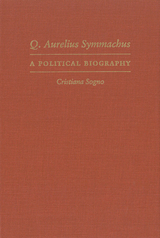 Q. Aurelius Symmachus: A Political Biography
Cristiana Sogno
University of Michigan Press, 2010 Symmachus was a brilliant orator, writer, and statesman, often flatly labeled as one of the last pagan senators. Cristiana Sogno offers a reconstruction of the political career of Symmachus through close analysis of his extensive writings, while also proposing a critical reevaluation of his historical importance. In contrast to traditional interpretation, Sogno's study demonstrates that Symmachus was primarily an influential politician, rather than a mere pagan zealot. By portraying the individual experience of Symmachus, the book sets forth a new approach for interpreting the political aspirations, mentality, and attitudes of Roman senators. The much-studied question of the Christianization of the Western aristocracy has created the illusion of a Christian and a pagan aristocracy rigidly separated from each other. Through her study of Symmachus, Sogno demonstrates the primary importance of politics over religion in the public activity of the late Roman aristocracy. Although the book is specifically addressed to scholars and students of Late Antiquity, it will also be of interest to classicists, ancient historians, and non-specialists who wish to know more about this pivotal period in Roman history. Cristiana Sogno received her Ph.D. in Classics and History from Yale University. Currently she is Townsend Assistant Professor of Classics at Cornell University. Visit Professor Sogno's website at: http://www.fordham.edu.
 Q Policing: LGBTQ+ Experiences, Perspectives, and Passions
Edited by Roddrick Colvin, Angela Dwyer, and Sulaimon Giwa
Southern Illinois University Press, 2024 Global perspectives on policing within LGBTQ+ communities
Relationships between law enforcement and lesbian, gay, bisexual, transgender, and queer (LGBTQ+) communities have always been varied and complex. On one hand, history is filled with incidents of police harassment: raids that sparked famous uprisings and rebellions; shoddy police investigations into the murders of LGBTQ+ community members; a corrosive organizational culture marked by heteronormativity and misogyny. Yet positive changes are being made, such as the creation of LGBTQ+ police associations, participation by police officers in Pride Parades around the world, and formal apologies for past actions. To some LGBTQ+ community members, police are the physical manifestations of state-sanctioned oppression and abuse. To others, they are guardians who have become partners in public safety.
Q Policing features eighteen contributors from around the world who explore the nature of the relationship between LGBTQ+ communities and the police. Part 1 of the book offers insights on policing and racial and ethnic constructions, including efforts to build collaborative models of community-building within groups and with law enforcement. Part 2 highlights the experiences of individuals who may be marginalized due to various social constructions such as transgender, unhoused, southern, or kink-involved. Finally, Part 3 shares perspectives of queer folks inside policing.
The contributors—scholars, social workers, police officers, and other community leaders—cover diverse topics, including queer experiences of policing in southern India, clinical implications for mental health professionals working with Latinx LGBTQ+ people, transgender and nonbinary peoples’ presentation management during encounters with law enforcement, discriminatory policies in place in the southern United States, the pathologization of kink, and more. Essays analyze interviews with the “Pride Defenders” in Hamilton, Canada, as well as British and American police officers transitioning while in uniform. They explore the experiences of gay, lesbian, and genderqueer police officers, map principal findings and central concerns that structure extant scholarship on gay police officers in the UK, use queer theory to explore the effectiveness of LGBTQ+ liaisons, and more.
The volume editors adopt an inclusive global perspective to account for contextually located experiences of queer people within and outside of the United States. The book incorporates a variety of voices, data sources, and methodologies, but contributors share an intentional focus on race, age, sex, gender, and other identities that helps explain and contextualize queer people’s experiences around and in policing. The diverse, international group of contributors—whose voices are not often heard in traditional outlets and mainstream media—demonstrates that despite discrimination, harassment, and violence, LGBTQ+ communities continue to thrive.
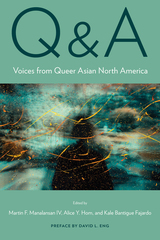 Q&A: Voices from Queer Asian North America
Edited by Martin F. Manalansan IV, Alice Y. Hom, and Kale Bantigue Fajardo
Temple University Press, 2021 First published in 1998, Q & A: Queer in Asian America, edited by David L. Eng and Alice Y. Hom, became a canonical work in Asian American studies and queer studies. This new edition of Q & A is neither a sequel nor an update, but an entirely new work borne out of the progressive political and cultural advances of the queer experiences of Asian North American communities. The artists, activists, community organizers, creative writers, poets, scholars, and visual artists that contribute to this exciting new volume make visible the complicated intertwining of sexuality with race, class, gender, and ethnicity. Sections address activism, radicalism, and social justice; transformations in the meaning of Asian-ness and queerness in various mass media issues of queerness in relation to settler colonialism and diaspora; and issues of bodies, health, disability, gender transitions, death, healing, and resilience. The visual art, autobiographical writings, poetry, scholarly essays, meditations, and analyses of histories and popular culture in the new Q & Agesture to enduring everyday racial-gender-sexual experiences of mis-recognition, micro-aggressions, loss, and trauma when racialized Asian bodies are questioned, pathologized, marginalized, or violated. This anthology seeks to expand the idea of Asian and American in LGBTQ studies. Contributors: Marsha Aizumi, Kimberly Alidio, Paul Michael (Mike) Leonardo Atienza, Long T. Bui, John Paul (JP) Catungal, Ching-In Chen, Jih-Fei Cheng, Kim Compoc, Sony Coráñez Bolton, D’Lo, Patti Duncan, Chris A. Eng, May Farrales, Joyce Gabiola, C. Winter Han, Douglas S. Ishii, traci kato-kiriyama, Jennifer Lynn Kelly, Mimi Khúc, Anthony Yooshin Kim, Việt Lê, Danni Lin, Glenn D. Magpantay, Leslie Mah, Casey Mecija, Maiana Minahal, Sung Won Park, Thea Quiray Tagle, Emily Raymundo, Vanita Reddy, Eric Estuar Reyes, Margaret Rhee, Thomas Xavier Sarmiento, Pahole Sookkasikon, Amy Sueyoshi, Karen Tongson, Kim Tran, Kay Ulanday Barrett, Reid Uratani, Eric C. Wat, Sasha Wijeyeratne, Syd Yang, Xine Yao, and the editors
Qal'at Jabar Pottery: A Study of a Syrian Fortified Site in the Late 11th–14th Centuries
Cristina Tonghini
Council for British Research in the Levant, 1999 By studying both the archaeological evidence and the written records, this volume provides a new means of interpreting and reconstructing the history of an important fortified site of the middle Euphrates valley, Qalat Jabar, and clarifies its connection with the neighbouring regions. A detailed classification of the pottery finds from the late eleventh to the fourteenth centuries provides a chronological framework for the major changes in ceramic production - a valuable model which can be used for other sites. This is an example of the detailed archaeological research that has greatly advanced our understanding of the history of the Euphrates valley in the Middle Ages.
Qanemcit Amllertut/Many Stories to Tell: Tales of Humans and Animals from Southwest Alaska
Edited by Ann Fienup-Riordan
University of Alaska Press, 2017 This bilingual collection shares new translations of old stories recorded over the last four decades though interviews with Yup’ik elders from throughout southwest Alaska. Some are true qulirat (traditional tales), while others are recent. Some are well known, like the adventures of the wily Raven, while others are rarely told. All are part of a great narrative tradition, shared and treasured by Yup’ik people into the present day.
This is the first region-wide collection of traditional Yup’ik tales and stories from Southwest Alaska. The elders and translators who contributed to this collection embrace the great irony of oral traditions: that the best way to keep these stories is to give them away. By retelling these stories, they hope to create a future in which the Yup’ik view of the world will be both recognized and valued.
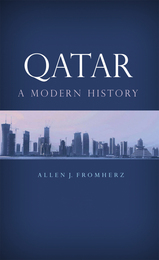 Qatar: A Modern History
Allen J. Fromherz
Georgetown University Press, 2011 What role does Qatar play in the Middle East and how does it differ from the other Gulf states? How has the ruling Al-Thani family shaped Qatar from a traditional tribal society and British protectorate to a modern state? How has Qatar become an economic superpower with one of the highest per capita incomes in the world? What are the social, political, and economic consequences of Qatar’s extremely rapid development? In this groundbreaking history of modern Qatar, Allen J. Fromherz presents a full portrait that analyzes Qatar's crucial role in the Middle East and its growing regional influence within a broader historical context. Drawing on original sources in Arabic, English, and French as well as his own fieldwork in the Middle East, the author deftly traces the influence of the Ottoman and British empires and Qatar’s Gulf neighbors on the country prior to Qatar’s meteoric rise in the post-independence era.
Fromherz gives particular weight to the nation's economic and social history, from its modest origins in the pearling and fishing industries to the considerable economic clout it exerts today, a clout that comes with having the second-highest natural gas reserves in the region. He also looks at what the future holds for Qatar's economy as the country tries to diversify beyond oil and gas. Furthermore, the book examines the paradox of Qatar where monarchy, traditional tribal culture, and conservative Islamic values appear to coexist with ultra modern development and a large population of foreign workers who outnumber Qatari citizens. This book is as unique as the country it documents—a multi-faceted picture of the political, cultural, religious, social, and economic make up of modern Qatar and its significance within the Gulf Cooperation Council and the wider region.
 Qatar: A Modern History, Updated Edition
Allen J. Fromherz
Georgetown University Press, 2017 What role does Qatar play in the Middle East, and how does it differ from the other Gulf states? How has the ruling Al-Thani family shaped Qatar from a traditional tribal society and British protectorate to a modern state? How has Qatar become an economic superpower with one of the highest per-capita incomes in the world? What are the social, political, and economic consequences of Qatar’s extremely rapid development? In this groundbreaking history of modern Qatar, Allen J. Fromherz analyzes the country’s crucial role in the Middle East and its growing regional influence within a broader historical context. Drawing on original sources in Arabic, English, and French as well as his own fieldwork in the Middle East, the author deftly traces the influence of the Ottoman and British Empires and Qatar’s Gulf neighbors prior to Qatar’s meteoric rise in the post-independence era. Fromherz gives particular weight to the nation’s economic and social history, from its modest origins in the pearling and fishing industries to the considerable economic clout it exerts today, a clout that comes from having the region’s second-highest natural gas reserves. He also looks at what the future holds for Qatar’s economy as the country tries to diversify beyond oil and gas. The book further examines the paradox of Qatar where monarchy, traditional tribal culture, and conservative Islamic values appear to coexist with ultramodern development and a large population of foreign workers who outnumber Qatari citizens. This book is as unique as the country it documents—a multifaceted picture of the political, cultural, religious, social, and economic makeup of modern Qatar and its significance within the Gulf Cooperation Council and the wider region.
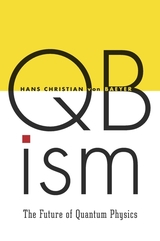 QBism: The Future of Quantum Physics
Hans Christian von Baeyer
Harvard University Press, 2016 Measured by the accuracy of its predictions and the scope of its technological applications, quantum mechanics is one of the most successful theories in science—as well as one of the most misunderstood. The deeper meaning of quantum mechanics remains controversial almost a century after its invention. Providing a way past quantum theory’s paradoxes and puzzles, QBism offers a strikingly new interpretation that opens up for the nonspecialist reader the profound implications of quantum mechanics for how we understand and interact with the world.
Short for Quantum Bayesianism, QBism adapts many of the conventional features of quantum mechanics in light of a revised understanding of probability. Bayesian probability, unlike the standard “frequentist probability,” is defined as a numerical measure of the degree of an observer’s belief that a future event will occur or that a particular proposition is true. Bayesianism’s advantages over frequentist probability are that it is applicable to singular events, its probability estimates can be updated based on acquisition of new information, and it can effortlessly include frequentist results. But perhaps most important, much of the weirdness associated with quantum theory—the idea that an atom can be in two places at once, or that signals can travel faster than the speed of light, or that Schrödinger’s cat can be simultaneously dead and alive—dissolves under the lens of QBism.
Using straightforward language without equations, Hans Christian von Baeyer clarifies the meaning of quantum mechanics in a commonsense way that suggests a new approach to physics in general.
 QED: A Journal in GLBTQ Worldmaking 2, no. 1
Charles E. Morris III
Michigan State University Press Journals, 2015 IN THIS ISSUE
Editorial Introduction
Thomas K. Nakayama, Charles E. Morris III, "Worldmaking and Everyday Interventions"
Essays
Raechel Tiffe, "Interrogating Industries of Violence: Queering the Labor Movement to Challenge Police Brutality and the Prison Industrial Complex"
Camille Holthaus, "The Future of Bisexual Activism"
Jonathan Alexander, "Narrating Sexual Compulsion: Gay Male Writing Beyond Shame"
Jaime Woo, "Grindr: Part of a Complete Breakfast"
Justin N. Thorpe, Adam J. Greteman, "Intimately Bound to Numbers: On the Rhetorics of GLBTQ School Climate Research"
Queer Conversation
Kathleen E. Feyh, LGBTQ Oppression and Activism in Russia: An Interview with Igor Iasine
Queer Performance and Performativities
Bryant Keith Alexander, "Introduction: Performative Rhetorics of Desire, Resistance, and Possibility"
Kimberlee Pérez, "You Can Get Anything You Want"
Tim Miller, "Lay of the Land"
Book Reviews
Jason Edward Black and Charles E. Morris III, eds., An Archive of Hope: Harvey Milk’s Speeches and Writings, reviewed by Maegan Parker Brooks
Alison Kafer, Feminist, Queer, Crip, reviewed by Julie Passanante Elman
Mattilda Bernstein Sycamore, The End of San Francisco, reviewed by Colin Gillis
Lucas Hilderbrand, Paris Is Burning: A Queer Film Classic, reviewed by Ryan James Gliszinski
Julia Serano, Excluded: Making Feminist and Queer Movements More Inclusive, reviewed by Caleb J. Green
Mel Y. Chen, Animacies: Biopolitics, Racial Mattering, and Queer Affect, reviewed by Shawna Lipton
Dennis Altman, The End of the Homosexual? reviewed by John Whittier Treat
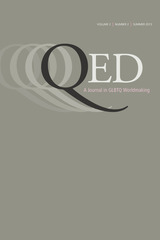 QED: A Journal in GLBTQ Worldmaking 2, no. 2
Charles E. Morris III
Michigan State University Press Journals, 2015 IN THIS ISSUE
Editorial Introduction
Charles E. Morris III, Thomas K. Nakayama, "Queers at Play, Transformative; Blackness and Queerness in Ferguson, Electric"
Essays
Matt Conn, "Gaming’s Untapped Queer Potential as Art"
Edmond Y. Chang, "Love Is in the Air: Queer (Im)Possibility and Straightwashing in FrontierVille and World of Warcraft"
Heidi McDonald, "Romance in Games: What It Is, How It Is, and How Developers Can Improve It"
Adrienne Shaw, "Circles, Charmed and Magic: Queering Game Studies"
Jeffrey Sens, "Queer Worldmaking Games: A Portland Indie Experiment"
Bonnie Ruberg, "No Fun: The Queer Potential of Video Games that Annoy, Anger, Disappoint, Sadden, and Hurt"
Sarah Beth Evans, Elyse Janish, "#INeedDiverseGames: How the Queer Backlash to GamerGate Enables Nonbinary Coalition"
Queer Conversation
Carly A. Kocurek, "Tabled for Discussion: A Conversation with Game Designer Michael De Anda"
Forum
Jeffrey Q. McCune, Jr., "The Queerness of Blackness"
Javon Johnson, "Black Joy in the Time of Ferguson"
Reuben Riggs, "Meeting Queerness and Blackness in Ferguson"
Jennifer Tyburczy, "Undeniable Forensic Evidence"
Nyle Fort, Darnell L. Moore, "Last Words: A Black Theological Response to Ferguson and Anti-Blackness"
Book Reviews
Katsuhiko Suganuma, Contact Moments: The Politics of Intercultural Desire in Japanese Male-Queer Cultures, Reviewed by Shinsuke Eguchi
Christina B. Hanhardt, Safe Space: Gay Neighborhood History and the Politics of Violence, Reviewed by Eric A. Stanley
A. Finn Enke, ed., Transfeminist Perspectives in and beyond Transgender and Gender Studies, Reviewed by Sam Hsieh
Adela C. Licona, Zines in Third Space: Radical Cooperation and Borderlands Rhetoric, Reviewed by Alyssa A. Samek
Sheena C. Howard, Black Queer Identity Matrix: Towards an Integrated Queer of Color Framework, Reviewed by Dominique D. Johnson
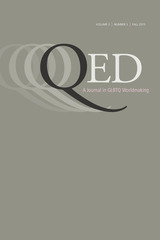 QED: A Journal in GLBTQ Worldmaking 2, no. 3
Charles E. Morris III
Michigan State University Press Journals, 2015 IN THIS ISSUE
Essays
Meredith Heller, "Female-Femmeing: A Gender-Bent Performance Practice"
Elliott DeLine, "Just Come in from the Rain: A Reluctant Transgender Activist Discusses Transgender Abuse in Syracuse, New York, and the Importance of Self-Care"
Karma R. Chávez, "The Precariousness of Homonationalism: The Queer Agency of Terrorism in Post-9/11 Rhetoric"
Forum
Jennifer Tyburczy, "Irreverent: A Celebration of Censorship"
Barbara Nitke, "The Many Stages of Censorship"
"How to Make a Paint Bomb: Alex Donis Recalls My Cathedral and WAR"
Kimi Tayler, "Transformation and the Performativity of Gender: The Shock of the Possible"
Michelle Handelman, "The Magical Buttplug and the Phantom Child"
Baris Barlas, "The Fear of Being Censored"
Hugh Ryan, "A Praxis of Contextualized Controversy"
Queer Perfomance and Performativities
Bryant Keith Alexander, "Introduction: A Farewell to the Section"
Anthony Garrison-Engbrecht, Steven Reigns, "A Queer Dialogue on The Gay Rub"
Alexandros Papadopoulos, "Performing The Homo-Nazi Effect: Gay Neo-Nazism, Digital Drag Attack, and the Postcinematic Cultures of Crisis"
Shinsuke Eguchi, Andrew Spieldenner, "Two ‘Gaysian’ Junior Faculty Talking about Experience: A Collaborative Autoethnography"
Book Reviews
Leigh Moscowitz, The Battle over Marriage: Gay Rights Activism through the Media; Mary Bernstein and Verta Taylor, The Marrying Kind? Debating Same-Sex Marriage within the Lesbian and Gay Movement, reviewed by Michelle Kelsey Kearl
Eithne Luibhe´id, Pregnant on Arrival: Making the Illegal Immigrant, reviewed by Sara L. McKinnon
Lynne Huffer, Are the Lips a Grave? A Queer Feminist on the Ethics of Sex, reviewed by Peter F. Murray
Colin R. Johnson, Just Queer Folks: Gender and Sexuality in Rural America, reviewed by Erin J. Rand
Isaac West, Transforming Citizenships: Transgender Articulations of the Law, reviewed by K. J. Rawson
 QED: A Journal in GLBTQ Worldmaking 3, no. 1
Charles E. Morris III
Michigan State University Press Journals, 2016 IN THIS ISSUE
Essays
Nishant Shahani, "How to Survive the Whitewashing of AIDS: Global Pasts, Transnational Futures"
Valerie Palmer-Mehta, "Subversive Maternities: Staceyann Chin’s Contemplative Voice"
Leland G. Spencer, John Lynch, "Possibilities for Inclusive Family and Community in Beth Stroud’s ‘Walking in the Light’"
Courtney Bailey, "Confession and Catharsis in the U.S. Academy: Trigger Warnings, Coalitions, and Academic Audiences"
Queer Conversation
Bryan J. McCann, "Holding Each Other Better: Discussing State Violence, Healing, and Community with BreakOUT!"
Forum
Peter Odell Campbell, "Hobby Lobby’s Queer Antecedents (A Tale of Two RFRAs)"
Amy L. Livingston, Anna Kurhajec, "Organizing Priorities: The Problem with ENDA and Burwell"
Lisa M. Corrigan, "So, You’ve Heard of the Duggars? Bodily Autonomy, Religious Exemption, and the American South"
Alyssa A. Samek, "The Fourth Demand"
Book Reviews
C. Riley Snorton, Nobody’s Supposed to Know: Black Sexuality on the Down Low, reviewed by Charles I. Nero
Noelle M. Stout, After Love: Queer Intimacy and Erotic Economies in Post-Soviet Cuba, reviewed by Lisa M. Corrigan
Erin J. Rand, Reclaiming Queer: Activist and Academic Rhetorics of Resistance, reviewed by Kendall Gerdes
Meredith L. Weiss and Michael J. Bosia, eds., Global Homophobia: States, Movements, and the Politics of Oppression, reviewed by Joe Hatfield
Jeffrey Q. McCune, Jr., Sexual Discretion: Black Masculinity and the Politics of Passing, reviewed by Cherod Johnson
Adelina Anthony, Las Hociconas: Three Locas with Big Mouths and Even Bigger Brains, reviewed by Ruby Kim
Larissa M. Mercado-López, Sonia Saldívar-Hull, and Antonia Castañeda, eds., El Mundo Zurdo 3: Selected Works from the 2012 Meeting of the Society for the Study of Gloria Anzaldúa, reviewed by Irene Alejandra Ramírez and Adela C. Licona
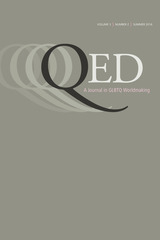 QED: A Journal in GLBTQ Worldmaking 3, no. 2
Charles E. Morris III
Michigan State University Press Journals, 2016 IN THIS ISSUE
Essays
Laurie Essig, Sujata Moorti, "Introduction to the Special Issue"
Yasmin Nair, "We Were There, We Are Here, Where Are We? Notes Toward a Study of Queer Theory in the
Neoliberal University"
Sujata Moorti, "Queer Romance with the Hijra"
Laurie Essig, "All the World Was There’ and Other White Lies about the Royal Wedding"
Kevin Moss, "Split Pride/Split Identities"
William Poulin-Deltour, "From the PACS to Parité: Preserving Heterosexual Distinction in 1990s France"
Sofía Kearns, "Widening the Spectrum of Desire and Nation: Anacristina Rossi’s Fiction"
Alexander Kondakov, "Teaching Queer Theory in Russia"
Queer Conversation
Sheena C. Howard, "Archiving as an Act of Cultural Resistance: Steven G. Fullwood and Sheena C. Howard in Conversation"
Book Reviews
Ryan Conrad, ed., Against Equality: Queer Revolution, Not Mere Inclusion, reviewed by E. Cram
Anne Emmanuelle Berger, The Queer Turn in Feminism: Identities, Sexualities, and the Theatre of Gender, reviewed by Adam Barbu
Amy Ellis Nutt, Becoming Nicole: The Transformation of an American Family, reviewed by Elizabeth Edington
Robert Payne, The Promiscuity of Network Culture: Queer Theory and Digital Media, reviewed by Rye Gentleman
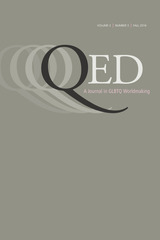 QED: A Journal in GLBTQ Worldmaking 3, no. 3
Charles E. Morris III
Michigan State University Press Journals, 2016 IN THIS ISSUE
Essays
John M. Sloop, Isaac West, "Heroism’s Contexts: Robbie Rogers and the Ghost of Justin Fashanu"
Paul Borghs, "The Gay and Lesbian Movement in Belgium from the 1950s to the Present"
Laura K. Wallace, "'My History, Finally Invented': Nightwood and Its Publics"
Queer Conversation
Alexis Pauline Gumbs, "Pulse"
Lawrence La Fountain-Stokes, "Queer Puerto Ricans and the Burden of Violence"
Lawrence La Fountain-Stokes, "Los puertorriqueños queer y el peso de la violencia"
Katie L. Acosta, "Pulse: A Space for Resilience, A Home for the Brave"
Michael Hames-Garcia, "When I Think of Pulse, I Think of Shakti"
Cassils, "103 Shots"
Julia Steinmetz, "The Sound of Everynight Life"
Christina B. Hanhardt, "Safe Space Out of Place"
Kimberlee Pérez, "I Also Want More"
Uriel Quesada, "Hacer lo posible"
Joseph M. Pierce, "Our Queer Breath"
Joseph M. Pierce, "Travestis, negras, boricuas, maricas"
Ramzi Fawaz, "Locked Eyes"
Jennifer Tyburczy, "Orlando and the Militancy of Queer Mourning"
E. Cram, "Pulse: The Matter of Movement"
Jeffrey A. Bennett, "202 Bullets"
Micaela J. Díaz-Sánchez, "Bailando: 'We Would Have Been There'"
Charles Rice-González, "Latino/a Visibility and a Legacy of Power and Love"
Karma R. Chávez, "Refusing Queer Violence"
Shinsuke Eguchi, "The Orlando Pulse Massacre: A Transnational Japanese Queer Response"
Aaron C. Thomas, "My Father’s Pulse"
Ahmet Atay, "A Response to the Orlando Shooting: Queer Communication Pedagogy"
Forum
Ryan Conrad, "An Introduction to a Different Kind of Conversation"
Michael Johnson, "A Letter from South Central Correctional Center"
Alison Duke, "The Missing 17 Minutes"
David Oscar Harvey, "On Iowa, HIV Criminalization, and Cautious Optimism"
Demian DinéYahzi’, "NEGATIVE / POSITIVE"
Cyd Nova, "Vectors of Disease: Sex Workers as Bodies to Be Managed"
Book Reviews
Francesca Stella, Lesbian Lives in Soviet and Post-Soviet Russia: Post/Socialism and Gendered Sexualities, reviewed by Veronika Lapina
Leland G. Spencer and Jamie C. Capuzza, eds., Transgender Communication Studies: Histories, Trends, and Trajectories, reviewed by Sara Hayden
Patricia Bell-Scott, The Firebrand and the First Lady: Portrait of a Friendship: Pauli Murray, Eleanor Roosevelt, and the Struggle for Social Justice, reviewed by Simon D. Elin Fisher
 QED: A Journal in GLBTQ Worldmaking 4, no. 1
Charles E. Morris III
Michigan State University Press Journals, 2017 IN THIS ISSUE
Articles
Grace McLaughlin, "Divergent Students, Disruptive Students: Gender Anxieties in U.S. K–12 Schools"
Charles Francis, Pate Felts, "Archive Activism: Vergangenheitsbewaltigung!"
Joshua H. Miller "'Until Death Do We (Queers) Part': (Queer) Biblical Interpretation, (Invented) Truth, and Presumption in Controversies Concerning Biblical Characters’ Sexualities"
Queer Conversation
Morgan M. Page, Sarah Schulman, "Queer Suicidality, Conflict, and Repair"
Forum
Tony E. Adams, Derek M. Bolen, "Tragic Queer at the Urinal Stall, Who, Now, Is the Queerest One of All? Queer Theory | Autoethnography | Doing Queer Autoethnography"
Jennifer Lee, "Ripping Off the Mask: A Queer, Kinky, Fat Masquerade"
Andrew R. Spieldenner, "Infectious Sex? An Autoethnographic Exploration of HIV Prevention"
Sandra L. Pensoneau-Conway, "Parenting the Possible"
Elijah C. Nealy, "Identity Intersections and Transformers: A Transgender Autoethnographic Reflection"
Robert Gutierrez-Perez, "Bridging Performances of Auto/ethnography and Queer Bodies of Color to Advocacy and Civic Engagement"
Amy Arellano, Christina L. Ivey, "Speaking as (Significant) Othered"
Sandra L. Faulkner, "MotherWork COLLAGE (A Queer Scrapbook)"
Shaka McGlotten, "Unlearning/Ethnography"
Ken Plummer, "On the Infinitude of Life Stories: Still Puzzling Queer Tales After All These Years"
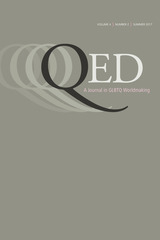 QED: A Journal in GLBTQ Worldmaking 4, no. 2
Charles E. Morris III
Michigan State University Press Journals, 2017 IN THIS ISSUE
Essays
Gerald Stephen Jackson, "Transcoding Sexuality: Computational Performativity and Queer Code Practices"
James J. Arnett, "The Revolution Will Be Working Class and Queer: Dos Passos’s Three Soldiers, Progressive Politics, and Revolutionary Rhetorics"
Forum
Jennifer Tyburczy, "Queer Resistance"
Kemi Adeyemi, "Donald Trump is the Perfect Man for the Job"
Karma R. Chávez, "From Sanctuary to a Queer Politics of Fugitivity"
Clare Croft, Efren Cruz Cortez, Jennifer Harge, Leyya Tawil, "a provocation towards moving"
Xandra Ibarra, "Training for Exhaustion (2015)"
Alexandra Rodríguez de Ruiz, "Queers Resisting Trump and White Supremacy in Mexico City"
Benny LeMaster, "Notes on Trans Relationality"
Aimee Carrillo Rowe, "A Queer Indigenous Manifesto"
Pavithra Prasad, "Outsider Orbits: Disavowal and Dissent in the United States"
Oli Rodriguez, "Spaces of Solidarity: The Last Seduction/La Seducción Fatal"
Kimberlee Pérez, Craig Gingrich Philbrook, “'In the Wake of "The Violence of Heteronormativity': Reflecting on, Contending with Affective Remains"
Gust A. Yep, "Further Notes on Healing from 'The Violence of Heteronormativity in Communication Studies'"
Benny LeMaster, "Unlearning the Violence of the Normative"
Karma R. Chávez, "Homonormativity and Violence against Immigrants"
Jonathan M. Gray, "Heteronormativity without Nature: Toward a Queer Ecology"
Elizabeth Whitney, "The Sex that God Can’t See: Heteronormativity, Whiteness, and the Erasure of Queer Desire in Popular Media"
Naida Zukić, "The Violence of Heteronormativity: Queer Worldmaking in Anohni’s Hopelessness"
Dawn Marie D. McIntosh, "Victims, Protectors, and Possibilities for Change: White Womanhood and the Violence of Heteronormativity"
Megan Volpert, "Every Violent August: Postcards from the Trenches of High School"
Allen Conkle, "Not Nothing"
Kimberlee Pérez, Craig Gingrich Philbrook, "Letters"
Book Reviews
Jin Haritaworn, Queer Lovers and Hateful Others: Regenerating Violent Times and Places, reviewed by Hana Masri
Tan Hoang Nguyen, A View from the Bottom: Asian American Masculinity and Sexual Representation, reviewed by Albert Rintrona III
Thomas R. Dunn, Queerly Remembered: Rhetorics for Representing the GLBTQ Past, reviewed by Cory Geraths
Sara L. McKinnon, Gendered Asylum: Race and Violence in U.S. Law and Politics, reviewed by Lario J. Albarrán
Mimi Schippers, Beyond Monogamy: Polyamory and the Future of Polyqueer Sexualities, reviewed by Jess Matias-Vega
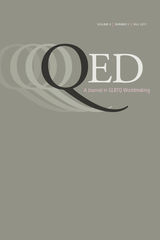 QED: A Journal in GLBTQ Worldmaking 4, no. 3
Charles E. Morris III
Michigan State University Press Journals, 2017 IN THIS ISSUE
Introduction
Eric Darnell Pritchard, "Grace Jones, Afro Punk, and Other Fierce Provocations: An Introduction to 'Sartorial Politics, Intersectionality, and Queer Worldmaking'"
Essays
Erin J. Rand, "The Right to Be Handsome: The Queer Sartorial Objects of 'Masculine of Center' Fashion"
Garrett W. Nichols, "Rural Drag: Fashioning Rurality and Privilege"
Minh-Ha T. Pham, "Racial Plagiarism and Fashion"
Brandi Thompson Summers, "Race as Aesthetic: The Politics of Vision, Visibility, and Visuality in VogueItalia’s ‘A Black Issue’"
Isabel Flower, Marcel Rosa-Salas, "Say My Name: Nameplate Jewelry and the Politics of Taste"
Eric Darnell Pritchard, "Black Girls Queer (Re)Dress: Fashion as Literacy Performance in Pariah"
Forum
Tanisha C. Ford, "A Black Girl Song for Dajerria"
Balbir K. Singh, "The Commodity Fetish of Modest Fashion"
Shaun Cole, "Gay Liberation Front and Radical Drag, London 1970s"
Tameka N. Ellington, Stacey R. Lim, "Rendered Powerless: Disability versus Westernized Beauty Standards"
Andrea Jenkins, "Purple"
Rikki Byrd, "In Search of the Good Life: Toward a Discourse on Reading the Black Body in Hip-Hop and Luxury Fashion"
Annette Harris Powell, "(Un)Dressing the Black Male Body"
Elena Romero, "The Butt Remix: Beauty, Pop Culture, Hip Hop, and the Commodification of the Black Booty"
Queer Convesations
Katie Manthey, Lolly, "Fatshion as Activism"
Katie Manthey, Elroi J. Windsor, "Dress Profesh: Genderqueer Fashion in Academia"
Book Reviews
Minh-Ha T. Pham, Asians Wear Clothes on the Internet: Race, Gender, and the Work of Personal Style Blogging, reviewed by Kimberly M. Jenkins
Vanita Reddy, Fashioning Diaspora: Beauty, Femininity, and South Asian American Culture, reviewed by Lipi Begum
Uri McMillan, Embodied Avatars: Genealogies of Black Feminist Art and Performance, reviewed by Sequoia Maner
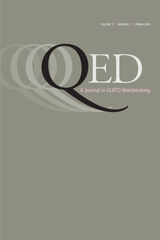 QED: A Journal in GLBTQ Worldmaking 5, no. 1
Charles E. Morris III
Michigan State University Press Journals, 2018 IN THIS ISSUE:
Essays
Tamar Shirinian, “Queer Life-Worlds in Postsocialist Armenia: Alternativ Space and the Possibilities of In/Visibility”
Ace J. Eckstein, “Out of Sync: Complex Temporality in Transgender Men’s YouTube Transition Channels”
Brett Cameron Stockdill, “Love in the Time of ACT UP: Reflections on AIDS Activism, Queer Family, and Desire”
Jesus Cisneros and Julia Gutierrez, “‘What Does It Mean to Be Undocuqueer?’ Exploring (il)Legibility within the Intersection of Gender, Sexuality, and Immigration Status”
Exhibition and Performance Reviews
Dominic Janes, “Review of Exhibitions: British Library, Gay UK: Love, Law and Liberty; British Museum, Desire, Love, Identity: Exploring LGBTQ Histories; and Tate Britain, Queer British Art, 1861–1967”
Jeanne Vaccaro, “Embodied Risk: Cassils”
Jessica Lynn Posner, “Artist as Alchemist: A Review of Cassils’s Monumental ”
Book Reviews
Meg-John Barker and Julia Scheele, Queer: A Graphic History, reviewed by Jess O’Rear
Ana Castillo, Give It to Me, reviewed by Elena Perez-Zetune
Uriel Quesada, Leticia Gomez, and Salvador Vidal-Ortiz, eds., Queer Brown Voices: Personal Narratives of Latina/o LGBT Activism, reviewed by Griselda Madrigal Lara
Jesus Ramirez-Valles, Queer Aging: The Gayby Boomers and a New Frontier for Gerontology, reviewed by Dustin Bradley Goltz
Eric Darnell Pritchard, Fashioning Lives: Black Queers and the Politics of Literacy, reviewed by Gavin P. Johnson
Eli Clare, Brilliant Imperfection: Grappling with Cure, reviewed by Julie Avril Minich
Amy L. Brandzel, Against Citizenship: The Violence of the Normative, reviewed by Annie Hill
Bruno Perreau, Queer Theory: The French Response, reviewed by Kim Coates
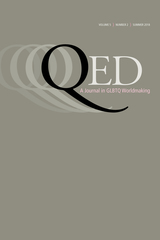 QED: A Journal in GLBTQ Worldmaking 5, no. 2
Charles E. Morris III
Michigan State University Press Journals, 2018 Essays
Hana Masri, “Queer Border Objects and the Sucio Material Politics of Migration in the U.S.–Mexico Borderlands”
Joshua Trey Barnett and Brandon S. Killen, “Catching Sight: Queer Worldmaking in a Glance”
Tison Pugh, “Interracial Homosexuality and the White Southern Phallus in Kevin Sessums’s Mississippi Sissy”
Forum: Calling Spacey Out?
Claire Sisco King, “Introduction”
Joshua N. Morrison, “Anticipating the Mobilization of Queerness in the Rehabilitation of Kevin Spacey”
Justin J. Rudnick, “Kevin Spacey’s Coming Out and the Politics of Gay Victimhood”
Dylan Rollo, “Display Case: Kevin Spacey’s Shattered Closet, Integrity, and Image”
Suzanne Marie Enck, “Accountability Amidst the ‘Me Too’ Reckoning: Kevin Spacey’s Homopatriarchal Apologia”
Meggie Mapes, “Bad Spacey: Retributive Justice and Queer Erasure”
Christopher Purcell, “Hiding Behind Gayness: On Spacey and What It Means for Gay/Bisexual Youth”
Shinsuke Eguchi, “Layers of Homonormativity in Kevin Spacey’s Coming-Out Scandal”
Ian Barnard, “Queer: Good Gay, Bad Gay, Black Gay, White Gay?”
Jeffrey Q. McCune, Jr., “Beyond Kevin Spacey: More than Scraps on the Cutting Room Floor”
Book Reviews
Erica R. Meiners, For the Children? Protecting Innocence in a Carceral State, reviewed by Jenna M. Loyd
Sarah Schulman, Conflict Is Not Abuse: Overstating Harm, Community Responsibility, and the Duty of Repair, reviewed by Kendall Gerdes
Jennifer Tyburczy, Sex Museums: The Politics and Performance of Display, reviewed by Thomas R. Dunn
Jaclyn I. Pryor, Time Slips: Queer Temporalities, Contemporary Performance, and the Hole of History, reviewed by Myles W. Mason
 QED: A Journal in GLBTQ Worldmaking 5, no. 3
Charles E. Morris III
Michigan State University Press Journals, 2017 In This Issue
Essays
Casey Ryan Kelly, “Emasculating Trump: Incredulity, Homophobia, and the Spectacle of White Masculinity”
Angel Daniel Matos, “Rabbit Weddings, Animal Collectives, and the Potentialities of Perverse Reading: Children’s Literature and Queer Worldmaking in A Day in the Life of Marlon Bundo”
Forum: Queer Forum on Navigating Normativity Between Field and Academe in India
Jeff Roy, “Introduction”
Gayatri Reddy, “Paradigms of Thirdness: Analyzing the Past, Present, and Potential Futures of Gender and Sexual Meaning in India”
Aniruddha Dutta, “On Queerly Hidden Lives: Precarity and (In)visibility between Formal and Informal Economies in India”
Sayan Bhattacharya, “Unhoming the Home as Field: Notes Towards Difficult Friendships”
Uditi Sen, “Choukathe Danriye (Standing at the Threshold): Queer Negotiations of Kolkata’s Archives and Society”
Elaine Craddock, “Recalibrating (Field)work”
Srimati Basu, “Hiding in Plain Sight: Disclosure, Identity, and the Indian Men’s Rights Movement”
Anuj Vaidya, “Forest Tales: Restorying the Ramayana”
Anjali Arondekar, “Itinerant Sex”
Geeta Patel, “Queer/Ivory Proclivities”
Lalita du Perron, “‘How Can I Be Too Loud and Still Not Be Heard?’ Negotiating Heteromisogyny in the Academy while Confronting White Feminism”
Brian A. Horton, “The Queer Turn in South Asian Studies? or ‘That’s Over & Done Queen, On to the Next’”
Queer Conversation
Mia Fischer, Sarah Slater, CeCe McDonald, and Joshua Allen, “Transgender Visibility, Abolitionism, and Resistive Organizing in the Age of Trump: A Conversation with CeCe McDonald and Joshua Allen”
Exhibit Review
Frederick S. Roden, The Metropolitan Museum of Art of New York, Heavenly Bodies: Fashion and the Catholic Imagination (2018)
Book Reviews
Karl Schoonover and Rosalind Galt, Queer Cinema in the World, reviewed by Juan Llamas-Rodriguez
Stacey Waite, Teaching Queer: Radical Possibilities for Writing and Knowing, reviewed by Kathryn Joan Leslie
Omar G. Encarnación, Out in the Periphery: Latin America’s Gay Rights Revolution, reviewed by Lisa M. Corrigan
Ramzi Fawaz, The New Mutants: Superheroes and the Radical Imagination of American Comics, reviewed by Jennifer Cuffman
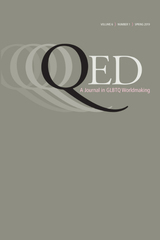 QED: A Journal in GLBTQ Worldmaking 6, no. 1
Charles E. Morris III
Michigan State University Press Journals, 2019 IN THIS ISSUE
Essays
Evan Mitchell Schares, “The Suicide of Leelah Alcorn: Whiteness in the Cultural Wake of Dying Queers”
Nan Gearhardt, “Rethinking Trans History and Gay History in Early Twentieth-Century New York”
Kyle Christensen, “Containing Voices of Memory: Lesbianism, Second-Wave Feminism, and the Queer Mnemonic Voice-Outtake in MAKERS: The Women Who Make America” 48
Forum: Queer Trans Culture and Invention Beyond Visibility: Experiencing Cassils
E. Cram, “Prelude to an Encounter”
E. Cram, “Feeling a Monumental Midwest: Reflections from Monument Push”
K. J. Rawson, “Witness, Bystander, or Aggressor? Encountering Cassils”
Charles E. Morris III, “Smelling Cassils”
Daniel C. Brouwer, “Illness as Metaphor in Cassils’s Trans Performance”
Benjamin Zender, “What Might Be Bullets, Fireworks, or Balloons: Repertoires of More than Survival in Cassils’s 103 Shots and Lyle Ashton Harris and Thomas Allen Harris’s Brotherhood, Crossroads and Etcetera 1994”
E. Cram and Cassils, “Cassils: On Violence, Witnessing, and the Making of Trans Worlds”
Book Reviews
Héctor Domínguez Ruvalcaba, Translating the Queer: Body Politics and Transnational Conversations, reviewed by Matthew Ringard
Vanessa R Panfil, The Gang’s All Queer: The Lives of Gay Gang Members, reviewed by Taheera Shabazz
Trevor Hoppe, Punishing Disease: HIV and the Criminalization of Sickness, reviewed by Mallory J. Johnson
Kadji Amin, Disturbing Attachments: Genet, Modern Pederasty, and Queer History, reviewed by Weisong Gao
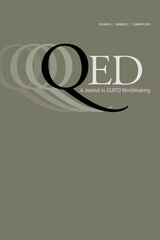 QED: A Journal in GLBTQ Worldmaking 6, no. 2
Charles E. Morris III
Michigan State University Press Journals, 2019 In This Issue
Essays
Lisa M. Corrigan, “Queering the Panthers: Rhetorical Adjacency and Black/Queer Liberation Politics”
Bernadette Marie Calafell, “Narrative Authority, Theory in the Flesh, and the Fight over The Death and Life of Marsha P. Johnson”
Forum: Stonewall Fiftieth Anniversary: Queering Legacy and Its Futures
KC Councilor, “Standing on the Shoulders of Stonewall”
Qwo-Li Driskill, “All Power to the People: A Gay Liberation Triptych”
Leah Lakshmi Piepzna-Samarasinha, “Disability Justice/Stonewall’s Legacy, or: Love Mad Trans Black Women When They Are Alive and Dead, Let Their Revolutions Teach Your Resistance All the Time”
Andrea Jenkins, “Power to the People: The Stonewall Revolution”
Shuzhen Huang, “Fifty Years since Stonewall: Beyond the Borders of the United States”
pattrice jones, “Queer Eros in the Enchanted Forest: The Spirit of Stonewall as Sustainable Energy”
Didier William, “Two Dads”
Kevin Mumford, “The Lessons of Stonewall Fifty Years Later”
Eric Marcus, “Making Peace with Stonewall”
Joseph Nicholas DeFilippis, “Betraying the Legacy of Stonewall”
Ryan Conrad,. “I Still Hate New Year’s Day”
Perry N. Halkitis, “Coming Out and the Otherness of Gay Men Across Generations”
Exhibition Reviews
Jessica Posner, “QED Spring 2019 Exhibition Reviews: Editorial Note”
David Geer and Isaac Pool, “Love & Resistance: Stonewall 50”
Exhibition Review & Queer Conversation
Chris E. Vargas and Jessica Posner, “Remembering ‘Consciousness Razing—The Stonewall Re-Memorialization Project’: Chris E. Vargas in Conversation with Jessica Posner”
Book Reviews
Michael Arditti, Of Men and Angels, reviewed by Frederick Roden
Hongwei Bao, Queer Comrades: Gay Identity and Tongzhi Activism in Postsocialist China, reviewed by Di Wang
Liz Montegary, Familiar Perversions: The Racial, Sexual, and Economic Politics of LGBT Families, reviewed by Matty Hemming
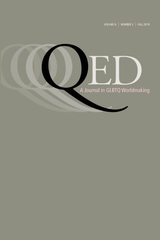 QED: A Journal in GLBTQ Worldmaking 6, no. 3
Charles E. Morris III
Michigan State University Press Journals, 2019 In This Issue
Essays
Pamela VanHaitsma, “Stories of Straightening Up: Reading Femmes in the Archives of Romantic Friendship”
Ragan Fox, “Pete and Peck: On Eating Our Own”
Jeff Nagel, “(Be)Longing in the Archives: Family, Affect, and Loss in the Jack Nichols Papers”
Ian Liujia Tian, “Graduated In/Visibility: Reflections on Ku’er Activism in (Post)Socialist China”
Forum: Considering the Queer Disabled/Debilitated Body
Andrew R. Spieldenner, “Considering the Queer Disabled/Debilitated Body: An Introduction of Queer Cripping”
Stephanie Hsu, “Notes on a Pedagogy of Debility”
Robert Vazquez-Pacheco, “Being Poor Is a Full-Time Job: A Narrative of Applying to Be Disabled”
Antonio Tomas De La Garza, “A Eulogy for Roxsana Hernández: Tracing the Relationship between Border Rhetoric and Queer Debility”
Kathryn Hobson, “Fibromyalgia: A Queer-Femme Crip Narrative Essay”
Ashley Burnside, “Growing Up Different Than Your Family: Exploring the Intersection of LGBTQ Identity, Disability, and Family”
Daniel Reeders, “Disability and the Queer Politics of Disclosure”
Jeffrey Escoffier, “When Love Is Blind: Critical Ontology and Queer Desire”
Shinsuke Eguchi, “Intersections among Queerness and Disability: A Case of Out at the Olympics”
Shanna K. Kattari, “Troubling Binaries, Boxes, and Spectrums: A Galactic Approach to Queerness and Crip-ness”
alecia deon, “Between the Worlds of the Colonizer and the Conjure Woman”
Queer Conversation
Shane T. Moreman, “Accommodating Desires of Disability: A Multi-Modal Methodological Approach to Terry Galloway and the Mickee Faust Club”
Exhibition Reviews
Jessica Posner, “QED Stonewall Fiftieth Anniversary Exhibition Reviews, Part 2: Editorial Note”
Matt Morris and Jade Yumang, “He Had Money and Standing, They Had Youth and Beauty: A Response to About Face: Stonewall, Revolt and Queer Art”
Ksenia M. Soboleva and Nicholas Chittenden Morgan, “Art After Stonewall, 1969–1989: Grey Art Gallery and Leslie-Lohman Museum”
Sophie Asakura and Jane Foreman, “Stewardship and Decontextualization: A Review of Stonewall 50 at the Contemporary Arts Museum Houston”
Keijaun Thomas and Egon Suds, “I Don’t Want to Leave the Sand, but I Want to Leave the Island: Reflecting on Nobody Promised You Tomorrow: Art 50 Years After Stonewall, Brooklyn Museum, Brooklyn, NY”
Book Reviews
Avram Finkelstein, After Silence: A History of AIDS through Its Images and Kyle Croft and Asher Mones, Cell Count, reviewed by Ryan Conrad
Héctor Carrillo, Pathways of Desire: Mexican Gay Men, reviewed by Imelda Nuñez Muñoz
Jasbir K. Puar, The Right to Maim: Debility, Capacity, Disability, reviewed by Lisa M. Corrigan
Madison Moore, Fabulous: The Rise of the Beautiful Eccentric, reviewed by Eric Darnell Pritchard
 QED: A Journal in GLBTQ Worldmaking 7, no. 1
Charles E. Morris III
Michigan State University Press Journals, 2020 In This Issue
Essays
David Church, “Pinning Down the Past: Lesbian Politics and Queer Ecologies in The Duke of Burgundy”
Jason Jacobs, “An Excess of Love”
Forum: “We Don’t See LGBTQ Differences”: Cisheteronormativity and the Concealing of Phobias and Irrational Fears behind Rhetorics of Acceptance
Roberta Chevrette and Shinsuke Eguchi, “Introduction: ‘We Don’t See LGBTQ Differences’: Cisheteronormativity and the Concealing of Phobias and Irrational Fears behind Rhetorics of Acceptance”
Shinsuke Eguchi, “The Politics of Queerphobia: In the Communication Discipline”
Bernadette Marie Calafell, “Cisnormativity, Whiteness, and the Fear of Contagion in Academia”
Benny LeMaster, “Notes on Some Especially (Not So) Subtle Dissatisfactions”
Shuzhen Huang, “Unbecoming Queer: Chinese Queer Migrants and Impossible Subjectivity”
Anthony Cuomo, “Constituting an Audience against California State Senate Bill 48”
Andrew R. Spieldenner, “‘But She Has Gay Friends’: The Violence of Heteronormative Liberal Politics in the University”
Roberta Chevrette, “Blinded by Acceptance: Straight Fragility, Shame, and the Dangers of Postqueer Politics”
Pavithra Prasad, “In a Minor Key: Queer Kinship in Times of Grief ”
Film/Exhibition Reviews
Don Argott, director, Believer, reviewed by Ben Brandley
Ximing Zhang, director, I’ve Got a Little Problem, reviewed by Christian Gregory
Rob Epstein and Jeffrey Friedman, directors, State of Pride, reviewed by Abigail Reed
Michael Palmieri and Donal Mosher, directors, The Gospel of Eureka, reviewed by Dakoda Smith
Book Reviews
Jonathan Weinberg, Pier Groups: Art and Sex Along the New York Waterfront, reviewed by Daniel Fountain
Sara Ahmed, What’s the Use: On the Uses of Use, reviewed by Caitlin Mackenzie
Jana Riess, The Next Mormons: How Millennials Are Changing the LDS Church, reviewed by Ben Brandley
Bonnie Ruberg, Video Games Have Always Been Queer, reviewed by Mario J. Sanders
E. Patrick Johnson, Black. Queer. Southern. Women.: An Oral History, reviewed by Richard Daily
Tim Miller, A Body in the O: Performances and Stories, review by Anthony Rosendo Zariñana
Roderick A. Ferguson, One-Dimensional Queer, reviewed by Charles O’Malley
 QED: A Journal in GLBTQ Worldmaking 7, no. 2
Charles E. Morris III
Michigan State University Press Journals, 2020 In This Issue
Essays
Andrés C. López, “Ni de aquí ni de alla: A Mythohistoriography of Growing Up In-Between”
Bryan J. McCann, “Lonely Young American: Queer Terrorist Recruitment and the Trope of the Child”
Ian Liujia Tian, “Perverse Politics, Postsocialist Radicality: Queer Marxism in China”
Stephanie L. Young and Art Herbig, “‘I Am Also a We’: Exploring Queer Worldmaking in Sense8”
Queer Conversation
Natalie Fixmer-Oraiz and Grover Wehman-Brown, “Called into the World by All of Us: An Interview with Masculine Birth Ritual Podcast Creator and Host Grover Wehman-Brown”
Film/Exhibition Reviews
Sam Pilling, director, “Samsung Galaxy: The Future,” reviewed by Rachel E. Silverman 106
Roman Chimienti and Tyler Jensen, directors, Scream, Queen! My Nightmare on Elm Street, reviewed by Brendan G. A. Hughes
Book Reviews
Darius Bost, Evidence of Being: The Black Gay Cultural Renaissance and the Politics of Violence, reviewed by Corey D Clawson
Tobias Raun, Out Online: Trans Self-Representation and Community Building on YouTube (Gender, Bodies and Transformation), reviewed by Sean Maulding
Lukasz Szulc, Transnational Homosexuals in Communist Poland: Cross-Border Flows in Gay and Lesbian Magazines, reviewed by David Weiss
Jack Halberstam, Trans: A Quick and Quirky Account of Gender Variability, reviewed by Sophie Jones
C. Riley Snorton, Black on Both Sides: A Racial History of Trans Identity, reviewed by Myra Nikki Roberts
Tavia Nyong’o, Afro-Fabulations: The Queer Drama of Black Life, reviewed by Truman R. Keys
Ralina L. Joseph, Postracial Resistance: Black Women, Media, and The Uses of Strategic Ambiguity, reviewed by Rachel E. Silverman
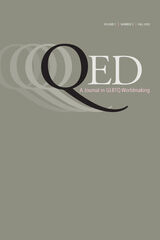 QED: A Journal in GLBTQ Worldmaking 7, no. 3
Charles E. Morris III
Michigan State University Press Journals, 2020 In This Issue
Essays
Aleksandra Gajowy, “Insects, Threads, and Urinals: Polymorphous Desire Flows in Krzysztof Jung’s Work”
Elizabeth Schoppelrei, “The Queer Intimacies of Roses in Louise Aston’s ‘Wilde Rosen’ (1846) and ‘Die wilde Rose’ (1850)”
Tobias B. D. Wiggins and Erik Woodams, “A Dialogue on Therapeutic Peer-to-Peer Models for Trans and Nonbinary Surgical Support”
Kakyo Katusiime Trinah, “Queer Healing”
Queer Conversation
Eric Darnell Pritchard, “‘The Fantasy of Queerness’: A Conversation with Roger Q. Mason about Lavender Men: An Emancipation Play and Making a Queer of Color Creative Life in Theater and Performance”
Forum: Queer Life and the COVID-19 Pandemic
Jeffrey A. Bennett, “Introduction: How to Survive a Presidency”
Theodore Kerr, “How to Live with a Virus”
Angela K. Perone, Keisha Watkins-Dukhie, and Judith Lewis, “LGBTQ+ Aging during COVID-19”
V. Jo Hsu, “Containment and Interdependence: Epidemic Logics in Asian American Racialization”
Aymar Jean Christian, “The Pandemic Clears Media Pollution and Queers the Ecosystem”
Leandra Hinojosa Hernández and Sarah De Los Santos Upton, “Transgender Migrant Rights, Reproductive Justice, and the Mexico–US Border in the Time of COVID-19”
Jessica A. Kurr, “The Homonormative Economic Frame and COVID-19 Relief Debates”
Lisbeth A. Lipari, “Impressions of a Quarantine: A Collage”
Gust A. Yep, “Queer Relationalities in the Era of Social Distancing”
Marlon M. Bailey, “Black Queerness and the Cruel Irony of the COVID-19 Pandemic”
Michaela Frischherz, “Finding Pleasure in the Pandemic: Or, Confronting COVID-19 Anxiety through Queer Feminist Pleasure Politics”
J. Blake Scott, “How Can We (Have) Queer Sex in a Pandemic?”
Marina Levina, “Queering Intimacy, Six Feet Apart”
Huiling Ding, “Smart Crowdsourcing in COVID-19: Assisting Wuhan with Mobility in Lockdown”
Book Reviews
Stephen Dillon, Fugitive Life: The Queer Politics of the Prison State, reviewed by Melanie Brazzell and Erica R. Meiners
Michael Lovelock, Reality TV and Queer Identities: Sexuality, Authenticity, Celebrity, reviewed by Joshua Morrison 211
Amber Jamilla Musser, Sensual Excess: Queer Femininity and Brown Jouissance, reviewed by Anna M. Moncada Storti 215
Cynthia Wu, Sticky Rice: A Politics of Intraracial Desire, reviewed by James Huỳnh 219
David K. Johnson, Buying Gay: How Physique Entrepreneurs Sparked a Movement, reviewed by Cora Butcher-Spellman 223
Kara Keeling, Queer Times, Black Futures, reviewed by Elyse Ambrose 227
Shinsuke Eguchi and Bernadette Calafell, editors, Queer Intercultural Communication: The Intersectional Politics of Belonging in and Across Differences, reviewed by Kimberlee Pérez 230
Film Review
Luca Guadagnino, director, Call Me by Your Name, reviewed by Seth Knievel
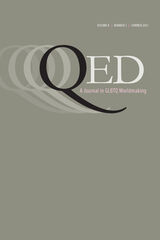 QED: A Journal in GLBTQ Worldmaking 8, no. 2
Charles E. Morris III
Michigan State University Press Journals, 2021 Essays
BbyMutha’s Refusal as Black Queer Feminine Fugitivity
Rico Self, Ashley Noel Mack, and Bryan J. McCann
Networked Grief, Queer Flesh, and Erotic Racism on Instagram’s @theaidsmemorial
Evan Mitchell Schares
Monsters Outside of the Closet: Reading the Queer Art of Winning in The Boulet Brothers’ Dragula
Kai Prins
Forum
Im/Possibilities of Queer/Trans Worldmaking Allies: The Commodification of GLBTQ Pride Movement in the Age of Liberal Capitalism
Shinsuke Eguchi
From Being to Doing: Toward a Reconceptualization of LGBTQ Worldmaking Allies
Gust A. Yep
Cispicious
Lore/tta LeMaster
Queer versus Trans: A False Binary
Lucy Miller
Consent Education as Active Allyship: A Call for Centering Trans and Queer Experiences
Leland G. Spencer and Theresa A. Kulbaga
Occupying the Intersectional Center: Doing Better for Our Communities that Need More
Robert Gutierrez-Perez
Intimate Allyship: Getting Political at the Kitchen Table
Cassidy D. Ellis
A Queer Politics of (Dis)Comfort: On Coalition Building through #FaithfullyLGBT
Austin Williams Miller
Getting Home: With Communication, Love, and Practice
Meshell Sturgis
Navigating Through/Imagining (Im)possibilities for Queer of Color Spaces in the Academy
Michael Tristano, Jr.
“Queer (Un)like Me”: Contesting Sameness, Im/possibilities of Queer/Trans Allyship In Transnational Contexts
Godfried Asante
“But Is You Fam(ily)?”: A Queer Autoethnography on Finding My Place and Making My Own Space in the LGBTQ Community
Elizabeth Y. Whittington
The Subjects of Impolite Conversation: Queering and Transing a Politics of Pleasure
Andrew Spieldenner and Julia R. Johnson
Book Reviews
Insurgent Aesthetics: Security and the Queer Life of the Forever War, by Ronak K. Kapadia
Reviewed by Keisuke Kimura
Evidence of Being: The Black Gay Cultural Renaissance and the Politics of Violence, by Darius Bost
Reviewed by Kidiocus King-Carroll
Beyoncé in Formation: Remixing Black Feminism, by Umise’eke N. Tinsley
Reviewed by Kamela Rasmussen
Open TV: Innovation Beyond Hollywood and the Rise of Web TV, by Aymar Jean Christian
Reviewed by Jared Vázquez
Campuses of Consent: Sexual and Social Justice in Higher Education, by Theresa A. Kulbaga and Leland G. Spencer
Reviewed by Reslie Cortés
Queer Studies: Beyond Binaries, by Bruce Henderson
Reviewed by Alyssa A. Samek
The Borders of AIDS: Race, Quarantine, and Resistance, by Karma R. Chávez
Reviewed by Thomas R. Dunn
Film Reviews
Dilemma of Desire, directed by Maria Finitzo
Reviewed by Rahel Mideska and Allison Rowland
Codependent Lesbian Space Alien Seeks Same, directed by Madeline Olnek
Reviewed by Dani R. Soibelman
Rain Beau’s End, directed by Tracy Wren
Reviewed by Elizabeth Shiller
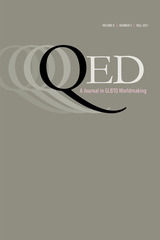 QED: A Journal in GLBTQ Worldmaking 8, no. 3
Charles E. Morris III
Michigan State University Press Journals, 2021 In This Issue
Introduction
Queer Generosity: An Introduction from the Guest Editors
Timothy Oleksiak and Jonathan Alexander
Essays
Surviving Tryin’ Times: Queer Generosity in Anzaldúa, Riggs, and Wojnarowicz
Kimberly Gunter
Non-Love Letters: Asexualizing Queer Love and Generosity
Adam Key and Brontë Pearson
On The Argonauts, Testo Junkie, and Generating Autotheory by Changing Gender
S. Brook Corfman
Minoritarian Affects: Feeling Generosity as a Life Ethic in a Graveyard
Sayan Bhattacharya
Abolitionist Generosities: On Hunger Striking as Queer Refusal
Michelle C. Velasquez-Potts
Queer Conversation
Generously Rude: A Conversation with Myriam Gurba
Jonathan Alexander and Timothy Oleksiak
Forum
Dear Sam; Dear Linda; Love Ames
Ames Hawkins
Sequins and Survival: Queer Bodily Generosity during COVID-19
Laura Tetreault
“Black Women Deserve Great Sex”: The Queer Generosity of KIMBRITIVE
Erin J. Rand
Bisexual Activism: A Love Story
Duc Dau
The Warm Glow of a Pixelated Campfire: Queer Generosity and Community Building in the Worlds of Anna Anthropy
Matthew Hester
Gestures of Ambiguity: A Queer Filipinx-American Choreographic Strategy
Al Evangelista
Through the Kink-Scene Curtain: Sculptural Experience as Generous Uncertainty and Queer Logics of Exchange
Francesca Gentile and Nicolo Gentile
Care Work, Queercrip Labor Politics, and Queer Generosities
Adam Hubrig
Book Reviews
Queering Romantic Engagement in the Postal Age: A Rhetorical Education, by Pamela VanHaitsma
Reviewed by Michael J. Faris
Honeypot: Black Southern Women Who Love Women, by E. Patrick Johnson
Reviewed by Elizabeth Y. Whittington
Progressive Dystopia: Abolition, Antiblackness, + Schooling in San Francisco, by Savannah Shange
Reviewed by Taisha J. McMickens
Trans Exploits: Trans of Color Cultures & Technologies in Movement, by Jian Neo Chen
Reviewed by Erin Watley
Queer Chinese Cultures and Mobilities: Kinship, Migration, and Middle Classes, by John Wei
Reviewed by Zhao Ding
Becoming Human: Matter and Meaning in an Antiblack World, by Zakiyyah Iman Jackson
Reviewed by Jesse A. Goldberg
Disruptive Situations: Fractal Orientalism and Queer Strategies in Beirut, by Ghassan Moussawi
Reviewed by Billy Huff
Film Review
Markie in Milwaukee, directed by Matt Kliegman
Reviewed by Billy Huff
 QED: A Journal in GLBTQ Worldmaking 9, no. 1
Charles E. Morris III
Michigan State University Press Journals, 2022 In This Issue
Introduction
“Every Nigga Is a Star”: A Critical Reflection on the Fifth Anniversary of Moonlight
Jeffrey Q. McCune
Essays
In Moonlight, Perpetually Outside
Isaiah Matthew Wooden
Moving through Trauma: Black Queer Vulnerability in Moonlight
Maurice Tracy
“Don’t Look at Me!”: Deviance and the Uncontrollable Image of Black Motherhood in Moonlight
Terrance Wooten
Forum
The Queerness of Touch: Mutual Recognition and Deep Intimacy in Moonlight
Marlon M. Bailey
“Stay Down”: Moonlight and Negative Affect as an Analytic
Antonia Randolph
On Touching, Where Tender Meets Tough
Godfried Asante
Jesus Died to Guide the Prophet in the Moon’s Blue Chunk
Baba Badji
Book Reviews
Poor Queer Studies: Confronting Elitism in the University, by Matt Brim
Reviewed by Rebekah Jo Aycock
Queer Korea, edited by Todd A. Henry
Reviewed by Seonah Kim
Foucault’s Strange Eros, by Lynne Huffer
Reviewed by Lauren Guilmette
Plague Years: A Doctor’s Journey through the AIDS Crisis, by Ross Slotten
Reviewed by Seth Knievel
Shakespeare and Queer Representation, by Stephen Guy-Bray
Reviewed by Jason Boyd
We Are Everywhere: Protest, Power, and Pride in the History of Queer Liberation, by Matthew Riemer and Leighton Brown
Reviewed by Hunter Thompson
Film Reviews
Frank, directed by Lenny Abrahamson
Reviewed by Paul Walker
Making Sweet Tea, directed by John L. Jackson
Reviewed by Jeffrey Q. McCune
Rafiki, directed by Wanuri Kahiu
Reviewed by Kyéra Sterling
 QED: A Journal in GLBTQ Worldmaking 9, no. 2
Charles E. Morris III
Michigan State University Press Journals, 2022 In This Issue
Essays
Stigma, Tolerance, and Acceptance in the Lives of Sexual and Gender Minority Nebraskans
Natalie R. Holt, Sarah Price, Richard Mocarski, Sharon Obasi, Terrence Z. Huit, Tiff Weekley, Margeret Hall, Shireen S. Rajaram, and Debra A. Hope
“Global in Spirit”: Deep Reading Transgenre
Nishant Shahani
Promise of Anger and Dissident Kinship
Sohini Chatterjee
Here, Queer, and Paranoid! On Acrid Sociality and Collaborating Otherwise
Ryan Conrad and Gary Lee Pelletier
Belief in Hopeless Times: The Once and Future Lesbian in Putin’s Russia and Beyond
Laurie Essig
The Violent Homo, Nationization in Tomer Heymann’s Paper Dolls and Arundhati Roy’s The Ministry of Utmost Happiness
Seul Lee
Queer Conversation
“Demons of the Biocentric Worldview”: A Queer Conversation with Susan Stryker
Travis Alexander
Book Reviews
Literary Modernism, Queer Temporality: Eddies in Time, by Kate Haffey
Anchit Sathi
Sex Panic Rhetorics, Queer Interventions, by Ian Barnard
Karly Louise Poyner-Smith
Jezebel Unhinged: Losing the Black Female Body in Religion & Culture, by Tamura Lomax
Trejha Whitfield
Isherwood in Transit, edited by James J. Berg and Chris Freeman
Brian Fehler
Others of My Kind: Transatlantic Transgender Histories, by Alex Bakker, Rainer Herrn, Michael Thomas Taylor, and Annette F. Timm
Emerson Armstrong
Queer and Trans Migrations: Dynamics of Illegalization, Detention, and Deportation, edited by Eithne Luibhéid and Karma R. Chávez
Sara Baugh-Harris
The Tragedy of Heterosexuality, by Jane Ward
Abigail N. Burns
Film Reviews
The Handmaiden, directed by Park Chan-wook
Jeehyun Jenny Lee and Kate Rich
Bit, directed by Brad Michael Elmor
Pax Attridge
Geeli Pucchi, directed by Neeraj Ghaywan
Aratrika Bose and Dr. Anuja Singh
Framing Agnes, directed by Chase Joynt
E Lev Feinman
 QED: A Journal in GLBTQ Worldmaking 9, no. 3
Charles E. Morris III
Michigan State University Press Journals, 2022 Special Issue: Queer Healing and Transformative Justice
Introduction
Introduction to “Queer Healing and Transformative Justice”: A Special Issue of QED
Alexia Arani and Anna Renée Winget
Essays
Depathologization as Healing Justice
S. M. Rodriguez, H Rakes, Kennedy Healy, and Liat Ben-Moshe
Black Trans Girlhood, Healing, and Transformative Justice in Akwaeke Emezi’s PET
Annie Sansonetti
Entangled Genders: Unraveling Transformative Justice in the Early Childhood Classroom
Dylan Brody
Don’t Count on Us Dying: Carceral Accuracy and Trans-of-Color Life Beyond Hate Crimes
Ren-yo Hwang
Forum
Research as a Practice of Collective Care and Resistance: A Roundtable Conversation with Transmasculine Health Justice: Los Angeles
Sid Jordan and Cydney Brown (authors); Ezak Perez, Gia Ryan Olaes Miramontes, Héctor Planscencia, Jaden Fields, Luckie Alexander, and Lylliam Posadas (contributors)
Stay Mad: A Love Letter to QTBIPOC Psychiatric Survivors
Elliott Fukui
dear abled america
Theresa Gao
No Justice, No Peace: Queer Afghans in Life and Death, from Home to Diasporas
Ahmad Qais Munhazim and Wazina Zondon
(in betweens of healing)
Elias Bouderdaben
Queer(ing) Healing: Reimagining Wellness through Drama Therapy during the Dual Pandemics
Cass Manalastas and Dana Sayre
Solace in the Stars: Queer Astrology, Capitalism, and Colonialism
Christopher Joseph Lee
Embodied Digital Ecologies: A Healing Justice Analysis of How to Survive the End of the World
AK Wright
A Tendr Scene: VR as Visionary Reality, Prototyping Radical Care and Queer Futurities
G Yi
The Magic of the Margins: Rethinking Healing from the Perspective of Queer Exile
Ahmed Awadalla
Survivors “Surviving Well” and “Surviving Poorly”: Reflections on the Limitations and Possibilities of Transformative Justice
Sandra J.
“How We Are with Each Other”: Conversations on Queer Healing and Black Liberation
Qui D. Alexander and Charlene A. Carruthers
Queer Conversation
Queer Behind the Wall: Prison Survival, Self-Love, and Community
Alisha Kohn, Paris E. Whitfield, Kitty Rotolo, and Brian Boles, edited by Jasmine K. Syedullah
Book Reviews
Prismatic Performances: Queer South Africa and the Fragmentation of the Rainbow Nation, by April Sizemore-Barber
Kholofelo M. K. Theledi
Brown Trans Figuration: Rethinking Race, Gender, and Sexuality in Chicanx/Latinx Studies, by Francisco J. Galarte
Michael Tristano, Jr.
Queer Anxieties of Young Adult Literature and Culture, by Derritt Mason
Odhran O’Donoghue
Navigating Remarkable Communication Experiences of Sexual Minorities, by Yachao Li and Jennifer A. Samp
Pamela J. Lannutti
Deportable and Disposable: Public Rhetoric and the Making of “Illegal” Immigrant, by Lisa A. Flores
Oscar Alfonso Mejía
Queering the Global Filipina Body: Contested Nationalism in the Filipina/o Diaspora, by Gina K. Velasco
Anh A. T. Nguyen
Film Review
Montero (Call Me by Your Name), directed by Lil Nas X and Tanu Muino
K. Scarlett Harrington
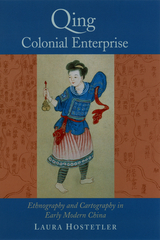 Qing Colonial Enterprise: Ethnography and Cartography in Early Modern China
Laura Hostetler
University of Chicago Press, 2001 In Qing Colonial Enterprise, Laura Hostetler shows how Qing China (1636-1911) used cartography and ethnography to pursue its imperial ambitions. She argues that far from being on the periphery of developments in the early modern period, Qing China both participated in and helped shape the new emphasis on empirical scientific knowledge that was simultaneously transforming Europe—and its colonial empires—at the time.
Although mapping in China is almost as old as Chinese civilization itself, the Qing insistence on accurate, to-scale maps of their territory was a new response to the difficulties of administering a vast and growing empire. Likewise, direct observation became increasingly important to Qing ethnographic writings, such as the illustrated manuscripts known as "Miao albums" (from which twenty color paintings are reproduced in this book). These were intended to educate Qing officials about various non-Han peoples so that they could govern these groups more effectively.Hostetler's groundbreaking account will interest anyone studying the history of the early modern period and colonialism.
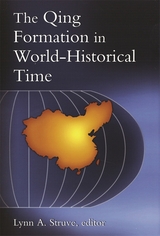 The Qing Formation in World-Historical Time
Lynn A. Struve
Harvard University Press, 2004 For many years, the Ming and Qing dynasties have been grouped as “late imperial China,” a temporal framework that allows scholars to identify and evaluate indigenous patterns of social, economic, and cultural change initiated in the last century of Ming rule that imparted a particular character to state and society throughout the Qing and into the twentieth century. This paradigm asserts the autonomous character of social change in China and has allowed historians to create a “China-centered history.” Recently, however, many scholars have begun emphasizing the singular qualities of the Qing.
Among the eight contributors to this volume on the formation of the Qing, those who emphasize the Manchu ethos of the Qing tend to see it as part of an early modernity and stress parallel and sometimes mutually reinforcing patterns of political consolidation and cultural integration across Eurasia. Other contributors who examine the Qing formation from the perspective of those who lived through the dynastic transition see the advent of Qing rule as prompting attempts by the Chinese subjects of the new empire to make sense of what they perceived as a historical disjuncture and to rework these understandings into an accommodation to foreign rule. In contrast to the late imperial paradigm, the new ways of configuring the Qing in historical time in both groups of essays assert the singular qualities of the Qing formation.
QRB vol 88 num 1
The University of Chicago Press
University of Chicago Press Journals, 2013
QRB vol 88 num 2
The University of Chicago Press
University of Chicago Press Journals, 2013
QRB vol 88 num 3
The University of Chicago Press
University of Chicago Press Journals, 2013
QRB vol 88 num 4
The University of Chicago Press
University of Chicago Press Journals, 2013
QRB vol 89 num 1
The University of Chicago Press
University of Chicago Press Journals, 2014
QRB vol 89 num 2
The University of Chicago Press
University of Chicago Press Journals, 2014
QRB vol 89 num 3
The University of Chicago Press
University of Chicago Press Journals, 2014
QRB vol 89 num 4
The University of Chicago Press
University of Chicago Press Journals, 2014
QRB vol 90 num 1
The University of Chicago Press
University of Chicago Press Journals, 2015
QRB vol 90 num 2
The University of Chicago Press
University of Chicago Press Journals, 2015
QRB vol 90 num 3
The University of Chicago Press
University of Chicago Press Journals, 2015
QRB vol 90 num 4
The University of Chicago Press
University of Chicago Press Journals, 2015
QRB vol 91 num 1
The University of Chicago Press
University of Chicago Press Journals, 2016
QRB vol 91 num 2
The University of Chicago Press
University of Chicago Press Journals, 2016
QRB vol 91 num 3
The University of Chicago Press
University of Chicago Press Journals, 2016
QRB vol 91 num 4
The University of Chicago Press
University of Chicago Press Journals, 2016
QRB vol 92 num 1
The University of Chicago Press
University of Chicago Press Journals, 2017
QRB vol 92 num 2
The University of Chicago Press
University of Chicago Press Journals, 2017
QRB vol 92 num 3
The University of Chicago Press
University of Chicago Press Journals, 2017
QRB vol 92 num 4
The University of Chicago Press
University of Chicago Press Journals, 2017
QRB vol 93 num 1
The University of Chicago Press
University of Chicago Press Journals, 2018
QRB vol 93 num 2
The University of Chicago Press
University of Chicago Press Journals, 2018
QRB vol 93 num 3
The University of Chicago Press
University of Chicago Press Journals, 2018
QRB vol 93 num 4
The University of Chicago Press
University of Chicago Press Journals, 2018
QRB vol 94 num 1
The University of Chicago Press
University of Chicago Press Journals, 2019
QRB vol 94 num 2
The University of Chicago Press
University of Chicago Press Journals, 2019
QRB vol 94 num 3
The University of Chicago Press
University of Chicago Press Journals, 2019
QRB vol 94 num 4
The University of Chicago Press
University of Chicago Press Journals, 2019
QRB vol 95 num 1
The University of Chicago Press
University of Chicago Press Journals, 2020
QRB vol 95 num 2
The University of Chicago Press
University of Chicago Press Journals, 2020
QRB vol 95 num 3
The University of Chicago Press
University of Chicago Press Journals, 2020 This is volume 95 issue 3 of The Quarterly Review of Biology. The Quarterly Review of Biology (QRB) has presented insightful historical, philosophical, and technical treatments of important biological topics since 1926. As the premier review journal in biology, the QRB publishes outstanding review articles of generous length that are guided by an expansive, inclusive, and often humanistic understanding of biology. Beyond the core biological sciences, the QRB is also an important review journal for scholars in related areas, including policy studies and the history and philosophy of science. A comprehensive section of reviews on new biological books provides educators and researchers with information on the latest publications in the life sciences.
QRB vol 95 num 4
The University of Chicago Press
University of Chicago Press Journals, 2020
QRB vol 96 num 1
The University of Chicago Press
University of Chicago Press Journals, 2021
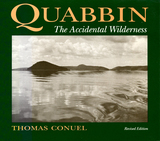 Quabbin: The Accidental Wilderness
Thomas Conuel
University of Massachusetts Press, 1990 When one looks out on the quiet waters and forested hills of Quabbin Reservoir in west central Massachusetts, it is hard to imagine that the area was once dotted with buildings and farmlands or that it echoed with the activity of several villages and towns. Today, the daytime silence may be broken only by the cry of a hawk overhead or the slap of a plunging fish, and the evening calm, by the lonesome howl of a coyote. But in the nineteenth century, things were quite different.
In 1895, engineers for the Metropolitan Water Board began to search the state of Massachusetts for a site on which to construct a reservoir to supply water for the growing city of Boston. Sixty-five miles west of the city, in a region of high hills and running streams known as the Swift River Valley, they found what they were looking for. When Quabbin Reservoir was finally completed and filled in 1946, the engineers had created the third largest body of fresh water in New England and hand accomplished one of the larger public works projects of its time. They had also uprooted and displaced the valley's inhabitants, leveled and flooded four towns and six villages--and formed a magnificent wilderness on some 85,000 acres.
The valley that was once known for its picturesque villages and mill ponds is now, over forty years later, home to a wide array of wildlife. Coyote, bobcat, and deer flourish, and Quabbin's eagle restoration project, begun in 1982, produced the first nesting pair of bald eagles in Massachusetts in almost a century. Today, the bald eagle population at Quabbin is estimated at forty-one birds.
But this accidental wilderness is being increasingly threatened. As early as the 1950s, the sounds of power boats occasionally intruded on the peaceful silence of the waters. In more recent years, acid rain, ozone and other pollutants, the ravages of a herd of hungry deer, and demands for increased recreational use are all jeopardizing Quabbin's waters and forests.
This book tells the story of Quabbin, tracing Quabbin's history, describing its natural resources, and discussing the environmental challenges it currently faces. The original edition, issued by the Massachusetts Audubon Society in 1981, has now been expanded and updated.
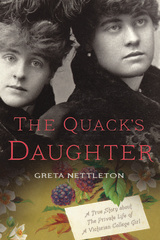 The Quack's Daughter: A True Story about the Private Life of a Victorian College Girl, Revised Edition
Greta Nettleton
University of Iowa Press, 2014 Raised in the gritty Mississippi River town of Davenport, Iowa, Cora Keck could have walked straight out of a Susan Glaspell story. When Cora was sent to Vassar College in the fall of 1884, she was a typical unmotivated, newly rich party girl. Her improbable educational opportunity at “the first great educational institution for womankind” turned into an enthralling journey of self-discovery as she struggled to meet the high standards in Vassar’s School of Music while trying to shed her reputation as the daughter of a notorious quack and self-made millionaire: Mrs. Dr. Rebecca J. Keck, second only to Lydia Pinkham as America’s most successful self-made female patent medicine entrepreneur of the time.
This lively, stereotype-shattering story might have been lost, had Cora’s great-granddaughter, Greta Nettleton, not decided to go through some old family trunks instead of discarding most of the contents unexamined. Inside she discovered a rich cache of Cora’s college memorabilia—essential complements to her 1885 diary, which Nettleton had already begun to read. The Quack’s Daughter details Cora’s youthful travails and adventures during a time of great social and economic transformation. From her working-class childhood to her gilded youth and her later married life, Cora experienced triumphs and disappointments as a gifted concert pianist that the reader will recognize as tied to the limited opportunities open to women at the turn of the twentieth century, as well as to the dangerous consequences for those who challenged social norms.
Set in an era of surging wealth torn by political controversy over inequality and women’s rights and widespread panic about domestic terrorists, The Quack’s Daughter is illustrated with over a hundred original images and photographs that illuminate the life of a spirited and charming heroine who ultimately faced a stark life-and-death crisis that would force her to re-examine her doubts about her mother’s medical integrity.
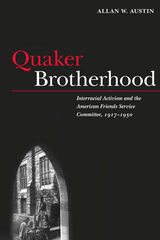 Quaker Brotherhood: Interracial Activism and the American Friends Service Committee, 1917-1950
Allan W. Austin
University of Illinois Press, 2012 The Religious Society of Friends and its service organization, the American Friends Service Committee (AFSC) have long been known for their peace and justice activism. The abolitionist work of Friends during the antebellum era has been well documented, and their contemporary anti-war and anti-racism work is familiar to activists around the world. Quaker Brotherhood is the first extensive study of the AFSC's interracial activism in the first half of the twentieth century, filling a major gap in scholarship on the Quakers' race relations work from the AFSC's founding in 1917 to the beginnings of the civil rights movement in the early 1950s. Allan W. Austin tracks the evolution of key AFSC projects such as the Interracial Section and the American Interracial Peace Committee, which demonstrate the tentativeness of the Friends' activism in the 1920s, as well as efforts in the 1930s to make scholarly ideas and activist work more theologically relevant for Friends. Documenting the AFSC's efforts to help European and Japanese American refugees during World War II, Austin shows that by 1950, Quakers in the AFSC had honed a distinctly Friendly approach to interracial relations that combined scholarly understandings of race with their religious views. In tracing the transformation of one of the most influential social activist groups in the United States over the first half of the twentieth century, Quaker Brotherhood presents Friends in a thoughtful, thorough, and even-handed manner. Austin portrays the history of the AFSC and race--highlighting the organization's boldness in some aspects and its timidity in others--as an ongoing struggle that provides a foundation for understanding how shared agency might function in an imperfect and often racist world. Highlighting the complicated and sometimes controversial connections between Quakers and race during this era, Austin uncovers important aspects of the history of Friends, pacifism, feminism, American religion, immigration, ethnicity, and the early roots of multiculturalism.
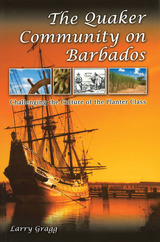 The Quaker Community on Barbados: Challenging the Culture of the Planter Class
Larry Gragg
University of Missouri Press, 2009 Prior to the Quakers’ large-scale migration to Pennsylvania, Barbados had more Quakers than any other English colony. But on this island of sugar plantations, Quakers confronted material temptations and had to temper founder George Fox’s admonitions regarding slavery with the demoralizing realities of daily life in a slave-based economy—one where even most Quakers owned slaves. In The Quaker Community on Barbados, Larry Gragg shows how the community dealt with these contradictions as it struggled to change the culture of the richest of England’s seventeenth-century colonies.
Gragg has conducted meticulous research on two continents to re-create the Barbados Quaker community. Drawing on wills, censuses, and levy books along with surviving letters, sermons, and journals, he tells how the Quakers sought to implement their beliefs in peace, simplicity, and equality in a place ruled by a planter class that had built its wealth on the backs of slaves. He reveals that Barbados Quakers were a critical part of a transatlantic network of Friends and explains how they established a “counterculture” on the island—one that challenged the practices of the planter class and the class’s dominance in island government, church, and economy.
In this compelling study, Gragg focuses primarily on the seventeenth century when the Quakers were most numerous and active on Barbados. He tells how Friends sought to convert slaves and improve their working and living conditions. He describes how Quakers refused to fund the Anglican Church, take oaths, participate in the militia, or pay taxes to maintain forts—and how they condemned Anglican clergymen, disrupted their services, and wrote papers critical of the established church. By the 1680s, Quakers were maintaining five meetinghouses and several cemeteries, paying for their own poor relief, and keeping their own records of births, deaths, and marriages. Gragg also tells of the severe challenges and penalties they faced for confronting and rejecting the dominant culture.
With their civil disobedience and stand on slavery, Quakers on Barbados played an important role in the early British Empire but have been largely neglected by scholars. Gragg’s work makes their contribution clear as it opens a new window on the seventeenth- and eighteenth-century Atlantic world.
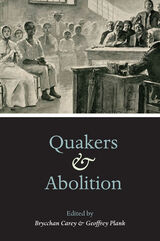 Quakers and Abolition
Edited by Brycchan Carey and Geoffrey Plank
University of Illinois Press, 2014 This collection of fifteen insightful essays examines the complexity and diversity of Quaker antislavery attitudes across three centuries, from 1658 to 1890. Contributors from a range of disciplines, nations, and faith backgrounds show Quaker's beliefs to be far from monolithic. They often disagreed with one another and the larger antislavery movement about the morality of slaveholding and the best approach to abolition. Not surprisingly, contributors explain, this complicated and evolving antislavery sensibility left behind an equally complicated legacy. While Quaker antislavery was a powerful contemporary influence in both the United States and Europe, present-day scholars pay little substantive attention to the subject. This volume faithfully seeks to correct that oversight, offering accessible yet provocative new insights on a key chapter of religious, political, and cultural history. Contributors include Dee E. Andrews, Kristen Block, Brycchan Carey, Christopher Densmore, Andrew Diemer, J. William Frost, Thomas D. Hamm, Nancy A. Hewitt, Maurice Jackson, Anna Vaughan Kett, Emma Jones Lapsansky-Werner, Gary B. Nash, Geoffrey Plank, Ellen M. Ross, Marie-Jeanne Rossignol, James Emmett Ryan, and James Walvin.
 Quakers and Abolition
Brycchan Carey
University of Illinois Press, 2018 This collection of fifteen insightful essays examines the complexity and diversity of Quaker antislavery attitudes across three centuries, from 1658 to 1890. Contributors from a range of disciplines, nations, and faith backgrounds show Quaker's beliefs to be far from monolithic. They often disagreed with one another and the larger antislavery movement about the morality of slaveholding and the best approach to abolition. Not surprisingly, contributors explain, this complicated and evolving antislavery sensibility left behind an equally complicated legacy. While Quaker antislavery was a powerful contemporary influence in both the United States and Europe, present-day scholars pay little substantive attention to the subject. This volume faithfully seeks to correct that oversight, offering accessible yet provocative new insights on a key chapter of religious, political, and cultural history. Contributors include Dee E. Andrews, Kristen Block, Brycchan Carey, Christopher Densmore, Andrew Diemer, J. William Frost, Thomas D. Hamm, Nancy A. Hewitt, Maurice Jackson, Anna Vaughan Kett, Emma Jones Lapsansky-Werner, Gary B. Nash, Geoffrey Plank, Ellen M. Ross, Marie-Jeanne Rossignol, James Emmett Ryan, and James Walvin.
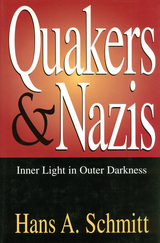 Quakers and Nazis: Inner Light in Outer Darkness
Hans A. Schmitt
University of Missouri Press, 1997
Why the title Quakers and Nazis, not Quakers against Nazis? Was not hostility part of the interaction between the two groups? On the contrary, Hans A. Schmitt's compelling story describes American, British, and German Quakers' attempts to mitigate the suffering among not only victims of Nazism but Nazi sympathizers in Austria and Lithuania as well.
With numerous poignant illustrations of the pressure and social cost involved in being a Quaker from 1933 to 1945, Quakers and Nazis: Inner Light in Outer Darkness reveals a facet of Nazi Germany that is entirely unknown to most people. The book focuses on the heroic acts foreign and German Quakers performed under the Nazi regime, offering fully documented and original information regarding the Quakers' commitment to nonviolence and the relief of the victims.
Schmitt's narrative reveals the stress and tension of the situation. How should a Quaker behave in a meeting for worship with a policeman present? Spies did not stop Friends in worship services from openly criticizing Hitler and Göring, but Nazis did inflict torment on Friends. Yet Friends did not, could not, respond in like manner. Olga Halle was one Friend who worked to get people, mostly Jews, out of Germany until America entered the war. When emigration was outlawed, twenty-eight were stranded. Years later her distress was still so deep that even on her deathbed she recited their names.
Schmitt reminds us that virtually all the Berlin Quakers secreted Jews throughout the war. He shows how these brave Quakers opposed the Nazis even after they lost their jobs and had been harassed by the Gestapo. Risking their lives, the Friends persisted in their efforts to alleviate suffering.
At a time when the scholarly world is divided as to whether all Germans knew and approved of the Final Solution, this book makes a valuable contribution to the discussion. Quakers—despite their small numbers—played, and continue to play, an important role in twentieth-century humanitarian relief. Quakers and Nazis: Inner Light in Outer Darkness, a study of how Friends performed under the extreme pressure of a totalitarian regime, will add significantly to our general understanding of Quaker and German history.
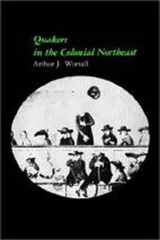 Quakers in the Colonial Northeast
Arthur J. Worrall
University Press of New England, 2002 This book traces the Quaker experience in New England and New York from the Arrival of the first English Quaker missionaries in 1646 to 1790. The first Friends faced considerable hostility, so much so that it took almost eighty years for Quakers and their antagonists to solve their differences. By then, Quakers had settled into a comfortable period of numerical increase, and, to the extent that colonies permitted, participated as individuals in colonial political life. During the early eighteenth century Quaker organizational and disciplinary structures derived from the late seventeenth century underwent gradual evolution, but not to the extent of altering the basically comfortable arrangement that served to promote the growth of Friends. After 1750, however, Quakers throughout the colonies entered a period of reform, a reform that led to a numerical decline in older centers and to a drastic reduction in numerical growth. Reform ultimately caused Friends to sharpen their positions on antislavery and pacifism and led to a withdrawal from political participation. Ultimately, it pointed the way to the disastrous nineteenth-century Quaker schisms.
Quakertown
Lee Martin
Ohio State University Press, 2017 In Quakertown, Lee Martin travels back in time to 1920s Texas to tell the story of a flourishing black community that was segregated from its white brethren—and of the remarkable gardener who was asked to do the unimaginable.
Based on the true story of a shameful episode in north Texas history, Quakertown draws on the rich texture of the South—the Pecan Creek running along the edges of Quakertown, the remarkable and rare white lilac, and the rising tensions marking each nod and greeting. With strength and a deep wisdom of heart, Martin carves out the delicate story of two families—one white and one black—and the child whose birth brought a gift of forgiveness.
Suffused with Martin’s deep compassion and profound humanity, Quakertown is an unforgettable novel from a master of American prose.
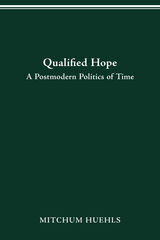 Qualified Hope: A Postmodern Politics of Time
Mitchum Huehls
Ohio State University Press, 2009 What is the political value of time, and where does that value reside? Should politics place its hope in future possibility, or does that simply defer action in the present? Can the present ground a vision of change, or is it too circumscribed by the status quo? In Qualified Hope: A Postmodern Politics of Time, Mitchum Huehls contends that conventional treatments of time’s relationship to politics are limited by a focus on real-world experiences of time. By contrast, the innovative literary forms developed by authors in direct response to political events such as the Cold War, globalization, the emergence of identity politics, and 9/11 offer readers uniquely literary experiences of time. And it is in these literary experiences of time that Qualified Hope identifies more complicated—and thus more productive—ways to think about the time-politics relationship. Qualified Hope challenges the conventional characterization of postmodernism as a period in which authors reject time in favor of space as the primary category for organizing experience and knowledge. And by identifying a common commitment to time at the heart of postmodern literature, Huehls suggests that the period-defining divide between multiculturalism and theory is not as stark as previously thought.
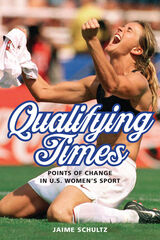 Qualifying Times: Points of Change in U.S. Women's Sport
Jaime Schultz
University of Illinois Press, 2014 This perceptive, lively study explores U.S. women's sport through historical "points of change": particular products or trends that dramatically influenced both women's participation in sport and cultural responses to women athletes.
Beginning with the seemingly innocent ponytail, the subject of the Introduction, scholar Jaime Schultz challenges the reader to look at the historical and sociological significance of now-common items such as sports bras and tampons and ideas such as sex testing and competitive cheerleading. Tennis wear, tampons, and sports bras all facilitated women’s participation in physical culture, while physical educators, the aesthetic fitness movement, and Title IX encouraged women to challenge (or confront) policy, financial, and cultural obstacles.
While some of these points of change increased women's physical freedom and sporting participation, they also posed challenges. Tampons encouraged menstrual shame, sex testing (a tool never used with male athletes) perpetuated narrowly-defined cultural norms of femininity, and the late-twentieth-century aesthetic fitness movement fed into an unrealistic beauty ideal.
Ultimately, Schultz finds that U.S. women's sport has progressed significantly but ambivalently. Although participation in sports is no longer uncommon for girls and women, Schultz argues that these "points of change" have contributed to a complex matrix of gender differentiation that marks the female athletic body as different than--as less than--the male body, despite the advantages it may confer.
 Qualitative Comparative Analysis: An Introduction to Research Design and Application
Patrick A. Mello
Georgetown University Press, 2022 A comprehensive and accessible guide to learning and successfully applying QCA Social phenomena can rarely be attributed to single causes—instead, they typically stem from a myriad of interwoven factors that are often difficult to untangle. Drawing on set theory and the language of necessary and sufficient conditions, qualitative comparative analysis (QCA) is ideally suited to capturing this causal complexity. A case-based research method, QCA regards cases as combinations of conditions and compares the conditions of each case in a structured way to identify the necessary and sufficient conditions for an outcome. Qualitative Comparative Analysis: An Introduction to Research Design and Application is a comprehensive guide to QCA. As QCA becomes increasingly popular across the social sciences, this textbook teaches students, scholars, and self-learners the fundamentals of the method, research design, interpretation of results, and how to communicate findings. Following an ideal typical research cycle, the book’s ten chapters cover the methodological basis and analytical routine of QCA, as well as matters of research design, causation and causal complexity, QCA variants, and the method’s reception in the social sciences. A comprehensive glossary helps to clarify the meaning of frequently used terms. The book is complemented by an accessible online R manual to help new users to practice QCA’s analytical steps on sample data and then implement with their own findings. This hands-on textbook is an essential resource for students and researchers looking for a complete and up-to-date introduction to QCA.
 Qualitative Modeling of Complex Systems: An Introduction to Loop Analysis and Time Averaging
Charles J. Puccia and Richard Levins
Harvard University Press, 1985 In this modern era of mathematical modeling, applications have become increasingly complicated. As the complexity grows, it becomes more and more difficult to draw meaningful conclusions about the behavior of theoretical models and their relations to reality. Alongside methods that emphasize quantitative properties and the testing of scientific details, there is a need for approaches that are more qualitative. These techniques attempt to cover whole families of models in one bold stroke, in a manner that allows robust conclusions to be drawn about them.
Loop analysis and time averaging provide a means of interpreting the properties of systems from the network of interactions within the system. The authors' methodology concentrates on graphical representation to guide experimental design, to identify sources of external variability from the statistical pattern of variables, and to make management decisions.
Although most of the examples are drawn from ecology, the methods are relevant to all of the pure and applied sciences. This relevance is enhanced by case studies from such diverse areas as physiology, resource management, the behavioral sciences, and social epidemiology. The book will be useful to a broad readership from the biological and social sciences as well as the physical sciences and technology. It will interest undergraduate and graduate students along with researchers active in these disciplines. Here the reader will find a strong rationale for maintaining a holistic approach, revealing what insights and advantages are retained by the broader perspective and, more explicitly, by the synergistic effects that cannot be discerned by reducing systems to their smallest parts.
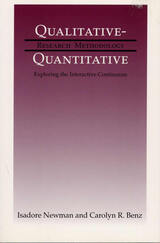 Qualitative-Quantitative Research Methodology: Exploring the Interactive Continuum
Isadore Newman and Carolyn R. Benz
Southern Illinois University Press, 1998
Rejecting the artificial dichotomy between qualitative and quantitative research strategies in the social and behavioral sciences, Isadore Newman and Carolyn R. Benz argue that the two approaches are neither mutually exclusive nor interchangeable; rather, the actual relationship between the two paradigms is one of isolated events on a continuum of scientific inquiry.
Through graphic and narrative descriptions, Newman and Benz show research to be a holistic endeavor in the world of inquiry. To clarify their argument, they provide a diagram of the "qualitative-quantitative interactive continuum" showing that qualitative analysis with its feedback loops can easily modify the types of research questions asked in quantitative research and that the quantitative results and its feedback can change what will be asked qualitatively.
In their model for research—an "interactive continuum"—Newman and Benz emphasize four major points: the research question dictates the selection of research methods; consistency between question and design can lead to a method of critiquing research studies in professional journals; the interactive continuum model is built around the place of theory; and the assurance of "validity" of research is central to all studies.
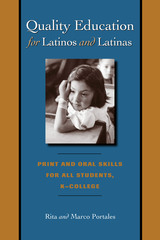 Quality Education for Latinos and Latinas: Print and Oral Skills for All Students, K–College
By Rita and Marco Portales
University of Texas Press, 2005 As educators and legislators across the country debate how to improve public schools, the most vital factor often disappears from the equation—the relationship between the teacher and the student. According to veteran educators Rita and Marco Portales, this relationship is the central issue in the education of students, especially Latino/a students who often face serious barriers to school success because of the legacy of racism, insufficient English-language skills, and cultural differences with the educational establishment. To break down these barriers and help Latino/a students acquire a quality education, the Portaleses focus attention on the teacher-student relationship and offer a proven method that teachers can use to strengthen the print and oral skills of their students. They begin by analyzing the reasons why schools too often fail to educate Latino/a students, using eloquent comments from young Latinos/as and their parents to confirm how important the teacher-student relationship is to the student's success. Then they show how all educational stakeholders—teachers, administrators, state education agencies, legislators, and parents—can work together to facilitate the teacher-student relationship and improve student education. By demonstrating how teachers can improve students' reading, critical thinking, writing, and oral communication skills across the curriculum, they argue that learning can be made more relevant for students, keeping their interest levels high while preparing them for academically competitive colleges.
 Quality Maintenance in Stored Grains and Seeds
Clyde M. Christensen and Richard A. Meronuck
University of Minnesota Press, 1986 Quality Maintenance in Stored Grains and Seeds was first published in 1986. Minnesota Archive Editions uses digital technology to make long-unavailable books once again accessible, and are published unaltered from the original University of Minnesota Press editions. Storage molds are a major cause of quality loss in grains and seeds held in farm bins and tanks, in commercial elevators and warehouses, and in barge and ship transport. The damage done by these storage molds is at first invisible, but later shows up as caking, mustiness, total spoilage of part or all of the grain, and heating - sometimes to the temperature of ignition. The authors, both of whom have had extensive first-hand field and laboratory experience with these grain storage fungi and the problems they cause, summarize in readable and readily understandable form the basic principles and specific practices to be followed in order to minimize such losses. Chapters are devoted to grain grades and quality; storage fungi; conditions that promote or prevent loss in quality; spoilage in barge and ship transport; mycotoxins (toxic compounds produced by fungi growing in grains and feeds) and mycotoxicoses (the diseases caused in animals that consume such toxic products); insects, mites, and storage fungi, quality control; and identification of storage fungi as an aid in evaluation of grain condition and storability.
The Quality of American Life: Perceptions, Evaluations, and Satisfactions
Angus Campbell
Russell Sage Foundation, 1976 Considers how Americans define the quality of their life experiences, as expressed in their perceptions, evaluations, and satisfactions. Based on research conducted by the Institute for Social Research at the University of Michigan, the book uses data which are representative of the national population eighteen years of age and older, and employs the major social characteristics of class, age, education, and income. The authors cover such topics as the residential environment, the experience of work, marriage, and family life, and personal resources and competence. They also report on the situation of women and the quality of the life experience of black people.
Quality of Care for PTSD and Depression in the Military Health System: Phase I Report
Kimberly A. Hepner
RAND Corporation, 2016 Understanding the current quality of care for posttraumatic stress disorder (PTSD) and depression delivered to service members is an important step toward improving care across the Military Health System (MHS). T.his report describes the characteristics of active-component service members who received care for PTSD or depression through the MHS and assesses the quality of care received using quality measures derived from administrative data
The Quality of Divided Democracies: Minority Inclusion, Exclusion, and Representation in the New Europe
Licia Cianetti
University of Michigan Press, 2019 The Quality of Divided Democracies contemplates how democracy works, or fails to work, in ethnoculturally divided societies. It advances a new theoretical approach to assessing quality of democracy in divided societies, and puts it into practice with the focused comparison of two divided democracies—Estonia and Latvia. The book uses rich comparative data to tackle the vital questions of what determines a democracy’s level of inclusiveness and the ways in which minorities can gain access to the policy-making process. It uncovers a “presence–polarization dilemma” for minorities’ inclusion in the democratic process, which has implications for academic debates on minority representation and ethnic politics, as well as practical implications for international and national institutions’ promotion of minority rights.
 The Quality of Education in Developing Countries
C. E. Beeby
Harvard University Press Advanced countries of the world have taken a hundred years to work out systems of primary education reasonably well adapted to the needs of their communities and to the varied capacities of the children in their schools; today many of the developing countries are trying to do the same thing in a decade. At first sight it might appear that with the help and experience of the developed word they could leap a century and establish straight away something approaching the modern classroom without having to plod through the stage of dreary formalism that marked the first fifty years of our system of compulsory education, in much the same way that many of them have been ushered into the air-age without ever knowing the smoke and dirt of a nineteenth-century railway system.
As Director of Education for New Zealand, with responsibilities also in Western Samoa and in New Zealand's Pacific Islands dependencies, for many years C. E. Beeby had to deal with two educational systems at very different levels of development. He reluctantly comes to the conclusion that new countries cannot simply adopt the systems that have evolved in other nations. He argues that an educational system of high quality must develop in distinct stages through which all systems, at least of a certain type, must pass, and which, though they may be shortened, cannot be skipped. Two main factors determine the stage of development of any primary school system: the level of general education of its teachers, and the length and type of their professional training.
Beeby emphasizes the need for young countries to maintain high educational standards in the face of an explosion of demand for schooling. He comments controversially on the respective roles of the economist and the educator in educational planning and on the need for a truly educational theory of growth to balance the economic theories that have tended to dominate educational planning. In a chapter as significant for developed countries as for emergent ones, he discusses conservatism in education and the peculiar pattern of resistance to change among the teaching profession. Beeby concludes with an examination of the difficulties young nations encounter in attempting to solve some of their problems through the application of new educational technology, and he describes the investigation that must be undertaken before one may assume that the new techniques and media can materially affect educational planning in these countries over the next decade.
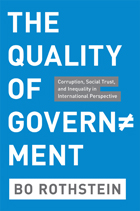 The Quality of Government: Corruption, Social Trust, and Inequality in International Perspective
Bo Rothstein
University of Chicago Press, 2011 The relationship between government, virtue, and wealth has held a special fascination since Aristotle, and the importance of each frames policy debates today in both developed and developing countries. While it’s clear that low-quality government institutions have tremendous negative effects on the health and wealth of societies, the criteria for good governance remain far from clear. In this pathbreaking book, leading political scientist Bo Rothstein provides a theoretical foundation for empirical analysis on the connection between the quality of government and important economic, political, and social outcomes. Focusing on the effects of government policies, he argues that unpredictable actions constitute a severe impediment to economic growth and development—and that a basic characteristic of quality government is impartiality in the exercise of power. This is borne out by cross-sectional analyses, experimental studies, and in-depth historical investigations. Timely and topical, The Quality of Government tackles such issues as political legitimacy, social capital, and corruption.
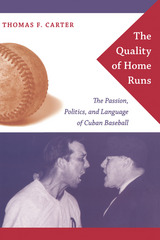 The Quality of Home Runs: The Passion, Politics, and Language of Cuban Baseball
Thomas F. Carter
Duke University Press, 2008 In parks and cafes, homes and stadium stands, Cubans talk baseball. Thomas F. Carter contends that when they are analyzing and debating plays, games, teams, and athletes, Cubans are exchanging ideas not just about baseball but also about Cuba and cubanidad, or what it means to be Cuban. The Quality of Home Runs is Carter’s lively ethnographic exploration of the interconnections between baseball and Cuban identity. Suggesting that baseball is in many ways an apt metaphor for cubanidad, Carter points out aspects of the sport that resonate with Cuban social and political life: the perpetual tension between risk and security, the interplay between individual style and collective regulation, and the risky journeys undertaken with the intention, but not the guarantee, of returning home. As an avid baseball fan, Carter draws on his experiences listening to and participating in discussions of baseball in Cuba (particularly in Havana) and among Cubans living abroad to describe how baseball provides the ground for negotiations of national, masculine, and class identities wherever Cubans gather. He considers the elaborate spectacle of Cuban baseball as well as the relationship between the socialist state and the enormously popular sport. Carter provides a detailed history of baseball in Cuba, analyzing players, policies, rivalries, and fans, and he describes how the sport has forged connections (or reinforced divisions) between Cuba and other nations. Drawing on insights from cultural studies, political theory, and anthropology, he maintains that sport and other forms of play should be taken seriously as crucibles of social and cultural experience.
The Quality of Life Report: A Novel
By Meghan Daum, Foreword by Curtis Sittenfeld
University of Texas Press, 2017 Meghan Daum's unforgettable debut novel brings her sharp wit and courageous social commentary to the story of Lucinda Trout, a New York television reporter in search of greener pastures. Moving to the slower-paced, friendly, and vastly more affordable Midwestern town of Prairie City, Lucinda zealously creates a series of televised reports for her New York audience about her newfound quality of life. But when Lucinda falls for eccentric local Mason Clay, her naïveté about the real world leads her down an unexpected path, where she encounters, among other things, a drafty old farmhouse filled with children, an ever-growing menagerie of farm animals, and the harshest winter the region has seen in twenty years. In other words, simplicity just isn't as simple as it is cracked up to be, and "quality of life," Lucinda learns, is much more complicated than she ever imagined.
 A Quality of Loss
Mcinerny
St. Augustine's Press, 2025 The world in the 1970s was a cultural upheaval in many respects. This novel is a story of the deepest disruption but in the quietest and most hidden of places––namely, a monk living in isolation who is turned upside down by recent developments in the Catholic Church motivated by post-modern plans. Brother Martin journals what he doesn't identify as confusion in D.Q. McInerny's debut novel that paints the portrait of a period in history that many are only now taking more seriously. What happened before the turn into the new millennium, and why are the effects of Vatican Council II more obvious and influential now than they were in the immediate wake of this council? The story of Brother Martin is a time capsule for many readers, but for others it is an insight into life that was stubbornly resistant to modern thinking in favor of the transcendent and eternal with respect to spirituality. McInerny shows through story-telling how much the institution was anything but a hinderance to the human soul and how much we may have lost by rejecting old forms on the sole basis of not having come up with them ourselves. This story is a generational bridge and reveals religious life in a truthful and still generous light.
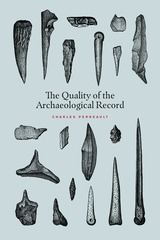 The Quality of the Archaeological Record
Charles Perreault
University of Chicago Press, 2019 Paleobiology struggled for decades to influence our understanding of evolution and the history of life because it was stymied by a focus on microevolution and an incredibly patchy fossil record. But in the 1970s, the field took a radical turn, as paleobiologists began to investigate processes that could only be recognized in the fossil record across larger scales of time and space. That turn led to a new wave of macroevolutionary investigations, novel insights into the evolution of species, and a growing prominence for the field among the biological sciences.
In The Quality of the Archaeological Record, Charles Perreault shows that archaeology not only faces a parallel problem, but may also find a model in the rise of paleobiology for a shift in the science and theory of the field. To get there, he proposes a more macroscale approach to making sense of the archaeological record, an approach that reveals patterns and processes not visible within the span of a human lifetime, but rather across an observation window thousands of years long and thousands of kilometers wide. Just as with the fossil record, the archaeological record has the scope necessary to detect macroscale cultural phenomena because it can provide samples that are large enough to cancel out the noise generated by micro-scale events. By recalibrating their research to the quality of the archaeological record and developing a true macroarchaeology program, Perreault argues, archaeologists can finally unleash the full contributive value of their discipline.
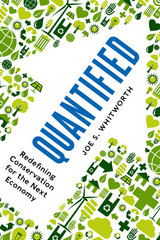 Quantified: Redefining Conservation for the Next Economy
Joe Whitworth
Island Press, 2015 Conservation doesn't have to be slow, vague, or sidelined. In Quantified, Joe Whitworth lays out a results-driven approach that brings the precision and impact of Silicon Valley into the heart of environmental work. Drawing on strategies used by high-performing companies—clear metrics, bold targets, real-time data—Whitworth shows how environmental efforts can move from well-intentioned to high-impact.
As president of The Freshwater Trust, Whitworth has helped reimagine river restoration using what he calls "quantified conservation": a method that uses rigorous data, innovative technology, and measurable outcomes to deliver environmental progress with the speed and certainty of a start-up. Quantified offers compelling case studies from this work, particularly in water conservation, but the approach applies far beyond rivers—to climate, land use, agriculture, and beyond.
This is conservation reengineered for today's world: ambitious, efficient, and rooted in accountability. Quantified invites policymakers, funders, and changemakers to stop settling for incremental wins and start building environmental solutions that scale. For anyone ready to rethink how change happens—and make it stick—this book offers a powerful playbook.
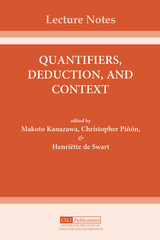 Quantifiers, Deduction, and Context
Edited by Makoto Kanazawa, Christopher Piñon, and Henriëtte de Swart
CSLI, 1996 This volume is an outgrowth of the second Workshop on Logic, Language and Computation held at Stanford in the spring of 1993. The workshop brought together researchers interested in natural language to discuss the current state of the art at the borderline of logic, linguistics and computer science. The papers in this collection fall into three central research areas of the nineties, namely quantifiers, deduction, and context. Each contribution reflects an ever-growing interest in a more dynamic approach to meaning, which focuses on inference patterns and the interpretation of sentences in the context of a larger discourse. The papers apply either current logical machinery - such as linear logic, generalised quantifier theory, dynamic logic - or formal analyses of the notion of context in discourse to classical linguistic issues, with original and thought-provoking results deserving of a wide audience.
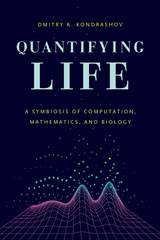 Quantifying Life: A Symbiosis of Computation, Mathematics, and Biology
Dmitry A. Kondrashov
University of Chicago Press, 2016 Since the time of Isaac Newton, physicists have used mathematics to describe the behavior of matter of all sizes, from subatomic particles to galaxies. In the past three decades, as advances in molecular biology have produced an avalanche of data, computational and mathematical techniques have also become necessary tools in the arsenal of biologists. But while quantitative approaches are now providing fundamental insights into biological systems, the college curriculum for biologists has not caught up, and most biology majors are never exposed to the computational and probabilistic mathematical approaches that dominate in biological research.
With Quantifying Life, Dmitry A. Kondrashov offers an accessible introduction to the breadth of mathematical modeling used in biology today. Assuming only a foundation in high school mathematics, Quantifying Life takes an innovative computational approach to developing mathematical skills and intuition. Through lessons illustrated with copious examples, mathematical and programming exercises, literature discussion questions, and computational projects of various degrees of difficulty, students build and analyze models based on current research papers and learn to implement them in the R programming language. This interplay of mathematical ideas, systematically developed programming skills, and a broad selection of biological research topics makes Quantifying Life an invaluable guide for seasoned life scientists and the next generation of biologists alike.
 Quantifying Mentalities: The Use of Numbers by Ancient Greek Historians
Catherine Rubincam
University of Michigan Press, 2021 As 21st-century citizens of developed countries, we are constantly bombarded by numbers in every aspect of our lives. Almost automatically, we learn to interpret how numbers are used in our language, what magnitude of numbers we expect to hear in particular contexts, how people in our community express degrees of confidence in the reliability of any particular number, etc. Context of this kind is lacking when we read a historical narrative composed in an ancient language, from a world vastly different from ours. In Quantifying Mentalities, Catherine Rubincam helps overcome this barrier to our accurate understanding of the numbers in the works of five major ancient Greek historians by providing a standard against which their credibility can be more accurately judged.
This systematic, quantified study is based on the compilation of statistics concerning a standard constellation of aspects of all the numbers in the historical works of the five earliest wholly or at least substantially surviving ancient Greek historians: Herodotus, Thucydides, Xenophon (Anabasis and Hellenica), Polybius, and Diodorus Siculus. Such a comprehensive study has not been attempted before. For scholars reading and writing about the history of ancient Greece the volume offers a tool for interpreting the numbers in these ancient texts with more sensitivity to the world in which they were written. Standard aspects of number use captured by the coding system are: the different types of number (cardinals, ordinals, compounds, and non-explicit but definite numbers); the subject category to which each number belongs (Time, Distance-Size, Military, Population, Money, and Miscellaneous); and the types of any qualifications attached to it (Approximating, Comparative, Alternative, and Emphatic). The statistics also facilitate comparisons of every aspect of number use between authors and texts, enabling the delineation of a numeric profile for each one. This allows us to read these texts with a greater sensitivity to how they might have sounded to the author and his original readers, thus providing a firmer foundation for reconstructing or interpreting ancient Greek history.
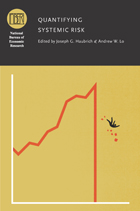 Quantifying Systemic Risk
Edited by Joseph G. Haubrich and Andrew W. Lo
University of Chicago Press, 2013 In the aftermath of the recent financial crisis, the federal government has pursued significant regulatory reforms, including proposals to measure and monitor systemic risk. However, there is much debate about how this might be accomplished quantitatively and objectively—or whether this is even possible. A key issue is determining the appropriate trade-offs between risk and reward from a policy and social welfare perspective given the potential negative impact of crises. One of the first books to address the challenges of measuring statistical risk from a system-wide persepective, Quantifying Systemic Risk looks at the means of measuring systemic risk and explores alternative approaches. Among the topics discussed are the challenges of tying regulations to specific quantitative measures, the effects of learning and adaptation on the evolution of the market, and the distinction between the shocks that start a crisis and the mechanisms that enable it to grow.
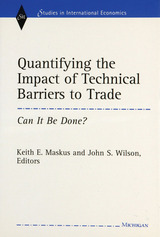 Quantifying the Impact of Technical Barriers to Trade: Can It Be Done?
Keith E. Maskus and John S. Wilson, Editors
University of Michigan Press, 2001 This book provides an up-to-date discussion of economic issues involved in analyzing regulations of product quality and performance in international trade. Among the issues addressed in this collection are restrictions on genetically modified foods and pesticide use and compatibility standards for computers. While such regulations may serve important goals, they may also interfere with international trade flow by raising the costs of compliance. This is of special concern to developing countries, which have found it difficult to meet the increasingly exacting regulations imposed by the United States and Europe. Keith E. Maskus and John S. Wilson gather prominent international trade specialists to ask whether the impacts of such regulations may be quantified systematically in order to inform the international policy debate. The essays included here cover all fronts of the debate over regulatory issues and trade conflicts. The discussion ranges from a review of how trade conflicts emerge and how they are managed by the international trading system to a technical analysis of the potential impact of European restraints on trade in genetically modified products to an examination of methods for estimating the costs of compliance with environmental regulations. Considerable attention is paid to whether the emergence and enforcement of stronger standards among developed economies could result in diminished trade opportunities for developing countries. At the same time, the possibility that standards could expand market access through resolving consumer information problems is analyzed. This book will appeal to international economists, international relations specialists, and individuals concerned about appropriate regulation of safety and health issues in the global economy. Keith E. Maskus is Professor of Economics, University of Colorado, Boulder. John S. Wilson is Lead Economist, Development Economics Research Group, The World Bank.
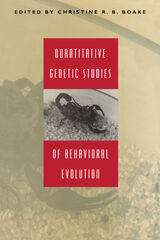 Quantitative Genetic Studies of Behavioral Evolution
Edited by Christine R. B. Boake
University of Chicago Press, 1994 Quantitative genetics—the statistical study of the inheritance of traits within a population—has become an important tool for studying the evolution of behavior in the last decade. Quantitative Genetic Studies of Behavioral Evolution examines the theory and methods of quantitative genetics and presents case studies that illustrate the many ways in which the methods can be applied.
Christine R. B. Boake brings together current theoretical and empirical studies to show how quantitative genetics can illuminate topics as diverse as sexual selection, migration, sociality, and aggressive behavior. Nearly half of the chapters focus on conceptual issues, ranging from quantitative genetic models to the complementary roles of quantitative genetic and optimality approaches in evolutionary studies. Other chapters illustrate how to use the techniques by providing surveys of research fields, such as the evolution of mating behavior, sexual selection, migration, and size-dependent behavioral variation. The balance of the volume offers case studies of territoriality in fruit flies, cannibalism in flour beetles, mate-attractive traits in crickets, locomotor behavior and physiology in the garter snake, and cold adaptation in the house mouse. Taken together, these studies document both the benefits and pitfalls of quantitative genetics.
This book shows the advanced student and scholar of behavioral evolution and genetics the many powerful uses of quantitative genetics in behavioral research.
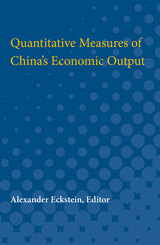 Quantitative Measures of China's Economic Output
Alexander Eckstein, Editor
University of Michigan Press, 1980 The papers in this volume were among those presented at a Conference on the Quantitative Measures of China's Economic Output, held in January, 1975, at the Brookings Institution in Washington, D.C. The conference was sponsored by the Subcommittee on Research on the Chinese Economy of the Joint Committee on Contemporary China of the Social Science Research Council and the American Council of Learned Societies. Alexander Eckstein, from the University of Michigan, had been asked by the subcommittee to organize a meeting to bring together academics and government professionals carrying out research on China's economy to discuss common problems encountered in their research. Given the limited quantity and poor quality of basic economic data for China since 1949, Eckstein decided to organize the conference on the theme of reconciling quantitative estimates of China's economic output. Participants included some twenty academics from the United States, the United Kingdom, and India and fifteen professionals from government or quasi-public research institutions. The success of the conference led to urgings by the subcommittee and many other scholars that Eckstein edit several of the papers for publication.The revisions by the individual authors of the four essays included in this volume and the supervision and coordination of their efforts by Eckstein were time-consuming tasks. The authors worked closely with him in these efforts, and his detailed critiques and suggestions were planned as a separate volume. His contribution to the final version of the essays in this volume is very significant, but Eckstein suffered a fatal heart attack in December, 1976, before the revised draft of the fourth essay was completed and before he had begun to write the introductory essay. He was widely recognized as the dean of American scholars of the economy of China, and his death was a tragic loss for all students of China.Following Eckstein's death, Robert F. Dernberger of the Universit
 Quantum 2.0: The Weird Physics Driving a New Revolution in Technology
Paul Davies
University of Chicago Press, 2026 Quantum computers, quantum cryptography, and even quantum AI—a century after uncovering an unexpected physical world, researchers are putting this puzzling science to work in dazzling new ways.
In this exhilarating and mind-bending book, renowned scientist and author Paul Davies offers readers a glimpse of how quantum physics has led to a quantum technology revolution. Quantum 2.0 reveals how today’s brightest minds are harnessing exotic states of matter that have no counterpart in everyday life. Specifically, all eyes are on entanglement, called “spooky” by Einstein, that links the activities of separated particles even across vast distances.
By manipulating these weird properties of atoms, electrons, and photons, scientists are driving the burgeoning field of “quantum information science,” featuring new tools such as quantum computers, quantum cryptography, and the quantum internet. In turn, their efforts have attracted billions of dollars in investments and triggered a frantic quantum arms race between nations. At the same time, theorists are taking a closer look at quantum systems themselves, which possess properties that defy intuition and shred everyday notions of reality. Davies explains how researchers, including himself, are wrestling with quantum theory to make sense of this realm, where ghostly quantum particles produce tiny forces in nanotechnology, cause black holes to evaporate, and may even contribute to the universe’s accelerating expansion. A trusted guide, Davies takes readers from the basic concepts to today’s cutting-edge, inviting us all to see the wonderland of quantum physics and glimpse its stunning implications.
 Quantum 2.0: The Weird Physics Driving a New Revolution in Technology
Paul Davies
University of Chicago Press, 2026 Quantum computers, quantum cryptography, and even quantum AI—a century after uncovering an unexpected physical world, researchers are putting this puzzling science to work in dazzling new ways.
In this exhilarating and mind-bending book, renowned scientist and author Paul Davies offers readers a glimpse of how quantum physics has led to a quantum technology revolution. Quantum 2.0 reveals how today’s brightest minds are harnessing exotic states of matter that have no counterpart in everyday life. Specifically, all eyes are on entanglement, called “spooky” by Einstein, that links the activities of separated particles even across vast distances.
By manipulating these weird properties of atoms, electrons, and photons, scientists are driving the burgeoning field of “quantum information science,” featuring new tools such as quantum computers, quantum cryptography, and the quantum internet. In turn, their efforts have attracted billions of dollars in investments and triggered a frantic quantum arms race between nations. At the same time, theorists are taking a closer look at quantum systems themselves, which possess properties that defy intuition and shred everyday notions of reality. Davies explains how researchers, including himself, are wrestling with quantum theory to make sense of this realm, where ghostly quantum particles produce tiny forces in nanotechnology, cause black holes to evaporate, and may even contribute to the universe’s accelerating expansion. A trusted guide, Davies takes readers from the basic concepts to today’s cutting-edge, inviting us all to see the wonderland of quantum physics and glimpse its stunning implications.
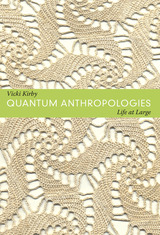 Quantum Anthropologies: Life at Large
Vicki Kirby
Duke University Press, 2011 In Quantum Anthropologies, the renowned feminist theorist Vicki Kirby contends that some of the most provocative aspects of deconstruction have yet to be explored. Deconstruction’s implications have been curtailed by the assumption that issues of textuality and representation are specific to the domain of culture. Revisiting Derrida’s claim that there is “no outside of text,” Kirby argues that theories of cultural construction developed since the linguistic turn have inadvertently reproduced the very binaries they intended to question, such as those between nature and culture, matter and ideation, and fact and value. Through new readings of Derrida, Husserl, Saussure, Butler, Irigaray, and Merleau-Ponty, Kirby exposes the limitations of theories that regard culture as a second-order system that cannot access—much less be—nature, body, and materiality. She suggests ways of reconceiving language and culture to enable a more materially implicated outcome, one that keeps alive the more counterintuitive and challenging aspects of poststructural criticism. By demonstrating how fields, including cybernetics, biology, forensics, mathematics, and physics, can be conceptualized in deconstructive terms, Kirby fundamentally rethinks deconstruction and its relevance to nature, embodiment, materialism, and science.
Quantum Anthropology: Man, Cultures, and Groups in a Quantum Perspective
Radek Trnka and Radmila Lorencová
Karolinum Press, 2017 Quantum Anthropology offers a fresh look at humans, cultures, and societies that builds on advances in the fields of quantum mechanics, quantum philosophy, and quantum consciousness. Radek Trnka and Radmila Lorencová have developed an inspiring theoretical framework that transcends the boundaries of individual disciplines, and in this book they draw on philosophy, psychology, sociology, and consciousness studies to redefine contemporary sociocultural anthropological theory. Quantum anthropology, they argue, is a promising new perspective for the study of humanity that takes into account the quantum nature of our reality. This meta-ontology offers novel pathways for exploring the basic categories of our species’ being.
Quantum Art & Uncertainty
Paul Thomas
Intellect Books, 2018 At the core of both art and science we find the twin forces of probability and uncertainty. However, these two worlds have been tenuously entangled for decades. On the one hand, artists continue to ask complex questions that align with a scientific fascination with new discoveries, and on the other hand, it is increasingly apparent that creativity and subjectivity inform science’s objective processes and knowledge systems.
In order to draw parallels between art, science, and culture, this publication will explore the ways that selected art works have contributed to a form of cultural pedagogy. It follows the integration of culture and science in artists’ expressions to create meaningful experiences that expose the probabilities and uncertainties equally present in the world of science.
 Quantum Criminals: Ramblers, Wild Gamblers, and Other Sole Survivors from the Songs of Steely Dan
By Alex Pappademas and Joan LeMay
University of Texas Press, 2023 “ONE OF THE SHARPEST, FUNNIEST, AND BEST BOOKS EVER ABOUT ANY ROCK ARTIST”—Rolling Stone “WEIRD AND WONDROUS”—New York Times “I ADORED IT”—Michael Chabon A literary and visual exploration of the songs of Steely Dan. Steely Dan’s songs are exercises in fictional world-building. No one else in the classic-rock canon has conjured a more vivid cast of rogues and heroes, creeps and schmucks, lovers and dreamers and cold-blooded operators—or imbued their characters with so much humanity.
Pulling from history, lived experience, pulp fiction, the lore of the counterculture, and their own darkly comic imaginations, Donald Fagen and Walter Becker summoned protagonists who seemed like fully formed people with complicated pasts, scars they don’t talk about, delusions and desires and memories they can’t shake. From Rikki to Dr. Wu, Hoops McCann to Kid Charlemagne, Franny from NYU to the Woolly Man without a Face, every name is a locked-room mystery, beguiling listeners and earning the band an exceptionally passionate and ever-growing cult fandom. Quantum Criminals presents the world of Steely Dan as it has never been seen, much less heard. Artist Joan LeMay has crafted lively, color-saturated images of her favorite characters from the Daniverse to accompany writer Alex Pappademas’s explorations of the famous and obscure songs that inspired each painting, in short essays full of cultural context, wild speculation, inspired dot-connecting, and the occasional conspiracy theory. All of it is refracted through the perspectives of the characters themselves, making for a musical companion unlike any other. Funny, discerning, and visually stunning, Quantum Criminals is a singular celebration of Steely Dan’s musical cosmos.
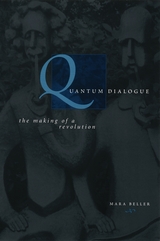 Quantum Dialogue: The Making of a Revolution
Mara Beller
University of Chicago Press, 1999 "Science is rooted in conversations," wrote Werner Heisenberg, one of the twentieth century's great physicists. In Quantum Dialogue, Mara Beller shows that science is rooted not just in conversation but in disagreement, doubt, and uncertainty. She argues that it is precisely this culture of dialogue and controversy within the scientific community that fuels creativity.
Beller draws her argument from her radical new reading of the history of the quantum revolution, especially the development of the Copenhagen interpretation. One of several competing approaches, this version succeeded largely due to the rhetorical skills of Niels Bohr and his colleagues. Using extensive archival research, Beller shows how Bohr and others marketed their views, misrepresenting and dismissing their opponents as "unreasonable" and championing their own not always coherent or well-supported position as "inevitable."
Quantum Dialogue, winner of the 1999 Morris D. Forkosch Prize of the Journal of the History of Ideas, will fascinate everyone interested in how stories of "scientific revolutions" are constructed and "scientific consensus" achieved.
"[A]n intellectually stimulating piece of work, energised by a distinct point of view."—Dipankar Home, Times Higher Education Supplement
"[R]emarkable and original. . . . [Beller's] arguments are thoroughly supported and her conclusions are meticulously argued. . . . This is an important book that all who are interested in the emergence of quantum mechanics will want to read."—William Evenson, History of Physics Newsletter
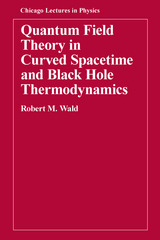 Quantum Field Theory in Curved Spacetime and Black Hole Thermodynamics
Robert M. Wald
University of Chicago Press, 1994 A clear and concise introduction to quantum field theory in curved spacetime
In this book, Robert Wald provides a coherent, pedagogical introduction to the formulation of quantum field theory in curved spacetime. He begins with a treatment of the ordinary one-dimensional quantum harmonic oscillator, progresses through the construction of quantum field theory in flat spacetime to possible constructions of quantum field theory in curved spacetime, and, ultimately, to an algebraic formulation of the theory. In his presentation, Wald disentangles essential features of the theory from inessential ones (such as a particle interpretation) and clarifies relationships between various approaches to the formulation of the theory. He also provides a comprehensive, up-to-date account of the Unruh effect, the Hawking effect, and some of its ramifications. In particular, the subject of black hole thermodynamics, which remains an active area of research, is treated in depth.
This book will be accessible to students and researchers who have had introductory courses in general relativity and quantum field theory, and will be of interest to scientists in general relativity and related fields.
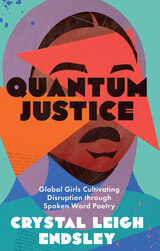 Quantum Justice: Global Girls Cultivating Disruption through Spoken Word Poetry
Crystal Leigh Endsley
University of Texas Press, 2023 How girls of color from eight global communities strategize on questions of identity, social issues, and political policy through spoken word poetry.
Around the world, girls know how to perform. Grounded in her experience of “putting a mic in the margins” by facilitating workshops for girls in Ethiopia, South Africa, Tanzania, and the United States, scholar/advocate/artist Crystal Leigh Endsley highlights how girls use spoken word poetry to narrate their experiences, dreams, and strategies for surviving and thriving. By centering the process of creating and performing spoken word poetry, this book examines how girls forecast what is possible for their collective lives. In this book, Endsley combines poetry, discourse analysis, photovoice, and more to forge the feminist theory of “quantum justice,” which forefronts girls’ relationships with their global counterparts. Using quantum justice theory, Endsley examines how these collaborative efforts produce powerful networks and ultimately map trajectories of social change at the micro level. By inviting transnational dialogue through spoken word poetry, Quantum Justice emphasizes how the imaginative energy in hip-hop culture can mobilize girls to connect and motivate each other through spoken word performance and thereby disrupt the status quo.
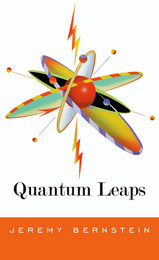 Quantum Leaps
Jeremy Bernstein
Harvard University Press, 2009 In 1953, reflecting on early ventures in quantum theory, J. Robert Oppenheimer spoke of terror and exaltation, of history happening in a realm so remote from common experience that it was “unlikely to be known to any poet or historian.” Yet now, anyone can Google “quantum theory” and find more than 34 million entries—from poets and historians, certainly, as well as film critics and Buddhist monks. How—and how pervasively—quantum mechanics has entered the general culture is the subject of this book, an engaging, eclectic, and thought-provoking look at the curious, boundlessly fertile intersection of scientific thought and everyday life.
Including recollections of encounters with the theory and the people responsible for it, Jeremy Bernstein’s account ranges from the cross-pollination of quantum mechanics with Marxist ideology and Christian and Buddhist mysticism to its influence on theater, film, and fiction. Along the way, Bernstein focuses on those—such as Niels Bohr, the Dalai Lama, W. H. Auden, and Tom Stoppard—who have made quantum physics; who have argued over it, pondered it, or taken literary inspiration from it, and who have misunderstood, misconstrued, or misapplied it. One person in particular supplies a narrative thread: John Bell, a notable yet underappreciated physicist who did groundbreaking research in quantum physics. In Bell’s story, Bernstein provides a uniquely readable account of what physicists call the “measurement problem.”
Quantum Leaps is a lively, erudite book on a subject that Bernstein has lived with for most of its history. His experience and deep understanding are apparent on every page.
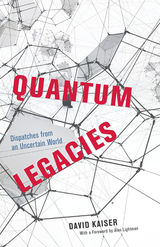 Quantum Legacies: Dispatches from an Uncertain World
David Kaiser
University of Chicago Press, 2024 A series of engaging essays that explore iconic moments of discovery and debate in physicists’ ongoing quest to understand the quantum world.
The ideas at the root of quantum theory remain stubbornly, famously bizarre: a solid world reduced to puffs of probability; particles that tunnel through walls; cats suspended in zombielike states, neither alive nor dead; and twinned particles that share entangled fates. For more than a century, physicists have grappled with these conceptual uncertainties while enmeshed in the larger uncertainties of the social and political worlds around them, a time pocked by the rise of fascism, cataclysmic world wars, and a new nuclear age.
In Quantum Legacies, David Kaiser introduces readers to iconic episodes in physicists’ still-unfolding quest to understand space, time, and matter at their most fundamental. In a series of vibrant essays, Kaiser takes us inside moments of discovery and debate among the great minds of the era—Albert Einstein, Erwin Schrödinger, Stephen Hawking, and many more who have indelibly shaped our understanding of nature—as they have tried to make sense of a messy world.
Ranging across space and time, the episodes span the heady 1920s, the dark days of the 1930s, the turbulence of the Cold War, and the peculiar political realities that followed. In those eras as in our own, researchers’ ambition has often been to transcend the vagaries of here and now, to contribute lasting insights into how the world works that might reach beyond a given researcher’s limited view. In Quantum Legacies, Kaiser unveils the difficult and unsteady work required to forge some shared understanding between individuals and across generations, and in doing so, he illuminates the deep ties between scientific exploration and the human condition.
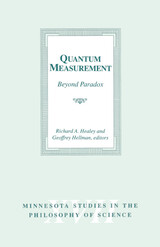 Quantum Measurement: Beyond Paradox
Richard A. Healey
University of Minnesota Press, 1998 A new approach to the quantum measurement dilemma. With relativity theory, quantum mechanics stands as the conceptual foundation of modern physics. It forms the basis by which we understand the minute workings of the subatomic world. But at its core lies a paradox: standard conceptions of quantum mechanics imply that the results of many of the actual measurements supporting and verifying quantum mechanical theory can have no definite outcomes. Some quantity such as position or momentum is always indefinite on a quantum system; and if an indefinite quantity is measured, the macroscopic state of the measuring apparatus that is supposed to record the outcome instead becomes indefinite itself. In Quantum Measurement, editors Richard A. Healey and Geoffrey Hellman marshal the resources of leading physicists and philosophers of science, skillfully joining their insights and ingenuity to yield some of the most innovative and altogether promising thought to date on this enigmatic issue. Throughout this authoritative volume, these authors explore the subtle and varied ways in which quantum mechanics informs the conditions, indeed the very process, of quantum measurement. The latest work on decoherence phenomena is combined with sophisticated modal interpretations, suggesting that definite values might be systematically attributed to a limited class of quantum observables while gauging the correspondent impact of environmental interactions on quantum interference terms. What emerges from this careful synthesis is a theoretically powerful and energetic new approach to the measurement dilemma, one that furthers our conceptual understanding of the fundamental interconnections between micro- and macroscopic systems, and that strives, ultimately, to describe and define within a unified quantum mechanical framework the breadth of our physical reality.Contributors: Guido Bacciagaluppi, Balliol College, Oxford; Jeffrey Bub, U of Maryland; Rob Clifton, U of Pittsburgh; Michael Dickson, Indiana U; Dennis Dieks, Utrecht U, Netherlands; Andrew Elby; Meir Hemmo; Anthony J. Leggett, U of Illinois; Bradley Monton; Abner Shimony, Boston U; William G. Unruh, U of British Columbia; Pieter E. Vermaas.ISBN 0-8166-3065-8 Cloth/jacket $39.95x 232 pages 5 figures 5 7/8 x 9 JuneMinnesota Studies in the Philosophy of Science Series, Volume 17Translation inquiries: University of Minnesota Press
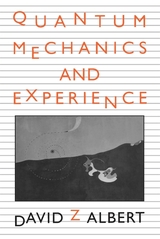 Quantum Mechanics and Experience
David Z Albert
Harvard University Press, 1992 The more science tells us about the world, the stranger it looks. Ever since physics first penetrated the atom, early in this century, what it found there has stood as a radical and unanswered challenge to many of our most cherished conceptions of nature. It has literally been called into question since then whether or not there are always objective matters of fact about the whereabouts of subatomic particles, or about the locations of tables and chairs, or even about the very contents of our thoughts. A new kind of uncertainty has become a principle of science.
This book is an original and provocative investigation of that challenge, as well as a novel attempt at writing about science in a style that is simultaneously elementary and deep. It is a lucid and self-contained introduction to the foundations of quantum mechanics, accessible to anyone with a high school mathematics education, and at the same time a rigorous discussion of the most important recent advances in our understanding of that subject, some of which are due to the author himself.
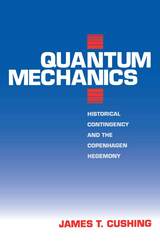 Quantum Mechanics: Historical Contingency and the Copenhagen Hegemony
James T. Cushing
University of Chicago Press, 1994 Why does one theory "succeed" while another, possibly clearer interpretation, fails? By exploring two observationally equivalent yet conceptually incompatible views of quantum mechanics, James T. Cushing shows how historical contingency can be crucial to determining a theory's construction and its position among competing views.
Since the late 1920s, the theory formulated by Niels Bohr and his colleagues at Copenhagen has been the dominant interpretation of quantum mechanics. Yet an alternative interpretation, rooted in the work of Louis de Broglie in the early 1920s and reformulated and extended by David Bohm in the 1950s, equally well explains the observational data. Through a detailed historical and sociological study of the physicists who developed different theories of quantum mechanics, the debates within and between opposing camps, and the receptions given to each theory, Cushing shows that despite the preeminence of the Copenhagen view, the Bohm interpretation cannot be ignored. Cushing contends that the Copenhagen interpretation became widely accepted not because it is a better explanation of subatomic phenomena than is Bohm's, but because it happened to appear first.
Focusing on the philosophical, social, and cultural forces that shaped one of the most important developments in modern physics, this provocative book examines the role that timing can play in the establishment of theory and explanation.
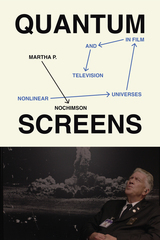 Quantum Screens: Nonlinear Universes in Film and Television
Martha P. Nochimson
University of Texas Press, 2026 An exploration of how nonlinear storytelling opens a post-Newtonian reality and changes both the hero’s journey and how we understand history in film and television. Begin at the beginning and keep going until the end. That’s the cardinal rule of conventional storytelling. But ever since the modernists of the early twentieth century, popular narratives have occasionally eschewed this linear approach to temporality. It’s as though our stories, formerly unfolding in the stable, predictable universe of Newtonian physics, can now take place in multidimensional time where anything and anyone can be as incalculable as Schrödinger’s cat. Quantum Screens is a journey through the past and present of nonlinear time in film and television. Moving beyond the early experiments of Luis Buñuel and the first nonlinear commercial films, such as 2001: A Space Odyssey, Martha Nochimson shows how risk-taking auteurs David Lynch, Damon Lindelof, and Terrence Malik have opened new horizons and a new concept of beauty in storytelling through their revelatory creations. Quantum Screens takes us deep into the audience’s experience of nonlinearity, exploring the emotional dislocations such storytelling creates, using television programs such as Twin Peaks, Westworld, and Watchmen, and films including The Tree of Life, BlacKkKlansman, and Arrival. Indeed, viewers are at the heart of a changing aesthetics of nonlinearity, Nochimson argues. Amid innovations like on-demand viewing, unlimited replay, and binge-watching, the experience of real time is more malleable than ever, and creators are responding by structuring their stories in compelling new ways.
The Quantum World: Quantum Physics for Everyone
Kenneth W. Ford
Harvard University Press, 2005 As Kenneth W. Ford shows us in The Quantum World, the laws governing the very small and the very swift defy common sense and stretch our minds to the limit. Drawing on a deep familiarity with the discoveries of the twentieth century, Ford gives an appealing account of quantum physics that will help the serious reader make sense of a science that, for all its successes, remains mysterious. In order to make the book even more suitable for classroom use, the author, assisted by Diane Goldstein, has included a new section of Quantum Questions at the back of the book. A separate answer manual to these 300+ questions is available; visit The Quantum World website for ordering information.
There is also a cloth edition of this book, which does not include the "Quantum Questions" included in this paperback edition.
Qu'appelons-nous penser?
Jean-Luc Nancy and Daniel Tyradellis
Diaphanes, 2013 Jean-Luc Nancy et Daniel Tyradellis, philosophes, questionnant tous deux la nature même de la pensée, se sont rencontrés un soir de novembre 2012 à Berlin. En a résulté un dialogue sur les représentations que nous nous faisons de la pensée, sur ce qui nous y amène, nous y force ou nous y incite ; mais également sur les bonnes et les mauvaises raisons de penser, sur la philosophie et la misosophie.
Cet échange rare et singulier traite de la précarité de toute pensée, qu’elle s’établisse dans la langue, dans l’image, dans le corps ou dans l’espace ; du nous et de la pensée partagée qui ouvre les possibilités du sens. Il dessine une pensée qui s’épuise, mais qui aime aussi, et nous redonne foi en l’existence.
Quarantine
John Smolens
Michigan State University Press, 2019 In 1796 a trading ship arrives in the vibrant harbor town of Newburyport, Massachusetts, her crew decimated by a virulent fever. Despite the ship being placed under quarantine, this mysterious disease sweeps through the waterfront, causing entire families to die of plague-like symptoms with alarming haste. The pestilence tests the civility and courage of the seaport residents. Some risk their lives to nurse the sick, while others steal crucial medicine and profit on the black market. Some preach that the afflicted deserve the Lord’s punishment and those who treat the sick are in league with the devil. Dr. Giles Wiggins, a surgeon and veteran of the American Revolution, works tirelessly to save lives, often disagreeing with his medical colleagues on both the cause of the deadly ailment and its remedy. As the epidemic grows, the seaport’s future is threatened by obsession, greed, and fear.
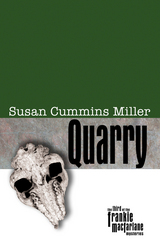 Quarry
Susan Cummins Miller
Texas Tech University Press, 2006 As geologist Frankie MacFarlane prepares for her doctoral dissertation defense, two members of her committee are brutally attacked, one of them fatally. Meanwhile, the case on the supposedly deceased Geoff Travers is reopened, forcing Frankie to deal with the possibility that her former fiancé might still be alive. And, while working on a vertebrate fossil quarry, fellow student Dora Simpson is abducted. For her, time is running out.In the Mojave Desert, amid the arroyos and volcanic mesas of the Cady Mountains, Frankie finds the final pieces to these puzzles—and becomes the quarry.“Fast-paced, yet lyrical and evocative, Quarry yields a cross-section of creatures as fascinating as the fossil beds its protagonist studies. The real mystery for Frankie MacFarlane fans is how to read this book slowly enough to savor Susan Cummins Miller’s skillful prose and characterization.” —Wynne Brown, author of More Than Petticoats: Remarkable Arizona WomenPraise for previous Frankie MacFarlane Mysteries:“A rollicking pentimento of fieldwork gone afoul!”—Geotimes. “Assured and erudite.” —Publishers Weekly. “A gripping thriller, exciting and eager to lure the reader into a labyrinth of human deceit. . . . Attention Hollywood—this is the stuff from which blockbuster movies can be made!”—Midwest Book Review
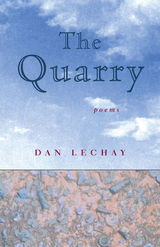 The Quarry: Poems
Dan Lechay
Ohio University Press, 2004 Once or twice in a generation a poet comes along who captures the essential spirit of the American Midwest and gives name to the peculiar nature that persists there. Like James Wright, Robert Bly, Ted Kooser, and Jared Carter before him, Dan Lechay reshapes our imagination to include his distinct and profound vision of this undersung region. The poetry of Dan Lechay, collected in The Quarry, constructs a myth of the Midwest that is at once embodied in the permanence of the landscape, the fleeting nature of the seasons, and the eternal flow of the river. Lechay writes of memory and the mutability of memory, of the change brought on a person by the years lived and lost, and of the stoic attempts made by those around him to elicit an order and rationale to their lives. The Quarry is the first full-length collection from this seasoned poet. Final judge Alan Shapiro in writing about The Quarry said: “If Dan Lechay’s poems often begin with the ordinary details and circumstances of life in a small Midwestern town or city, they always end by reminding us that no moment of life is ever ordinary, that ‘Nothing is more mysterious than the way things are.’ The Quarry is a marvelous, disquieting, extraordinarily beautiful book that meditates on fundamental questions of time and change in and through a clear-eyed yet loving evocation of everyday existence. Under Lechay’s soulful gaze, the backyards, neighborhoods, animals, and landscapes he describes dramatize the often wrenching connection between beauty and loss, evanescence and memory. The Quarry is a thoroughly mature and accomplished book.”
 A Quarter Century of Common Knowledge: Eleven Conversations
Jeffrey M. Perl, special issue editor
Duke University Press To commemorate the journal’s quarter-century, this double issue consists of foundational pieces arranged in conversation with one another. Common Knowledge has opened lines of communication among schools of thought in the academy, as well as between the academy and the community of thoughtful people outside its walls, and the pages of the journal challenge the ways we think about scholarship and its relevance to humanity. Contributors to the issue include former presidents, prime ministers, and archbishops, along with winners of the Nobel Prize, Man Booker Prize, Pulitzer Prize, National Book Award, Mellon Foundation Distinguished Achievement Award, MacArthur Fellowship, International Balzan Prize, and Holberg International Prize.
Contributors. M. H. Abrams, Edward Albee, Barry Allen, Wayne Andersen, Kwame Anthony Appiah, Sir Isaiah Berlin, Marianna Birnbaum, Sir John Boardman, G. W. Bowersock, Aldo Buzzi, Caroline Walker Bynum, Anne Carson, William M. Chace, J. M. Coetzee, Cornelius Castoriadis, Stanley Cavell, Stuart Clark, Inga Clendinnen, Francis X. Clooney, Christopher Coker, Maria Conterno, Michael Cook, Lorraine Daston, Lydia Davis, Natalie Zemon Davis, Thibault De Meyer, Gunter Eich, Sir John H. Elliott, Caryl Emerson, Mikhail Epstein, Péter Esterházy, Roger Cardinal Etchegaray, Fang Lizhi, Paul Feyerabend, Michael Fried, Joseph Frank, Manfred Frank, Luis Garcia, Clifford Geertz, Carlo Ginzburg, Philip Gossett, Stephen Greenblatt, Thom Gunn, Jürgen Habermas, Ian Hacking, Václav Havel, Sir Edward Heath, Albert O. Hirschman, David Hollinger, Darrel Alejandro Holnes, Miroslav Holub, Maya Jasanoff, Albert R. Jonsen, Stanley N. Katz, Hugh Kenner, Sir Anthony Kenny, Sir Frank Kermode, Jee Leong Koh, Joseph Leo Koerner, Yusef Komunyakaa, György Konrád, Bruce Krajewski, László Krasznahorkai, Anton O. Kris, Julia Kristeva, Bruno Latour, Ewa Lipska, Greil Marcus, Steven Marcus, Samuel Menashe, Adam Michnik, Jack Miles, Alexander Nehamas, Reviel Netz, Sari Nusseibeh, Jeffrey M. Perl, Marjorie Perloff, J. G. A. Pocock, W. V. Quine, Belle Randall, Nadja Reissland, Colin Richmond, Richard Rorty, Ingrid Rowland, Hanna Segal, Amartya Sen, Quentin Skinner, Barbara Herrnstein Smith, A. L. Snijders, Timothy Snyder, Susan Sontag, Isabelle Stengers, Wis?awa Szymborska, Miguel Tamen, G. Thomas Tanselle, Sir Keith Thomas, Stephen Toulmin, Anna Lowenhaupt Tsing, Michiko Urita, Bas van Fraassen, Marina Vanzolini, Gianni Vattimo, Helen Vendler, Charlie Samua Veric, Eduardo Viveiros de Castro, Sir Bernard Williams, Lord (Rowan) Williams, H. R. Woudhuysen, Grzegorz Wróblewski, Santiago Zabala
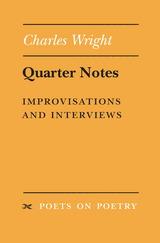 Quarter Notes: Improvisations and Interviews
Charles Wright
University of Michigan Press, 1995 Quarter Notes harvests recent reviews, essays, memoirs, and interviews by acclaimed poet Charles Wright. Wright uses creative variations on the form of the linear essay including interviews with himself as interviewee, correspondence (with Charles Simic), and experimentation with what he calls Improvisations "non- linear associational storylines". The book's short, staccato-like bursts add up to much more than the sum of their parts.
This satisfying collection includes reminiscences and meditations on the details of memory and what it means to visit the past; the vices of titleism and the hydrosyllabic foot in poetry; a comparison of poems and journeys; appreciation of poets Donald Justice and John Crow Ransom; an attempt to define "image"; discussions of the current state of poetry; and various highlights from the Charles Wright Literary Festival.
Charles Wright's books of poetry include The World of the Ten Thousand Things and Country Music: Selected Early Poems. He received the 1993 Ruth Lilly Poetry Prize and the 1992 Award of Merit Medal from the American Academy of Arts and Letters. He is Souder Family Professor of English, University of Virginia.
The Quarterly Review of Biology, volume 100 number 1 (March 2025)
The University of Chicago Press
University of Chicago Press Journals, 2025 This is volume 100 issue 1 of The Quarterly Review of Biology. The Quarterly Review of Biology (QRB) has presented insightful historical, philosophical, and technical treatments of important biological topics since 1926. As the premier review journal in biology, the QRB publishes outstanding review articles of generous length that are guided by an expansive, inclusive, and often humanistic understanding of biology. Beyond the core biological sciences, the QRB is also an important review journal for scholars in related areas, including policy studies and the history and philosophy of science. A comprehensive section of reviews on new biological books provides educators and researchers with information on the latest publications in the life sciences.
The Quarterly Review of Biology, volume 100 number 2 (June 2025)
The University of Chicago Press
University of Chicago Press Journals, 2025 This is volume 100 issue 2 of The Quarterly Review of Biology. The Quarterly Review of Biology (QRB) has presented insightful historical, philosophical, and technical treatments of important biological topics since 1926. As the premier review journal in biology, the QRB publishes outstanding review articles of generous length that are guided by an expansive, inclusive, and often humanistic understanding of biology. Beyond the core biological sciences, the QRB is also an important review journal for scholars in related areas, including policy studies and the history and philosophy of science. A comprehensive section of reviews on new biological books provides educators and researchers with information on the latest publications in the life sciences.
The Quarterly Review of Biology, volume 100 number 3 (September 2025)
The University of Chicago Press
University of Chicago Press Journals, 2025 This is volume 100 issue 3 of The Quarterly Review of Biology. The Quarterly Review of Biology (QRB) has presented insightful historical, philosophical, and technical treatments of important biological topics since 1926. As the premier review journal in biology, the QRB publishes outstanding review articles of generous length that are guided by an expansive, inclusive, and often humanistic understanding of biology. Beyond the core biological sciences, the QRB is also an important review journal for scholars in related areas, including policy studies and the history and philosophy of science. A comprehensive section of reviews on new biological books provides educators and researchers with information on the latest publications in the life sciences.
The Quarterly Review of Biology, volume 96 number 3 (September 2021)
The University of Chicago Press
University of Chicago Press Journals, 2021 This is volume 96 issue 3 of The Quarterly Review of Biology. The Quarterly Review of Biology (QRB) has presented insightful historical, philosophical, and technical treatments of important biological topics since 1926. As the premier review journal in biology, the QRB publishes outstanding review articles of generous length that are guided by an expansive, inclusive, and often humanistic understanding of biology. Beyond the core biological sciences, the QRB is also an important review journal for scholars in related areas, including policy studies and the history and philosophy of science. A comprehensive section of reviews on new biological books provides educators and researchers with information on the latest publications in the life sciences.
The Quarterly Review of Biology, volume 96 number 4 (December 2021)
The University of Chicago Press
University of Chicago Press Journals, 2021 This is volume 96 issue 4 of The Quarterly Review of Biology. The Quarterly Review of Biology (QRB) has presented insightful historical, philosophical, and technical treatments of important biological topics since 1926. As the premier review journal in biology, the QRB publishes outstanding review articles of generous length that are guided by an expansive, inclusive, and often humanistic understanding of biology. Beyond the core biological sciences, the QRB is also an important review journal for scholars in related areas, including policy studies and the history and philosophy of science. A comprehensive section of reviews on new biological books provides educators and researchers with information on the latest publications in the life sciences.
The Quarterly Review of Biology, volume 97 number 1 (March 2022)
The University of Chicago Press
University of Chicago Press Journals, 2022 This is volume 97 issue 1 of The Quarterly Review of Biology. The Quarterly Review of Biology (QRB) has presented insightful historical, philosophical, and technical treatments of important biological topics since 1926. As the premier review journal in biology, the QRB publishes outstanding review articles of generous length that are guided by an expansive, inclusive, and often humanistic understanding of biology. Beyond the core biological sciences, the QRB is also an important review journal for scholars in related areas, including policy studies and the history and philosophy of science. A comprehensive section of reviews on new biological books provides educators and researchers with information on the latest publications in the life sciences.
The Quarterly Review of Biology, volume 97 number 2 (June 2022)
The University of Chicago Press
University of Chicago Press Journals, 2022 This is volume 97 issue 2 of The Quarterly Review of Biology. The Quarterly Review of Biology (QRB) has presented insightful historical, philosophical, and technical treatments of important biological topics since 1926. As the premier review journal in biology, the QRB publishes outstanding review articles of generous length that are guided by an expansive, inclusive, and often humanistic understanding of biology. Beyond the core biological sciences, the QRB is also an important review journal for scholars in related areas, including policy studies and the history and philosophy of science. A comprehensive section of reviews on new biological books provides educators and researchers with information on the latest publications in the life sciences.
The Quarterly Review of Biology, volume 97 number 3 (September 2022)
The University of Chicago Press
University of Chicago Press Journals, 2022 This is volume 97 issue 3 of The Quarterly Review of Biology. The Quarterly Review of Biology (QRB) has presented insightful historical, philosophical, and technical treatments of important biological topics since 1926. As the premier review journal in biology, the QRB publishes outstanding review articles of generous length that are guided by an expansive, inclusive, and often humanistic understanding of biology. Beyond the core biological sciences, the QRB is also an important review journal for scholars in related areas, including policy studies and the history and philosophy of science. A comprehensive section of reviews on new biological books provides educators and researchers with information on the latest publications in the life sciences.
The Quarterly Review of Biology, volume 97 number 4 (December 2022)
The University of Chicago Press
University of Chicago Press Journals, 2022 This is volume 97 issue 4 of The Quarterly Review of Biology. The Quarterly Review of Biology (QRB) has presented insightful historical, philosophical, and technical treatments of important biological topics since 1926. As the premier review journal in biology, the QRB publishes outstanding review articles of generous length that are guided by an expansive, inclusive, and often humanistic understanding of biology. Beyond the core biological sciences, the QRB is also an important review journal for scholars in related areas, including policy studies and the history and philosophy of science. A comprehensive section of reviews on new biological books provides educators and researchers with information on the latest publications in the life sciences.
The Quarterly Review of Biology, volume 98 number 1 (March 2023)
The University of Chicago Press
University of Chicago Press Journals, 2023 This is volume 98 issue 1 of The Quarterly Review of Biology. The Quarterly Review of Biology (QRB) has presented insightful historical, philosophical, and technical treatments of important biological topics since 1926. As the premier review journal in biology, the QRB publishes outstanding review articles of generous length that are guided by an expansive, inclusive, and often humanistic understanding of biology. Beyond the core biological sciences, the QRB is also an important review journal for scholars in related areas, including policy studies and the history and philosophy of science. A comprehensive section of reviews on new biological books provides educators and researchers with information on the latest publications in the life sciences.
The Quarterly Review of Biology, volume 98 number 2 (June 2023)
The University of Chicago Press
University of Chicago Press Journals, 2023 This is volume 98 issue 2 of The Quarterly Review of Biology. The Quarterly Review of Biology (QRB) has presented insightful historical, philosophical, and technical treatments of important biological topics since 1926. As the premier review journal in biology, the QRB publishes outstanding review articles of generous length that are guided by an expansive, inclusive, and often humanistic understanding of biology. Beyond the core biological sciences, the QRB is also an important review journal for scholars in related areas, including policy studies and the history and philosophy of science. A comprehensive section of reviews on new biological books provides educators and researchers with information on the latest publications in the life sciences.
The Quarterly Review of Biology, volume 98 number 3 (September 2023)
The University of Chicago Press
University of Chicago Press Journals, 2023 This is volume 98 issue 3 of The Quarterly Review of Biology. The Quarterly Review of Biology (QRB) has presented insightful historical, philosophical, and technical treatments of important biological topics since 1926. As the premier review journal in biology, the QRB publishes outstanding review articles of generous length that are guided by an expansive, inclusive, and often humanistic understanding of biology. Beyond the core biological sciences, the QRB is also an important review journal for scholars in related areas, including policy studies and the history and philosophy of science. A comprehensive section of reviews on new biological books provides educators and researchers with information on the latest publications in the life sciences.
The Quarterly Review of Biology, volume 98 number 4 (December 2023)
The University of Chicago Press
University of Chicago Press Journals, 2023 This is volume 98 issue 4 of The Quarterly Review of Biology. The Quarterly Review of Biology (QRB) has presented insightful historical, philosophical, and technical treatments of important biological topics since 1926. As the premier review journal in biology, the QRB publishes outstanding review articles of generous length that are guided by an expansive, inclusive, and often humanistic understanding of biology. Beyond the core biological sciences, the QRB is also an important review journal for scholars in related areas, including policy studies and the history and philosophy of science. A comprehensive section of reviews on new biological books provides educators and researchers with information on the latest publications in the life sciences.
The Quarterly Review of Biology, volume 99 number 1 (March 2024)
The University of Chicago Press
University of Chicago Press Journals, 2024 This is volume 99 issue 1 of The Quarterly Review of Biology. The Quarterly Review of Biology (QRB) has presented insightful historical, philosophical, and technical treatments of important biological topics since 1926. As the premier review journal in biology, the QRB publishes outstanding review articles of generous length that are guided by an expansive, inclusive, and often humanistic understanding of biology. Beyond the core biological sciences, the QRB is also an important review journal for scholars in related areas, including policy studies and the history and philosophy of science. A comprehensive section of reviews on new biological books provides educators and researchers with information on the latest publications in the life sciences.
The Quarterly Review of Biology, volume 99 number 2 (June 2024)
The University of Chicago Press
University of Chicago Press Journals, 2024 This is volume 99 issue 2 of The Quarterly Review of Biology. The Quarterly Review of Biology (QRB) has presented insightful historical, philosophical, and technical treatments of important biological topics since 1926. As the premier review journal in biology, the QRB publishes outstanding review articles of generous length that are guided by an expansive, inclusive, and often humanistic understanding of biology. Beyond the core biological sciences, the QRB is also an important review journal for scholars in related areas, including policy studies and the history and philosophy of science. A comprehensive section of reviews on new biological books provides educators and researchers with information on the latest publications in the life sciences.
The Quarterly Review of Biology, volume 99 number 3 (September 2024)
The University of Chicago Press
University of Chicago Press Journals, 2024 This is volume 99 issue 3 of The Quarterly Review of Biology. The Quarterly Review of Biology (QRB) has presented insightful historical, philosophical, and technical treatments of important biological topics since 1926. As the premier review journal in biology, the QRB publishes outstanding review articles of generous length that are guided by an expansive, inclusive, and often humanistic understanding of biology. Beyond the core biological sciences, the QRB is also an important review journal for scholars in related areas, including policy studies and the history and philosophy of science. A comprehensive section of reviews on new biological books provides educators and researchers with information on the latest publications in the life sciences.
The Quarterly Review of Biology, volume 99 number 4 (December 2024)
The University of Chicago Press
University of Chicago Press Journals, 2024 This is volume 99 issue 4 of The Quarterly Review of Biology. The Quarterly Review of Biology (QRB) has presented insightful historical, philosophical, and technical treatments of important biological topics since 1926. As the premier review journal in biology, the QRB publishes outstanding review articles of generous length that are guided by an expansive, inclusive, and often humanistic understanding of biology. Beyond the core biological sciences, the QRB is also an important review journal for scholars in related areas, including policy studies and the history and philosophy of science. A comprehensive section of reviews on new biological books provides educators and researchers with information on the latest publications in the life sciences.
Quasi Rational Economics
Richard H. Thaler
Russell Sage Foundation, 1991 Standard economics theory is built on the assumption that human beings act rationally in their own self interest. But if rationality is such a reliable factor, why do economic models so often fail to predict market behavior accurately? According to Richard Thaler, the shortcomings of the standard approach arise from its failure to take into account systematic mental biases that color all human judgments and decisions.
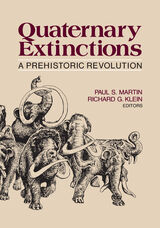 Quaternary Extinctions: A Prehistoric Revolution
Edited by Paul S. Martin and Richard G. Klein
University of Arizona Press, 1984 "What caused the extinction of so many animals at or near the end of the Pleistocene? Was it overkill by human hunters, the result of a major climatic change or was it just a part of some massive evolutionary turnover? Questions such as these have plagued scientists for over one hundred years and are still being heatedly debated today. Quaternary Extinctions presents the latest and most comprehensive examination of these questions." —Geological Magazine
"May be regarded as a kind of standard encyclopedia for Pleistocene vertebrate paleontology for years to come." —American Scientist
"Should be read by paleobiologists, biologists, wildlife managers, ecologists, archeologists, and anyone concerned about the ongoing extinction of plants and animals." —Science
"Uncommonly readable and varied for watchers of paleontology and the rise of humankind." —Scientific American
"Represents a quantum leap in our knowledge of Pleistocene and Holocene palaeobiology. . . . Many volumes on our bookshelves are destined to gather dust rather than attention. But not this one." —Nature
"Two strong impressions prevail when first looking into this epic compendium. One is the judicious balance of views that range over the whole continuum between monocausal, cultural, or environmental explanations. The second is that both the data base and theoretical sophistication of the protagonists in the debate have improved by a quantum leap since 1967." —American Anthropologist
 The Quay Brothers: Into a Metaphysical Playroom
Suzanne Buchan
University of Minnesota Press, 2010 This work is the first thorough analysis of the creative oeuvre of the Quay Brothers. Known for their animation shorts that rely on puppetry, miniatures, and stop-motion techniques, their fiercely idiosyncratic films are fertile fields for Suzanne Buchan's engaging descriptions and provocative insights into the Quays' art-and into the art of independent puppet animation.
Buchan's aesthetic investigation stems from extensive access to the Quay Brothers' artistic practices and work, which spans animation and live-action film, stage design and illustration. She also draws on a long acquaintance with them and on interviews with collaborators essential to their productions, as well as archival sources. Discussions of their films' literary origins, space, puppets, montage, and the often-overlooked world of sound and music in animation shed new light on the expressive world that the Quay Brothers generate out of their materials to create the poetic alchemy of their films.
At once a biography of the Quays' artistic trajectory and a detailed examination of one of their best-known films, Street of Crocodiles, this book goes further and provides interdisciplinary methodologies and tools for the analysis of animation.
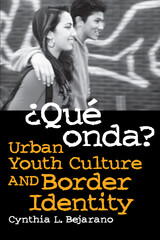 ¿Qué Onda?: Urban Youth Culture and Border Identity
Cynthia L. Bejarano
University of Arizona Press, 2005 Angel was born in Arizona and is part of the in-crowd. She likes clubbing, dancing, and going to car shows. Betzayra is from Mexico City and, despite polio-related disabilities, is the confident group leader of the Mexican girls. Arturo is also from Mexico City; he dresses more fashionably than most other boys and is taunted by the Chicanos. Evelyn was born in Arizona, but her mother was from Mexico and she hangs out with Mexican kids because she thinks they’re nicer than Chicanos. How these and some two dozen other young Latinas and Latinos interact forms the basis of a penetrating new study of identity formation among Mexican-origin border youths, taking readers directly into their world to reveal the labyrinth they navigate to shape their identities.
For Latina/o adolescents who already find life challenging, the borderland is a place that presents continual affirmations of and contradictions about identity—questions of who is more Mexican than American or vice versa. This book analyzes the construction of Mexicana/o and Chicana/o identities through a four-year ethnographic study in a representative American high school. It reveals how identity politics impacts young people’s forms of communication and the cultural spaces they occupy in the school setting. By showing how identities are created and directly influenced by the complexities of geopolitics and sociocultural influences, it stresses the largely unexplored divisions among youths whose identities are located along a wide continuum of “Mexicanness.”
Through in-depth interviews and focus groups with both Mexicana/o and Chicana/o students, Cynthia Bejarano explores such topics as the creation of distinct styles that reinforce differences between the two groups; the use of language to further distinguish themselves from one another; and social stratification perpetuated by internal colonialism and the “Othering” process. These and other issues are shown to complicate how Latinas/os ethnically identify as Mexicanas/os or Chicanas/os and help explain how they get to this point.
In contrast to research that views identity as a reflection of immigration or educational experiences, this study embraces border theory to frame the complex and conflicted relations of adolescents as a result of their identity-making processes. This intimate glimpse into their lives provides valuable information about the diversity among youths and their constant efforts to create, define, and shape their identities according to cultural and social structures.
 Que valga la pena: Un manual para jovenes en busca de sentido
Anna B. Moreland
Catholic University of America Press, 2026 Que valga la pena llega donde los demás libros de este tipo no se atreven a llegar: plantea preguntas de fondo sobre lo que hace que una vida sea verdaderamente feliz. Anna Moreland y Thomas Smith han dedicado décadas a escuchar a sus estudiantes y han identificado los deseos más profundos de los jóvenes. Tras la búsqueda de una carrera lucrativa hay un anhelo por un trabajo significativo; tras el tiempo que le dedican a las redes sociales y a los videojuegos hay un anhelo más profundo de intimidad; y bajo el afán de productividad hay un deseo de recuperar el tiempo libre que les ha sido arrebatado.
Este libro está diseñado para ayudar a que los jóvenes entren en contacto con sus deseos más hondos. Ofrece estrategias prácticas para cultivar mejores hábitos y ayuda al lector a redescubrir las actividades y pasiones de su infancia. El libro incorpora las voces de jóvenes que han logrado superar con éxito las dificultades de esta época. Estas voces son modelos de esperanza en tiempos inciertos y sirven como una guía clara para atravesar retos sin precedentes. Los ejercicios de reflexión a lo largo de los capítulos ayudarán al lector a adaptar las estrategias a su propia vida.
Son muchos los libros que diagnostican los males de esta era digital, pero pocos los que ofrecen una salida ante estos desafíos. Moreland y Smith, profesores atentos y comprometidos, han dedicado décadas a rescatar a sus estudiantes de este paisaje empobrecido. Con este libro quieren llegar también a los estudiantes a los que no han tenido el privilegio de enseñar.
Quebec and the Heritage of Franco-America
Edited by Iwan Morgan and Philip D. Davies
University of London Press, 2010 This book marks the 400th anniversary of the founding of Quebec. It consists of six essays by a team of contributors drawn from Quebec, the United States, France, and the United Kingdom. The book explores the concept of Franco-American heritage not as a modern remnant of a lost French North American empire but a thriving entity that grew in both vitality and geographical spread in the centuries after the British Conquest of 1759. Two points are fundamental to the essays in the book: Franco-America's heritage was neither French nor American but something different and unique from both. Its geographical extent spread far beyond its birthplace in Quebec province and penetrated into large parts of so-called Anglo-America --in other words, it was continental rather than provincial in nature.
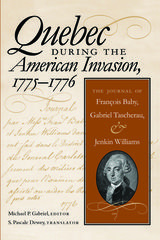 Quebec During the American Invasion, 1775-1776: The Journal of Francois Baby, Gabriel Taschereau, and Jenkin Williams
Michael P. Gabriel
Michigan State University Press, 2005 Available for the first time in English, the 1776 journal of François Baby, Gabriel Taschereau, and Jenkin Williams provides an insight into the failure to incite rebellion in Quebec by American revolutionaries. While other sources have shown how British soldiers and civilians and the French-Canadian gentry (the seigneurs) responded to the American invasion of 1775–1776, this journal focuses on French-Canadian peasants (les habitants) who made up the vast majority of the population; in other words, the journal helps explain why Quebec did not become the "fourteenth colony."
After American forces were expelled from Quebec in early 1776, the British governor, Sir Guy Carleton, sent three trusted envoys to discover who had collaborated with the rebels from the south. They traveled to fifty-six parishes and missions in the Quebec and Trois Rivières district, discharging disloyal militia officers and replacing them with faithful subjects. They prepared a report on each parish, revealing actions taken to support the Americans or the king. Baby and his colleagues documented a wide range of responses. Some habitants enlisted with the Americans; others supplied them with food, firewood, and transportation. Some habitants refused to cooperate with the king’s soldiers. In some parishes, women were the Americans’ most zealous supporters. Overall, the Baby Journal clearly reveals that the habitants played an important, but often overlooked, role in the American invasion.
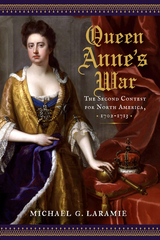 Queen Anne's War: The Second Contest for North America, 1702–1713
Michael G. Laramie
Westholme Publishing, 2021 Although King William’s War (1689–1697) had established the basic disputes between New France and the English colonies, the conflict had resolved little beyond making it clear that the smaller French colony was more than capable of defending itself. When news of the War of Spanish Succession (1701–1714), or Queen Anne’s War as it would become known in North America, arrived in 1702, few envisioned that the resumption of the previous conflict would grow to engulf eastern North America from Newfoundland to Florida, pitting the Spanish, English, and French colonies along with their respective native allies into a concerted contest for control of the continent. From the storming of Spanish St. Augustine and the opening shots along the Maine frontier, through the implementation of a series of profit-driven Indian Wars and the destruction of the Spanish mission system in Georgia and Florida, to the direct involvement of Britain in the closing days of the conflict, Queen Anne’s War: The Second Contest for North America, 1702–1713 carries the reader through this oft forgotten, but crucial period in North American history.
Told from the halls of power in North America and Europe, and through the eyes of the men and women who found themselves embroiled in this brutal realignment of colonial interests, Queen Anne’s War recreates the world of early North American expansion at the ground level, providing riveting accounts of the battles across settlements and wilderness as well as the motives, conditions, triumphs, and failures of the Europeans and their respective Native American allies. Based on extensive primary source research and command of English, French, and Spanish sources, the narrative not only describes the economic and geopolitical ramifications of the war that reshaped North America, but intriguingly reveals the sense of independence emerging in the colonies, from Puritan New England to plantation South Carolina, at the close of the war.
 Queen Elizabeth's Book of Oxford
Edited by Louise Durning
Bodleian Library Publishing, 2006 In 1566, Queen Elizabeth I visited Oxford for the first time. She toured the colleges, gave lectures, and attended a play in her honor at Christ Church. She was presented with a companion—a handbook made specifically for her and now fully reproduced as Queen Elizabeth's Book of Oxford. Newly translated, the book's Latin verse is written in a conversational tone as a lively discussion between the revered Queen and a knowledgeable guide. The volume also includes exquisite pen-and-ink drawings of Oxford's most famous buildings and an illuminating introduction by Louise Durning that places the text in its proper historical context. As Durning relates, Queen Elizabeth's Book of Oxford served several purposes, the most important of which was Oxford's interest in the Queen's potential patronage of a new college. Although Elizabeth never honored the request, she was eventually honored as the "founder" of Jesus College. Queen Elizabeth's Book of Oxford offers a glimpse into the process of patronage during the fifteenth and sixteenth centuries. It will be treasured by scholars of Elizabethan history as well as by anyone interested in the historical development of universities around the world.
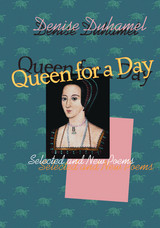 Queen for a Day: Selected and New Poems
Denise Duhamel
University of Pittsburgh Press, 2001 "Somewhere between Sex and the City, Sharon Olds and Spalding Grey lies the poetry of Denise Duhamel, who in six volumes during the 1990s (all from small independent or small university presses) established herself as a vivacious, sarcastic, uninhibited and sometimes sex-obsessed observer of contemporary culture. Long fascinated by downtown New York, Duhamel got poetic mileage from her once-rough neighborhoods. Now she lives and teaches in Miami: this new-and-selected sums up her NYC years . . . Its humor, anger and forceful personality could make the book a genuine popular hit." --Publishers Weekly
"Duhamel is an entertainer, as her new, retrospective collection confirms. . . . Throughout the book, each poem is utterly engaging, as hard to abandon as a chapter in a taut thriller." --Booklist
Celebrates ideas and topics that aren't often the subect of bards and poets. Her playful, inventive way of string together ideas is evident. . . . Despite the frolicsome nature of much of her work, Duhamel writes incisively about serious themes and issues. The clash between high and low art never seems abraisive in Duhamel's work." --Pittsburgh Tribune- Review
"Duhamel writes about Garcia-Lorca's Deli, Georgia O'Keefe's pelvis, a Barbie Doll in a Twelve-Step Program, Barbie as a Bisexual, Barbie's GYN appointment, and the difference between Pepsi and the Pope. . . . If you like knee-slapping, quasi-existential poetry, go out and pick up a Queen for a Day." --RALPH: The Review of Arts, Literature, Philosophy, and the Humanities
"Engagingly charts her evolution as a fictionist-from ribald, bemused poems about body parts and coming of age dramas to increasingly sophisticated mock-narratives. Her work is tremendous fun, but often there's an underpinning of sadness in it as well, which keeps the poems from being mere play. You'll want to read parts of this book aloud to your smart friends. Or to give it as a gift." --Stephen Dunn
"Denise Duhamel is a red-headed, red-lipped wild woman, a human and humane poet who isn't afraid to tackle any subject: violence, racism, A.I.D.S., bulimia, childishness, the myth of Bluebeard, the phenomenon of Barbie. It's been a singular joy to read this "selected" and see Duhamel's work grow and develop over the years. Queen for a Day is exuberant, brazen, bold, honest as hell, audaciously unpretentious and outrageously self-referential, a Frank O'Hara meets Lucille Ball meets Sandra Bernhard of a book: sin verguenza!" --Dorianne Laux
Denise Duhamel's Queen for a Day includes poems from her five previous full-length books (The Star-Spangled Banner, Kinky, Girl Soldier, The Woman with Two Vaginas, and Smile!) as well as her chapbook, How the Sky Fell. Her poems have been anthologized widely, including four editions of The Best American Poetry. Her work has been featured on NPR's "All Things Considered," MPR's "The Writers' Almanac," and PBS's "Fooling with Words." She has collaborated with the poet Maureen Seaton in two volumes: Oyl and Exquisite Politics. Duhamel is assistant professor at Florida International University in Miami.
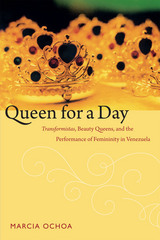 Queen for a Day: Transformistas, Beauty Queens, and the Performance of Femininity in Venezuela
Marcia Ochoa
Duke University Press, 2014 Queen for a Day connects the logic of Venezuelan modernity with the production of a national femininity. In this ethnography, Marcia Ochoa considers how femininities are produced, performed, and consumed in the mass-media spectacles of international beauty pageants, on the runways of the Miss Venezuela contest, on the well-traveled Caracas avenue where transgender women ( transformistas) project themselves into the urban imaginary, and on the bodies of both transformistas and beauty pageant contestants ( misses). Placing transformistas and misses in the same analytic frame enables Ochoa to delve deeply into complex questions of media and spectacle, gender and sexuality, race and class, and self-fashioning and identity in Venezuela. Beauty pageants play an outsized role in Venezuela. The country has won more international beauty contests than any other. The femininity performed by Venezuelan women in high-profile, widely viewed pageants defines a kind of national femininity. Ochoa argues that as transformistas and misses work to achieve the bodies, clothing and makeup styles, and postures and gestures of this national femininity, they come to embody Venezuelan modernity.
Queen in Blue
Ambalila Hemsell
University of Wisconsin Press, 2020 This gorgeous and wry debut firmly claims physical strength, toughness, and authority for femininity. Ambalila Hemsell’s poems speak from a place of empowerment as well as wonder. They address the insatiable fear of motherhood and the violence embedded in natural processes of creation, birth, and survival. Her words flicker and glow with magical realism, just as they reveal profound truths shared by the miraculous and the mundane. This lush and lyric collection artfully tackles what it means to reconcile one’s own needs and desires with those of others, and to find abundance and strength in the midst of catastrophe.
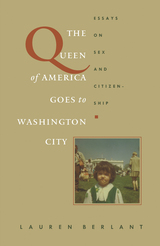 The Queen of America Goes to Washington City: Essays on Sex and Citizenship
Lauren Berlant
Duke University Press, 1997 In The Queen of America Goes to Washington City, Lauren Berlant focuses on the need to revitalize public life and political agency in the United States. Delivering a devastating critique of contemporary discourses of American citizenship, she addresses the triumph of the idea of private life over that of public life borne in the right-wing agenda of the Reagan revolution. By beaming light onto the idealized images and narratives about sex and citizenship that now dominate the U.S. public sphere, Berlant argues that the political public sphere has become an intimate public sphere. She asks why the contemporary ideal of citizenship is measured by personal and private acts and values rather than civic acts, and the ideal citizen has become one who, paradoxically, cannot yet act as a citizen—epitomized by the American child and the American fetus.
As Berlant traces the guiding images of U.S. citizenship through the process of privatization, she discusses the ideas of intimacy that have come to define national culture. From the fantasy of the American dream to the lessons of Forrest Gump, Lisa Simpson to Queer Nation, the reactionary culture of imperilled privilege to the testimony of Anita Hill, Berlant charts the landscape of American politics and culture. She examines the consequences of a shrinking and privatized concept of citizenship on increasing class, racial, sexual, and gender animosity and explores the contradictions of a conservative politics that maintains the sacredness of privacy, the virtue of the free market, and the immorality of state overregulation—except when it comes to issues of intimacy.
Drawing on literature, the law, and popular media, The Queen of America Goes to Washington City is a stunning and major statement about the nation and its citizens in an age of mass mediation. As it opens a critical space for new theory of agency, its narratives and gallery of images will challenge readers to rethink what it means to be American and to seek salvation in its promise.
 Queen of Navarre: Jeanne d’Albret, 1528–1572
Nancy Lyman Roelker
Harvard University Press This is the first biography in a hundred years of Jeanne d'Albret, a femme politique worthy of comparison with Elizabeth of England (her ally) and Catherine de Medici (her opponent) in a period when all the political and ideological currents of Reformation Europe converged in France. Her career as a feudal ruler in southwest France illustrates the changing relations between the high nobility and the crown, while her role as co-leader, with Coligny, of the Calvinist party at its height contributes to an understanding of the failure of the French Reformation. As the mother of Henry IV, she was responsible for the political education of France's most popular king, some of whose problems were inherited from her along with the models for some solutions.
The daughter of Marguerite de Navarre, Jeanne d'Albret experienced a dramatic series of crises which her uncompromising Calvinism and iron will enabled her to survive. In addition to the many unpublished letters included here, the author's insights into the character and motives of this unusual woman constitute one of the most enlightening aspects of her biography. Nancy Lyman Roelker's vivid style breathes life into a host of fascinating figures in an era in France richly colored by intrigue, war, and turbulent religious conflict.
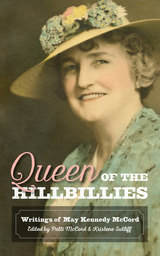 Queen of the Hillbillies: The Writings of May Kennedy McCord
Patti McCord
University of Arkansas Press, 2022 May Kennedy McCord, lovingly nicknamed “First Lady of the Ozarks” and “Queen of the Hillbillies,” spent half a century sharing the history, songs, and stories of her native Ozarks through newspaper columns, radio programs, and music festivals. Though her work made her one of the twentieth century’s preeminent folklorists, McCord was first and foremost an entertainer—at one time nearly as renowned as the hills she loved. Despite the encouragement of her contemporaries, McCord never published a collection of her work. In 1956, Vance Randolph wrote to her, “If you didn’t have such a mental block against writing books, I could show you how to make a book out of extracts from your columns. It would be very little work, and sell like hotcakes. . . . I could write a solemn little introduction, telling the citizens what a fine gal you are! The hell of it is, most of the readers know all about you.” In Queen of the Hillbillies, editors Patti McCord and Kristene Sutliff at last bring together the best of McCord’s published and previously unpublished writings to share her knowledge, humor, and inimitable spirit with a new generation of readers.
 The Queen's American Rangers
Donald J. Gara
Westholme Publishing, 2015 Founded by the Legendary Robert Rogers and Later Led by John Graves Simcoe, a Loyalist Unit that Fought Alongside the British Army Against the American Patriots
Prior to the British attack on Long Island in August 1776, French and Indian War hero Robert Rogers organized a regiment to join the fight—but not on the side of his native New Hampshire. Named in honor of Queen Charlotte, the wife of King George III, Rogers’s regiment recruited the bulk of its soldiers from the large number of Loyalist refugees on Staten Island who had fled from New York. Rogers’s command of the unit was short-lived, however, after a humiliating defeat in late October by a surprise attack on his headquarters. Under new leadership, the unit played a decisive role and suffered heavy casualties at the battle of Brandywine that brought them their first favorable attention from the British high command. With this performance, and under the able leadership of John Graves Simcoe, the Queen’s American Rangers—sometimes known as “Simcoe’s Rangers”—were frequently assigned to serve alongside British regular troops in many battles, including Monmouth, Springfield, Charleston, and Yorktown. Receiving frequent high praise from Lieutenant General Sir Henry Clinton, the Commander in Chief of the British Army in America, the unit was placed on the American Establishment of the British Army in May 1779, a status conferred on provincial units that had performed valuable services during the war, and was renamed the 1st American Regiment. Before the end of the war, the rangers were fully incorporated into the British regular army, one of only four Loyalist units to be so honored.
The Queen’s American Rangers by historian Donald J. Gara is the first book-length account of this storied unit. Based on extensive primary source research, the book traces the complete movements, command changes, and battle performances of the rangers, from their first muster to their formal incorporation into the British Army and ultimate emigration to Canada on land grants conferred by a grateful British crown.
Queens and Queenship
Elena Woodacre
Arc Humanities Press, 2021 This work looks at queenship in a global, timeless sense—examining the role of queens, empresses, and other royal women from the ancient and classical period through to nearly the present day on every continent. By looking at queenship in this comparative, longue durée way, we can start to see connecting threads and continuity over time and space as well as the change and development and comparisons of how the queen’s role differed in various cultural contexts. A wide variety of examples are given to explain and contextualize key themes in queenship: family and dynasty, rulership, and image crafting. The introduction provides a brief overview of the development of queenship studies and a discussion of the ideals that queens were expected to conform to. This book offers a radically new perspective on queenship studies which enables new insights into the queen’s role as the preeminent woman in the realm.
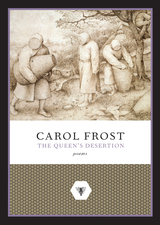 The Queen's Desertion: Poems
Carol Frost
Northwestern University Press, 2006 In her tenth collection of poems, Carol Frost describes a journey through loss. How can one regain equilibrium in the face of absences such as dementia and death? We have to keep moving, even while realizing that the loss of mind and body is the natural conclusion. At the beginning of the first poem Frost invokes the image of an empty or abandoned beehive:
Pretty to think of the mind at its end
as a metaphysician beekeeping
after the leaves have fallen at autumn's end.
The bee metaphor is handled brilliantly and subtly throughout the collection as a reminder of how often our constant activity, whether it is mental or physical, is taken for granted.
Frost continues her investigation of the mortal plight by entering into a Dantesque descent into the ebb and flow of the seascape. Body consumes body over and over again as fish are caught and killed and the poet observes the flora and fauna as they partake in the darker cycles of nature. A long narrative poem about the Spanish explorer de Baca and his harrowing travels from southern Florida to Mexico powerfully reinforces the certainty of consumption and loss as it comments on the colonizing of the new world. In the final section, Frost returns once more to the need for movement and summons the Greek god Pan, who dances a rite of acceptance through a metaphysical landscape on the verge of seasonal change--the bees are not dead, the dark woods are filled with music.
Queenship and Sanctity: The Lives of Mathilda and the Epitaph of Adelheid (Medieval Texts in Translation)
Sean Gilsdorf
Catholic University of America Press, 2004 Queenship and Sanctity brings together for the first time in English the anonymous Lives of Mathilda and Odilo of Cluny's Epitaph of Adelheid. Richly annotated, with an extensive introduction placing the texts and their subjects in historical and hagiographical context, it provides teachers and students with a crucial set of sources for the history of Europe (particularly Germany) in the tenth and eleventh centuries, for the development of sacred biography and medieval notions of sanctity, and for the life of aristocratic and royal women in the early Middle Ages.
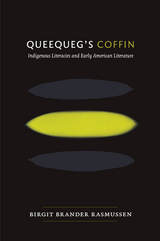 Queequeg's Coffin: Indigenous Literacies and Early American Literature
Birgit Brander Rasmussen
Duke University Press, 2012 The encounter between European and native peoples in the Americas is often portrayed as a conflict between literate civilization and illiterate savagery. That perception ignores the many indigenous forms of writing that were not alphabet-based, such as Mayan pictoglyphs, Iroquois wampum, Ojibwe birch-bark scrolls, and Incan quipus. Queequeg's Coffin offers a new definition of writing that comprehends the dazzling diversity of literature in the Americas before and after European arrivals. This groundbreaking study recovers previously overlooked moments of textual reciprocity in the colonial sphere, from a 1645 French-Haudenosaunee Peace Council to Herman Melville's youthful encounters with Polynesian hieroglyphics. By recovering the literatures and textual practices that were indigenous to the Americas, Birgit Brander Rasmussen reimagines the colonial conflict as one organized by alternative but equally rich forms of literacy. From central Mexico to the northeastern shores of North America, in the Andes and across the American continents, indigenous peoples and European newcomers engaged each other in dialogues about ways of writing and recording knowledge. In Queequeg's Coffin, such exchanges become the foundation for a new kind of early American literary studies.
 Queer about Comics
Darieck Scott and Ramzi Fawaz, special issue editors
Duke University Press, 2018 This special issue explores the intersection of queer theory and comics studies. The contributors provide new theories of how comics represent and reconceptualize queer sexuality, desire, intimacy, and eroticism, while also investigating how the comic strip, as a hand-drawn form, queers literary production and demands innovative methods of analysis from the fields of literary, visual, and cultural studies.
Contributors examine the relationships among reader, creator, and community across a range of comics production, including mainstream superhero comics, independent LGBTQ comics, and avant-garde and experimental feminist narratives. They also address queer forms of identification elicited by the classic X-Men character Rogue, the lesbian grassroots publishing networks that helped shape Alison Bechdel’s oeuvre, and the production of black queer fantasy in the Black Panther comic book series, among other topics.
Contributors andré carrington, Anthony Michael D’Agostino, Ramzi Fawaz, Margaret Galvan, Yetta Howard, Joshua Abraham Kopin, Kate McCullough, Darieck Scott, Jessica Q. Stark, Shelley Streeby, Rebecca Wanzo
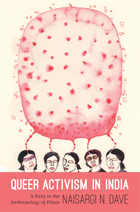 Queer Activism in India: A Story in the Anthropology of Ethics
Naisargi Dave
Duke University Press, 2012 In Queer Activism in India, Naisargi Dave examines the formation of lesbian communities in India from the 1980s to the early 2000s. Based on ethnographic fieldwork conducted with activist organizations in Delhi, a body of letters written by lesbian women, and research with lesbian communities and queer activist groups across the country, Dave studies the everyday practices that constitute queer activism in India.
Dave argues that activism is an ethical practice comprised of critique, invention, and relational practice. Her analysis investigates the relationship between the ethics of activism and the existing social norms and conditions from which activism emerges. Through her study of different networks and institutions, Dave documents how activism oscillates between the potential for new social arrangements and the questions that arise once the activists' goals have been accomplished. Dave's book addresses a relevant and timely phenomenon and makes an important contribution to the anthropology of queer communities, social movements, affect, and ethics.
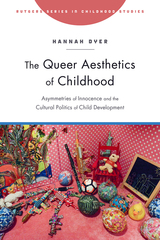 The Queer Aesthetics of Childhood: Asymmetries of Innocence and the Cultural Politics of Child Development
Hannah Dyer
Rutgers University Press, 2020 2020 Choice Outstanding Academic Title
In The Queer Aesthetics of Childhood, Hannah Dyer offers a study of how children’s art and art about childhood can forecast new models of social life that redistribute care, belonging, and political value. Dyer suggests that childhood’s cultural expressions offer insight into the persisting residues of colonial history, nation building, homophobia, and related violence. Drawing from queer and feminist theory, psychoanalysis, settler-colonial studies, and cultural studies, this book helps to explain how some theories of childhood can hurt children. Dyer’s analysis moves between diverse sites and scales, including photographs and an art installation, children’s drawings after experiencing war in Gaza, a novel about gay love and childhood trauma, and debates in sex-education. In the cultural formations of art, she finds new theories of childhood that attend to the knowledge, trauma, fortitude and experience that children might possess. In addressing aggressions against children, ambivalences towards child protection, and the vital contributions children make to transnational politics, she seeks new and queer theories of childhood.
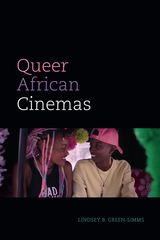 Queer African Cinemas
Lindsey B. Green-Simms
Duke University Press, 2022 In Queer African Cinemas, Lindsey B. Green-Simms examines films produced by and about queer Africans in the first two decades of the twenty-first century in an environment of increasing antiqueer violence, efforts to criminalize homosexuality, and other state-sanctioned homophobia. Green-Simms argues that these films not only record the fear, anxiety, and vulnerability many queer Africans experience; they highlight how queer African cinematic practices contribute to imagining new hopes and possibilities. Examining globally circulating international art films as well as popular melodramas made for local audiences, Green-Simms emphasizes that in these films queer resistance—contrary to traditional narratives about resistance that center overt and heroic struggle—is often practiced from a position of vulnerability. By reading queer films alongside discussions about censorship and audiences, Green-Simms renders queer African cinema as a rich visual archive that documents the difficulty of queer existence as well as the potentials for queer life-building and survival.
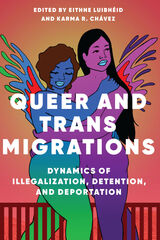 Queer and Trans Migrations: Dynamics of Illegalization, Detention, and Deportation
Edited by Eithne Luibheid and Karma R. Chavez
University of Illinois Press, 2020 More than a quarter of a million LGBTQ-identified migrants in the United States lack documentation and constantly risk detention and deportation. LGBTQ migrants around the world endure similarly precarious situations. Eithne Luibhéid's and Karma R. Chávez’s edited collection provides a first-of-its-kind look at LGBTQ migrants and communities. The academics, activists, and artists in the volume center illegalization, detention, and deportation in national and transnational contexts, and examine how migrants and allies negotiate, resist, refuse, and critique these processes. The works contribute to the fields of gender and sexuality studies, critical race and ethnic studies, borders and migration studies, and decolonial studies. Bridging voices and works from inside and outside of the academy, and international in scope, Queer and Trans Migrations illuminates new perspectives in the field of queer and trans migration studies.
Contributors: Andrew J. Brown, Julio Capó, Jr., Anna Carastathis, Jack Cáraves, Karma R. Chávez, Ryan Conrad, Elif, Katherine Fobear, Monisha Das Gupta, Jamila Hammami, Edward Ou Jin Lee, Leece Lee-Oliver, Eithne Luibhéid, Hana Masri, Yasmin Nair, Bamby Salcedo, Fadi Saleh, Rafael Ramirez Solórzano, José Guadalupe Herrera Soto, Myrto Tsilimpounidi, Suyapa Portillo Villeda, Sasha Wijeyeratne, Ruben Zecena
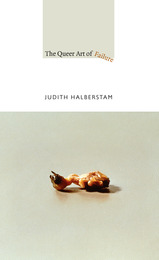 The Queer Art of Failure
Jack Halberstam
Duke University Press, 2011 The Queer Art of Failure is about finding alternatives—to conventional understandings of success in a heteronormative, capitalist society; to academic disciplines that confirm what is already known according to approved methods of knowing; and to cultural criticism that claims to break new ground but cleaves to conventional archives. Jack Halberstam proposes “low theory” as a mode of thinking and writing that operates at many different levels at once. Low theory is derived from eccentric archives. It runs the risk of not being taken seriously. It entails a willingness to fail and to lose one’s way, to pursue difficult questions about complicity, and to find counterintuitive forms of resistance. Tacking back and forth between high theory and low theory, high culture and low culture, Halberstam looks for the unexpected and subversive in popular culture, avant-garde performance, and queer art. Halberstam pays particular attention to animated children’s films, revealing narratives filled with unexpected encounters between the childish, the transformative, and the queer. Failure sometimes offers more creative, cooperative, and surprising ways of being in the world, even as it forces us to face the dark side of life, love, and libido.
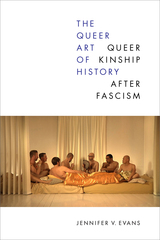 The Queer Art of History: Queer Kinship after Fascism
Jennifer V. Evans
Duke University Press, 2023 In The Queer Art of History Jennifer V. Evans examines postwar and contemporary German history to broadly argue for a practice of queer history that moves beyond bounded concepts and narratives of identity. Drawing on Black feminism, queer of color critique, and trans studies, Evans points out that although many rights for LGBTQI people have been gained in Germany, those rights have not been enjoyed equally. There remain fundamental struggles around whose bodies, behaviors, and communities belong. Evans uses kinship as an analytic category to identify the fraught and productive ways that Germans have confronted race, gender nonconformity, and sexuality in social movements, art, and everyday life. Evans shows how kinship illuminates the work of solidarity and intersectional organizing across difference and offers an openness to forms of contemporary and historical queerness that may escape the archive’s confines. Through forms of kinship, queer and trans people test out new possibilities for citizenship, love, and public and family life in postwar Germany in ways that question claims about liberal democracy, the social contract, and the place of identity in rights-based discourses.
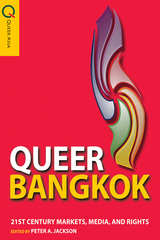 Queer Bangkok: 21st Century Markets, Media, and Rights
Edited by Peter A. Jackson
Hong Kong University Press, 2011 The Thai capital Bangkok is the unrivalled centre of the country’s gay, lesbian, and transgender communities. These communities are among the largest in Southeast Asia, and indeed in the world, and have a diversity, social presence, and historical depth that set them apart from the queer cultures of many neighbouring societies. The first years of the twenty-first century have marked a significant transition moment for all of Thailand’s LGBT cultures, with a multidimensional expansion in the geographical extent, media presence, economic importance, political impact, social standing, and cultural relevance of Thai queer communities. This book analyses the roles of the market and media — especially cinema and the Internet — in these transformations, and considers the ambiguous consequences that the growing commodification and mediatization of queer lives have had for LGBT rights in Thailand. A key finding is that in the early twenty-first century processes of global queering are leading to a growing Asianization of Bangkok’s queer cultures. This book traces Bangkok’s emergence as a central focus of an expanding regional network linking gay, lesbian, and transgender communities in Hong Kong, Singapore, Taiwan, Indonesia, the Philippines and other rapidly developing East and Southeast Asian societies.
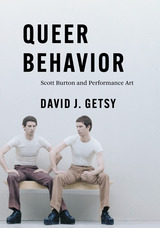 Queer Behavior: Scott Burton and Performance Art
David J. Getsy
University of Chicago Press, 2022 The first book to chart Scott Burton’s performance art and sculpture of the 1970s.
Scott Burton (1939–89) created performance art and sculpture that drew on queer experience and the sexual cultures that flourished in New York City in the 1970s. David J. Getsy argues that Burton looked to body language and queer behavior in public space—most importantly, street cruising—as foundations for rethinking the audiences and possibilities of art. This first book on the artist examines Burton’s underacknowledged contributions to performance art and how he made queer life central in them. Extending his performances about cruising, sexual signaling, and power dynamics throughout the decade, Burton also came to create functional sculptures that covertly signaled queerness by hiding in plain sight as furniture waiting to be used.
With research drawing from multiple archives and numerous interviews, Getsy charts Burton’s deep engagements with postminimalism, performance, feminism, behavioral psychology, design history, and queer culture. A restless and expansive artist, Burton transformed his commitment to gay liberation into a unique practice of performance, sculpture, and public art that aspired to be antielitist, embracing of differences, and open to all. Filled with stories of Burton’s life in New York’s art communities, Queer Behavior makes a case for Burton as one of the most significant out queer artists to emerge in the wake of the Stonewall uprising and offers rich accounts of queer art and performance art in the 1970s.
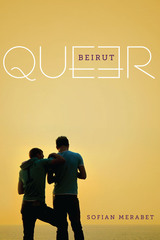 Queer Beirut
By Sofian Merabet
University of Texas Press, 2014 Gender and sexual identity formation is an ongoing anthropological conversation in both Middle Eastern studies and urban studies, but the story of gay and lesbian identity in the Middle East is only just beginning to be told. Queer Beirut is the first ethnographic study of queer lives in the Arab Middle East. Drawing on anthropology, urban studies, gender studies, queer studies, and sociocultural theory, Sofian Merabet’s compelling ethnography suggests a critical theory of gender and religious identity formations that will disrupt conventional anthropological premises about the contingent role that society and particular urban spaces have in facilitating the emergence of various subcultures within the city. From 1995 to 2014, Merabet made a series of ethnographic journeys to Lebanon, during which he interviewed numerous gay men in Beirut. Through their life stories, Merabet crafts moving ethnographic narratives and explores how Lebanese gays inhabit and perform their gender as they formulate their sense of identity. He also examines the notion of “queer space” in Beirut and the role that this city, its class and sectarian structure, its colonial history, and religion have played in these people’s discovery and exploration of their sexualities. In using Beirut as a microcosm for the complexities of homosexual relationships in contemporary Lebanon, Queer Beirut provides a critical standpoint from which to deepen our understandings of gender rights and citizenship in the structuring of social inequality within the larger context of the Middle East.
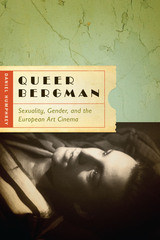 Queer Bergman: Sexuality, Gender, and the European Art Cinema
By Daniel Humphrey
University of Texas Press, 2013 One of the twentieth century’s most important filmmakers—indeed one of its most important and influential artists—Ingmar Bergman and his films have been examined from almost every possible perspective, including their remarkable portrayals of women and their searing dramatizations of gender dynamics. Curiously however, especially considering the Swedish filmmaker’s numerous and intriguing comments on the subject, no study has focused on the undeniably queer characteristics present throughout this nominally straight auteur’s body of work; indeed, they have barely been noted. Queer Bergman makes a bold and convincing argument that Ingmar Bergman’s work can best be thought of as profoundly queer in nature. Using persuasive historical evidence, including Bergman’s own on-the-record (though stubbornly ignored) remarks alluding to his own homosexual identifications, as well as the discourse of queer theory, Daniel Humphrey brings into focus the director’s radical denunciation of heteronormative values, his savage and darkly humorous deconstructions of gender roles, and his work’s trenchant, if also deeply conflicted, attacks on homophobically constructed forms of patriarchic authority. Adding an important chapter to the current discourse on GLBT/queer historiography, Humphrey also explores the unaddressed historical connections between post–World War II American queer culture and a concurrently vibrant European art cinema, proving that particular interrelationship to be as profound as the better documented associations between gay men and Hollywood musicals, queer spectators and the horror film, lesbians and gothic fiction, and others.
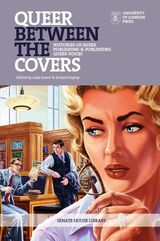 Queer Between the Covers: Histories of Queer Publishing and Publishing Queer Voices
Edited by Leila Kassir and Richard Espley
University of London Press, 2021 Queer Between the Covers presents a history of radical queer publishing and literature from 1880 to the modern day. Chronicling the gay struggle for acceptance and liberation, the book demonstrates how the fight for representation was often waged between the covers of books in a world where spaces for queer expression were taboo. The chapters provide an array of voices and histories from the famous, Derek Jarman and Oscar Wilde, to the lesser known and underappreciated, such as John Wieners and Valerie Taylor. It includes firsthand accounts of seminal moments in queer history, including the birth of Hazard Press and the Defend Gay’s the Word Bookshop campaign in the 1980s.
Queer Between the Covers demonstrates the importance of the book and how the queer community could be brought together through shared literature. The works discussed show the imaginative and radical ways in which queer texts have fought against censorship and repression and could be used as a political tool for organization and production. This study follows key moments in queer literary history, from the powerful community wide demonstrations for Gay’s the Word during their battle with the British government, to the mapping of Chicago’s queer spaces within Valerie Taylor’s pulp novels, or the anonymous but likely shared authorship of the nineteenth century queer text Teleny. Queer publishing also often involved fascinating creative tactics for beating the censor, from the act of self-publishing to anonymous authorship as part of a so-called “cloaked resistance.” Collage and repurposing found images and texts were key practices for many queer publishers and authors, from Derek Jarman to the artworks created by the Hazard Press.
This is a fascinating and topical book on publishing history for those interested in how queer people throughout modernity have used literature as an important forum for self-expression and self-actualization when spaces and sites for queer expression were outlawed.
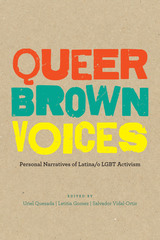 Queer Brown Voices: Personal Narratives of Latina/o LGBT Activism
Edited by Uriel Quesada, Letitia Gomez, and Salvador Vidal-Ortiz
University of Texas Press, 2015 In the last three decades of the twentieth century, LGBT Latinas/os faced several forms of discrimination. The greater Latino community did not often accept sexual minorities, and the mainstream LGBT movement expected everyone, regardless of their ethnic and racial background, to adhere to a specific set of priorities so as to accommodate a “unified” agenda. To disrupt the cycle of sexism, racism, and homophobia that they experienced, LGBT Latinas/os organized themselves on local, state, and national levels, forming communities in which they could fight for equal rights while simultaneously staying true to both their ethnic and sexual identities. Yet histories of LGBT activism in the 1970s, 1980s, and 1990s often reduce the role that Latinas/os played, resulting in misinformation, or ignore their work entirely, erasing them from history. Queer Brown Voices is the first book published to counter this trend, documenting the efforts of some of these LGBT Latina/o activists. Comprising essays and oral history interviews that present the experiences of fourteen activists across the United States and in Puerto Rico, the book offers a new perspective on the history of LGBT mobilization and activism. The activists discuss subjects that shed light not only on the organizations they helped to create and operate, but also on their broad-ranging experiences of being racialized and discriminated against, fighting for access to health care during the HIV/AIDS epidemic, and struggling for awareness.
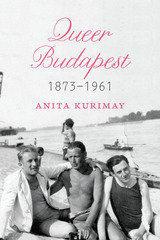 Queer Budapest, 1873–1961
Anita Kurimay
University of Chicago Press, 2020 By the dawn of the twentieth century, Budapest was a burgeoning cosmopolitan metropolis. Known at the time as the “Pearl of the Danube,” it boasted some of Europe’s most innovative architectural and cultural achievements, and its growing middle class was committed to advancing the city’s liberal politics and making it an intellectual and commercial crossroads between East and West. In addition, as historian Anita Kurimay reveals, fin-de-siècle Budapest was also famous for its boisterous public sexual culture, including a robust gay subculture. Queer Budapest is the riveting story of nonnormative sexualities in Hungary as they were understood, experienced, and policed between the birth of the capital as a unified metropolis in 1873 and the decriminalization of male homosexual acts in 1961.
Kurimay explores how and why a series of illiberal Hungarian regimes came to regulate but also tolerate and protect queer life. She also explains how the precarious coexistence between the illiberal state and queer community ended abruptly at the close of World War II. A stunning reappraisal of sexuality’s political implications, Queer Budapest recuperates queer communities as an integral part of Hungary’s—and Europe’s—modern incarnation.
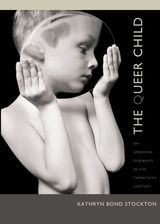 The Queer Child, or Growing Sideways in the Twentieth Century
Kathryn Bond Stockton
Duke University Press, 2009 Children are thoroughly, shockingly queer, as Kathryn Bond Stockton explains in The Queer Child, where she examines children’s strangeness, even some children’s subliminal “gayness,” in the twentieth century. Estranging, broadening, darkening forms of children emerge as this book illuminates the child queered by innocence, the child queered by color, the child queered by Freud, the child queered by money, and the grown homosexual metaphorically seen as a child (or as an animal), alongside the gay child. What might the notion of a “gay” child do to conceptions of the child? How might it outline the pain, closets, emotional labors, sexual motives, and sideways movements that attend all children, however we deny it? Engaging and challenging the work of sociologists, legal theorists, and historians, Stockton coins the term “growing sideways” to describe ways of growing that defy the usual sense of growing “up” in a linear trajectory toward full stature, marriage, reproduction, and the relinquishing of childish ways. Growing sideways is a mode of irregular growth involving odd lingerings, wayward paths, and fertile delays. Contending that children’s queerness is rendered and explored best in fictional forms, including literature, film, and television, Stockton offers dazzling readings of works ranging from novels by Henry James, Radclyffe Hall, Virginia Woolf, Djuna Barnes, and Vladimir Nabokov to the movies Guess Who’s Coming to Dinner, The Hanging Garden, Heavenly Creatures, Hoop Dreams, and the 2005 remake of Willy Wonka and the Chocolate Factory. The result is a fascinating look at children’s masochism, their interactions with pedophiles and animals, their unfathomable, hazy motives (leading them at times into sex, seduction, delinquency, and murder), their interracial appetites, and their love of consumption and destruction through the alluring economy of candy.
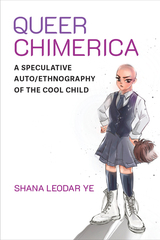 Queer Chimerica: A Speculative Auto/Ethnography of the Cool Child
Shana Ye
University of Michigan Press, 2024 Blending archival work, ethnography, and cultural analysis with memoir, graphic arts, and science fiction, Queer Chimerica unpacks the ways in which the transnational circulation of queer culture, politics, and institutions are structured through the antagonist interdependence of China and the United States. By examining the intersecting timelines of the rise of queer theory and the rise of China in the late Cold War era, Shana Ye explores the relationship between the discourse of queer fluidity and capital’s demands for labor flexibility.
Drawing on rare archival material and oral historical accounts of queer life from the 1950s to the late 2010s, the author shows how these accounts make sense of the variegated landscapes of desires, transformations, and conundrums in postsocialist China. The author illustrates party cadres in the Cultural Revolution, tongzhi activism mediated by the explosive politics of Tiananmen upheaval, HIV/AIDS community outreach workers, feminist artists and digital activists, leftist queer theorists, and fictional bio-engineers, layering these vivid depictions to reveal the poetic messiness of queer world-making. Queer Chimerica offers insight into the governmentality of LGBT rights, the rules of legibility and recognition, the geo- and bio-politics of identity, and the class-ridden appropriation of queer history and community. Thus understanding the production of queerness unveils the uneven distributions of capital, knowledge, affect, and opportunity that reproduce queer precarity and agency.
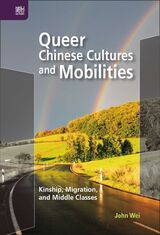 Queer Chinese Cultures and Mobilities: Kinship, Migration, and Middle Classes
John Wei
Hong Kong University Press, 2020 In Queer Chinese Cultures and Mobilities, John Wei brings light to the germination and movements of queer cultures and social practices in today’s China and Sinophone Asia. While many scholars attribute China’s emergent queer cultures to the neoliberal turn and the global political landscape, Wei refuses to take these assumptions for granted. He finds that the values and pitfalls of the development-induced mobilities and post-development syndromes have conjointly structured and sustained people’s ongoing longings and sufferings under the dual pressure of compulsory familism and compulsory development. While young gay men are increasingly mobilized in their decision-making to pursue sociocultural and socioeconomic capital to afford a queer life, the ubiquitous and compulsory mobilities have significantly reshaped and redefined today’s queer kinship structure, transnational cultural network, and social stratification in China and capitalist Asia. With Queer Chinese Cultures and Mobilities, Wei interrogates the meanings and functions of mobilities at the forefront of China’s internal transformation and international expansion for its great dream of revival, when gender and sexuality have become increasingly mobilized with geographical, cultural, and social class migrations and mobilizations beyond traditional and conventional frameworks, categories, and boundaries.
Queer Cinema in Europe
Edited by Robin Griffiths
Intellect Books, 2008 Queer cinema has gained scholarly attention in recent years as a manifestation of the conflicts, anxieties, and liberation of European sexuality. Robin Griffiths’ Queer Cinema in Europe, the first anthology of its kind, probes the questions and implications of sex, gender, and identity in contemporary European filmmaking. An esteemed group of contributors discuss the varieties of lesbian and gay representation to deconstruct and redefine notions of national identity and culture in a diverse European context. This volume explores a wide scope of films, directors, and genres to forge a new understanding of what it means to be queer in the twenty-first century.
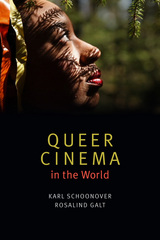 Queer Cinema in the World
Karl Schoonover and Rosalind Galt
Duke University Press, 2016 Proposing a radical vision of cinema's queer globalism, Karl Schoonover and Rosalind Galt explore how queer filmmaking intersects with international sexual cultures, geopolitics, and aesthetics to disrupt dominant modes of world making. Whether in its exploration of queer cinematic temporality, the paradox of the queer popular, or the deviant ecologies of the queer pastoral, Schoonover and Galt reimagine the scope of queer film studies. The authors move beyond the gay art cinema canon to consider a broad range of films from Chinese lesbian drama and Swedish genderqueer documentary to Bangladeshi melodrama and Bolivian activist video. Schoonover and Galt make a case for the centrality of queerness in cinema and trace how queer cinema circulates around the globe–institutionally via film festivals, online consumption, and human rights campaigns, but also affectively in the production of a queer sensorium. In this account, cinema creates a uniquely potent mode of queer worldliness, one that disrupts normative ways of being in the world and forges revised modes of belonging.
 The Queer Commons
Gavin Butt and Nadja Millner-Larsen, special issue editors
Duke University Press, 2018 The conventional idea of the commons—a resource managed by the community that uses it—might appear anachronistic as global capitalism attempts to privatize and commodify social life. Against these trends, contemporary queer energies have been directed toward commons-forming initiatives from activist provision of social services to the maintenance of networks around queer art, protest, public sex, and bar cultures that sustain queer lives otherwise marginalized by heteronormative society and mainstream LGBTQ politics. This issue forges a connection between the common and the queer, asking how the category “queer” might open up a discourse that has emerged as one of the most important challenges to contemporary neoliberalization at both the theoretical and practical level.
Contributors look to radical networks of care, sex, and activism present within diverse queer communities including HIV/AIDS organizing, the Wages for Housework movement, New York’s Clit Club community, and trans/queer collectives in San Francisco. The issue also includes a dossier of shorter contributions that offer speculative provocations about the radicalism of queer commonality across time and space, from Gezi Park uprisings in Turkey to future visions of collectivity outside of the internet.
Contributors
Arlen Austin, Zach Blas, Gavin Butt, Beth Capper, Ashon Crawley, Amalle Dublon, Macarena Gomez-Barris, Christina Hanhardt, Diarmuid Hester, Nadja Millner-Larsen, José Esteban Muñoz, Cenk Ozbay, Evren Savci, Eric Stanley
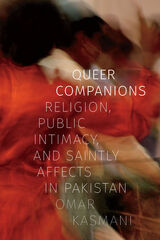 Queer Companions: Religion, Public Intimacy, and Saintly Affects in Pakistan
Omar Kasmani
Duke University Press, 2022 In Queer Companions Omar Kasmani theorizes saintly intimacy and the construction of queer social relations at Pakistan’s most important site of Sufi pilgrimage. Conjoining queer theory and the anthropology of Islam, Kasmani outlines the felt and enfleshed ways in which saintly affections bind individuals, society, and the state in Pakistan through a public architecture of intimacy. Islamic saints become lovers and queer companions just as a religious universe is made valuable to critical and queer forms of thinking. Focusing on the lives of ascetics known as fakirs in Pakistan, Kasmani shows how the affective bonds with the place’s patron saint, a thirteenth-century antinomian mystic, foster unstraight modes of living in the present. In a national context where religious shrines are entangled in the state’s infrastructures of governance, coming close to saints further entails a drawing near to more-than-official histories and public forms of affect. Through various fakir life stories, Kasmani contends that this intimacy offers a form of queer world making with saints.
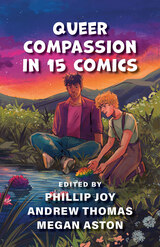 Queer Compassion in 15 Comics
Edited by Phillip Joy, Andrew Thomas, and Megan Aston
Lever Press, 2024 This unique comic anthology takes its readers on a journey through different art styles and queer perspectives, from first Prides to multi-generational friendships to finding community among chosen families. The comics in Queer Compassion offer kaleidoscopic insight into the colorful, heartbreaking, empowering, funny, and diverse lives of queer people around the world by centering compassion as a way to inhabit and build community.
These comics are created by queer artists for queer audiences and with the intent for queer self-expression and representation. Social science researchers spoke to diverse members of LGBTQ+ communities to explore their beliefs about and experiences of compassion. Fifteen queer comics were commissioned to illustrate those stories, making the process of creating each comic a unique collaboration between researchers and artists, blending data exploring the meanings of compassion for queer folks with the creativity, passion, and understanding of a queer comic artist.
These stories reflect not only the harsh realities that many queer people face but they also uplift queer voices, illustrate strength, and capture queer resolve to make life more compassionate. Queer people, living in a cis-heteronormative world, often face experiences of marginalization, discrimination, stigma, trauma, and invisibility in everyday life. Queer Compassion shows that its titular emotion can be the bridge that brings understanding and creates community connections — a bridge that is particularly needed at this time.
|
|
